- Home
- Collections
- HOLLYWOOD G
- The Scindian
- Scindian 1974
Scindian 1974
Page 1
Napier Boys’ High School
Editorial
Several attempts have been made at this editorial which have been either very brash and loud or so soft as to be inaudible.
I was asked at the last minute to write this, to speak about our school on behalf of our magazine.
“A” block has fallen – which at first may not be obvious as the rubble has a certain semblance to its mould. However, it must be noted with some pride, that during the destruction, a high level of academic and cultural standard was maintained – standards which can but bring credit to this school.
A true test of a school is if it can continue operating while seriously being disrupted. This year has had to endure exceptional difficulties. Construction work has been going on continuously, making movement between classes, teaching, and the general appearance of the school, difficult to maintain. The school student body must be congratulated in coping with these uncomfortable conditions, and the keeping up of traditional standards is surely evidence of perseverance and pride.
Groups worthy of mention for their activities during the year:
The Pipe Band and the Orchestra for their musical adventures, and of course the Maori Club and their historic ‘‘mainland”’ excursion.
Sports teams maintained their high standard, particularly the Hockey team (winning the Founders’ Cup). No Rugby team was outstanding, but the overall standard and attitude was high.
On the Academic side the smaller seventh form has led to increased (but strongly denied) competition. It would be too forward at present to announce our dux, but we all know him so I will not “hassel” around.
Last year’s Seventh achieved a high number of both A and B Bursaries, so even if considered corrupt, they were not ignorant!
One of this year’s Seventh who is no longer with us, however not dead, and who lent four years service to this magazine and was elected a N.Z. Hockey Ref was Ian MacRae, ex-Scindian Editor. He left us in our primitive stages this year, but we don’t hold it against you, Ian.
A topic you may or may not want to discuss in roaring whispers is student apathy.
It is a student bandwagon and an excuse for not caring. It may be defined as a self- defeating circulatory argument which would, without being hypocritical, be pointless to discuss here.
The Scindian has recovered from its slow, downward, trend, and is on the road to recovery, despite the odd lapse, but we are elated to be getting an issue out at all.
What all this indicates is that the school is not just a heap of brick and mortar, but that the people make the school and that NBHS is not dead yet.
M. GREEN.
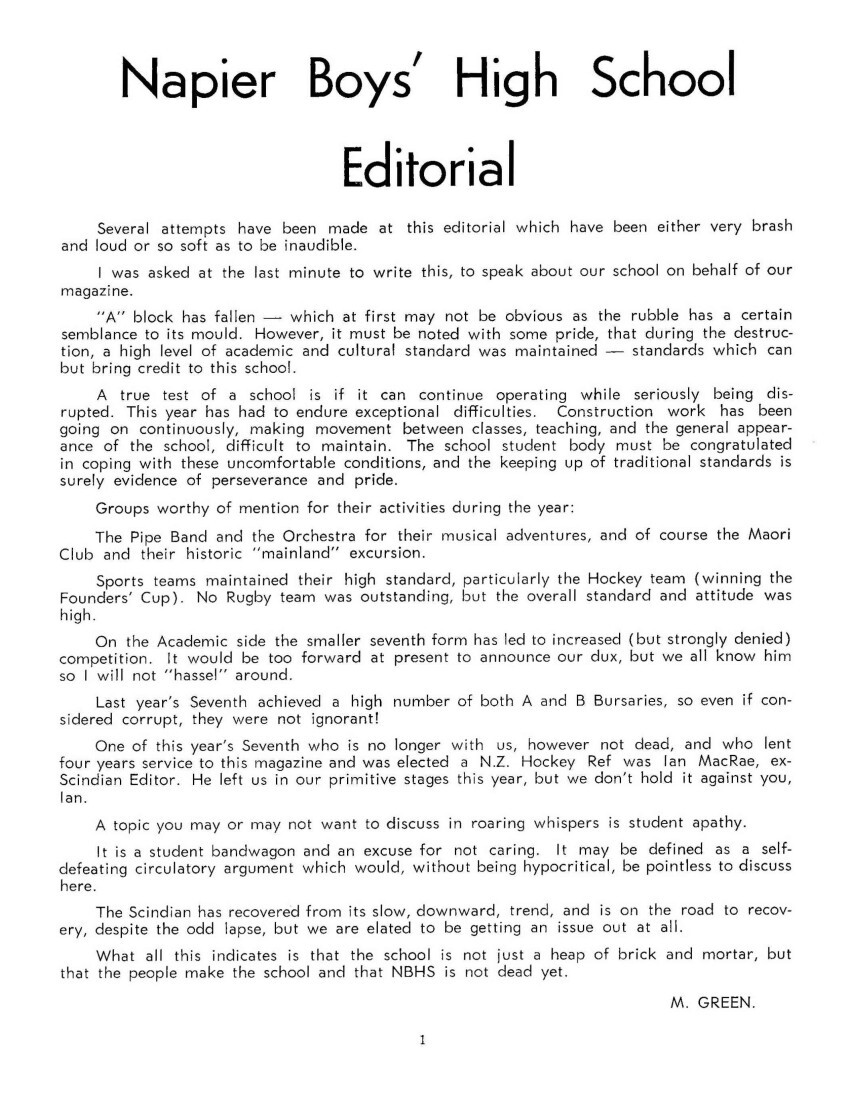
Page 2
BOARD OF GOVERNORS
Chairman: Mrs D. R. LUCAS, B.Sc. (Econ. Hon. Lond.)
Mrs J. DAVIES
Mrs M. A. HIGGINS
Mrs M. E. JOHNSON, B.Ag.
Mr R. LEE
Mr B. A. O. MARSHALL, B.Arch. (N.Z.), A.N.Z.I.A.
Mr H. R. MATTHEWS
Mr W. NUTTALL
Mr F. PRICE
Mr J. W. TAIT
Mr C. P. THOMSEN
Mr G. L. WOOD
Secretary and Treasurer:
T. H. JOHNSON, A.C.A. J.P.
P.O. Box 377, Napier.
Principal:
D. P. CAIRD, B.A., Dip.Ed.
Deputy-Principal
J. N. CARADUS, M.Sc.
TEACHING STAFF
F. B. ALDOUS, A.C.A.
P. J. BERRY, T.T.C.
D. BEUTH, M.Sc.
M. A. BOYCE
O. H. BROWN, M.A.
Mrs D. P. CAIRD, B.A.
W. T. CARPENTER, B.A., Dip.Ed.
T. A. CHALMERS, T.T.C. Adv. Trades Cert.
G. H. CLIBBORN, T.T.C. Adv. Trades Cert.
R. B. CURHAM, B.A.
R. H. ELLIS, M.A.
J. R. FRY, B.Sc.
Mrs L. GEOR, M.I.P.S., A.T.C.L., A.S.V.N.Z.
R. B. GOURLEY, B.Sc.
A. T. HOWLETT, B.A., Dip.Ed. (Mus).
P. HUNT
D. J. HUTCHINSON, C & G., T.C.
G. LANKOW, Adv. Trades Cert.
R. J. LEFT, BFA.
M. J. A. LISTER, M.A.
J. E. LLOYD, 1st C.I. Marine Cert.
R. D. J. McCAW, B.Sc. (Hons)
I. A. McINTOSH, B.Sc.
N. MacLEOD, T.T.C., Adv. Trades Cert.
M. D. MEAR, M.A. (Hons)
D. MONRAD, T.T.C.
C. NICOL, T.T.C.
Miss J. M. O’BRIEN, P.C.T., F.L.P.S., F.S.C.T.
B. G. O’CONNOR, B.A., Dip.Ed. Dip.Geog.
Miss A. M. O’DONNELL, B.A. K.
R. PAGE, B.Sc. (Hons)
D. A. PAXIE, B.A.
J. W., PITTS, B.Sc. (Hons)
P. I. RANKIN, M.A. Dip.Tchg.
D. G. REVELL, B.A., Dip.Ed.
Miss C. G. SCHON, B.A.
D. G. SEATON
A. J. SHEAT
Mrs D. SHEPPARD, T.T.C.
C. F. SMITH, T.T.C., Double Adv. T.C.
D. J. SORENSEN, Adv. Trades Cert.
R. J. STEPHENS, P.H.A., P.H. Phys.Ed.
G. P. WALKER, B.Sc.
P. F. WILLIAMS, Mus.B., L.R.S.M., L.T.C.L.
Miss U. WILSON, T.T.C.
J. W. E. YOUNG, R.E.A., M.N.I.E.T.
Visiting Music Teachers
Mrs A. WILSON, L.R.S.M.
Mrs B. DINE, L.R.S.M.
Mrs A. NORRIS, L.R.A.M.
Mr P. WILKINSON, L.R.S.M.
Mrs E. HOCKING
Mr C. WIGGINS
Mr R. G. ALLEN
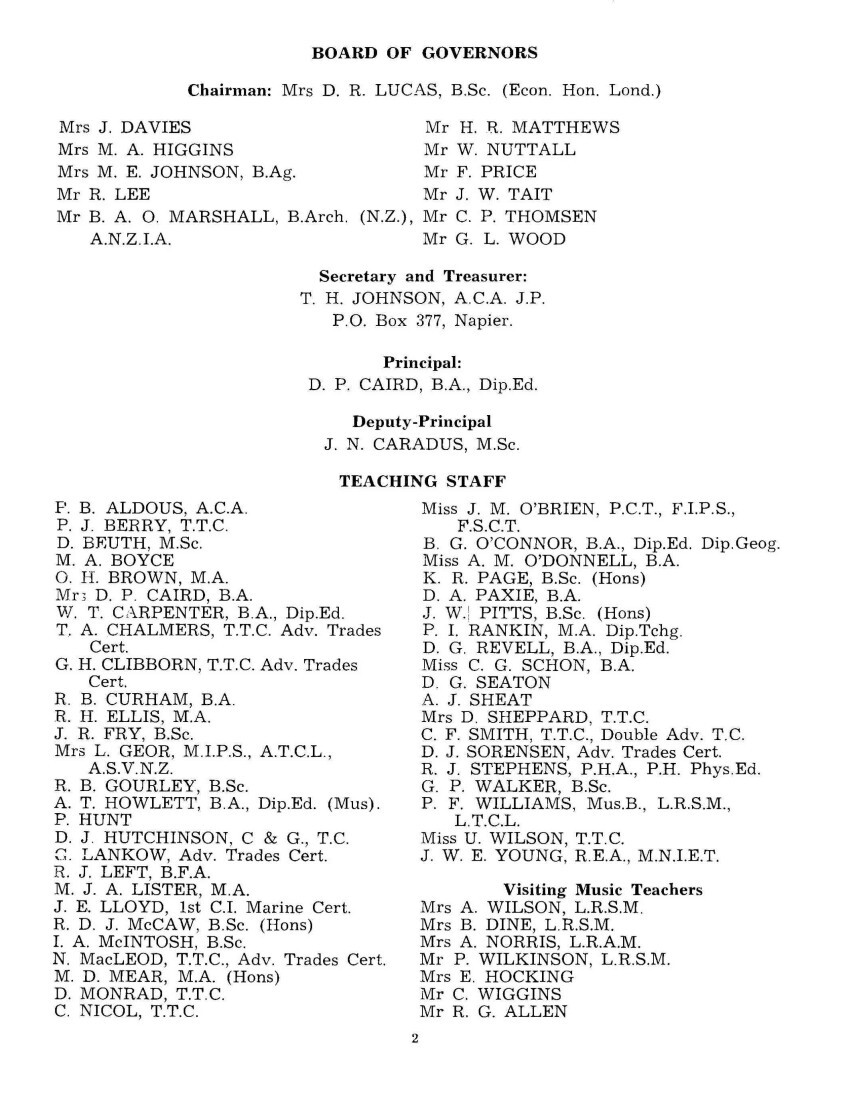
Page 3
Secretary to the Principal:
Miss J. L. STEVENS
Assistant Secretaries:
Mrs J. HINDMARSH, Mrs H. WYETH
Library Assistants:
Mrs H. HEATH, MRS B. WRIGHT
Bookroom:
Mrs P. WHITE
Laboratory Technician:
Mr H. ANSUS
Groundsman: Mr J. WINSTANLEY
Mr R. GOELDNER
Caretaker:
Mr C. GINDERS
HEADMASTER’S REPORT 1973
Madam Chairman, Your Worship the Mayor and Mrs Tait, Ladies and Gentlemen.
The School has been successfully launched on its second century. I hope that this will be clearly evident as this report unfolds.
At the beginning of 1973 we welcomed to our Staff Mr P. Aldous, A. C. A. Commercial subjects; Mr T. A. Chalmers, Advanced Trade Certificate, Carpentry Apprentices Instructor; Mr R. B. Curham, B.A., who has returned to us after several years teaching experience in other countries; Miss G. Jenkins, M.I.P.S., A.T.C.L., A.S.B.N.Z, Secretarial Course tutor; Mr M. D. Mear, MA, Geography; Mr K. R. Page. B.Sc., Dip. Ed. Mathematics; Mr P. White, B.Sc., Chemistry; Mr M. Boyce, Engineering and Mr J. R. Fry, B.Sc. Mathematics.
We are grateful to Mr C. Coates and Mr N. Smith who have held short term relieving positions as teachers of physical education. Despite his intentions to be overseas for two years, Mr Ellis returned to the fold early in October – we welcome him back.
During the year Mr M. J. Shirley and Mr R. M. D. Harris left, and at this year’s end we have to say farewell to the following: Mr J. Beardsell, B.A., who joined the Staff in 1966 and quickly proved himself a teacher of English with a deep knowledge of films, drama and music. Mr G. Ford, B.A., who also joined the Staff in 1966 and had to assume as a very young teacher, the responsibility for teaching French in the School: he also taught senior English and for the past three years was Master in Charge of “Scindian”. Both Mr Beardsell and Mr Ford have given considerable and valuable service as Housemasters in Scinde House. We are also sorry to lose yet another housemaster and a valued chemistry teacher in the person of Mr White. Although he has been with us for only one year he has made a firm impression and we hope that after a period of overseas travel he will return to our Staff. Mr Tangiiti who has been almost two years as a supernumery teacher in the Technical Department, and who has also been a housemaster, is going to teach in the Cook Islands. Islands.
Although he returned to us just twelve months ago, Mr Roberts has decided to transfer permanently to the North Auckland area where he hopes to mix teaching with his strong desire to paint.
We thank all those teachers for allowing our School to benefit from their special knowledge and skills and for their enthusiasm and their loyalty. We wish them well in the future.
Once again, as the result of examination successes in 1972 we found our Sixth and Seventh Forms to be of not only significant size but also of a wide breadth of interests. It is obvious that our courses at Sixth Form level attract a large number of pupils who wish to gain awards at either Sixth Form Certificate level or Technicians Certification level in subjects which are not in the University Entrance Prescription. This enables them to broaden their practical as well as their academic knowledge and prepares them well to continue their education at Polytechnic level.
I mentioned at this time last year that many more boys were participating in sporting and cultural activities. This year it is evident that in addition to quantity of participants that there is quality. Our sporting teams have performed meritoriously in inter-school fixtures and individuals have been selected for their province. Perhaps the most successful individual being Mark Romans who gained his Hawke’s Bay Senior Rugby blazer. However, there have been many others and they all deserve high commendation.
School activities have been many and varied and I shall briefly mention only a few. The highlight of the year for one group of students led by Miss Schon and Mr Ford, would be the trip to New Caledonia. They gained an insight into a different way of life, predominantly that of metropolitan France, and at the same time gained a greater mastery of the spoken French language.
Another very active group was the Combined Boys’ and Girls’ High Schools Maori Culture Club. Their activities culminated in presenting performances over Labour Weekend at Palmerston North, Petone and Wellington. They were among 5000 people billeted at Petone for the Hui Aotearoa, and they were chosen to perform at the “Honours Dinner’.
This year we were hosts to the Palmerston North Boys’ High School who sent over 700 boys

Page 4
and staff to invade the School to participate in a wide range of activities including Orchestra, Brass band, Debating, Chess, Badminton, Table Tennis, Indoor Basbetball [Basketball], Hockey, Soccer, Rugby and Volley Ball.
The Inter-Act Club has maintained the well-established pattern of interest in the School and Community projects. This year sufficient funds have been provided for a new Inter-Act Bar to be in use in 1974. Also a tree planting project was carried out in the area surrounding Colenso Memorial Plinth at Waitangi.
The building of the S68 Block has commenced, but owing to difficulties over materials it is currently making very slow progress. Work has started on a new Art Suite adjacent to “C” Block. The Staff and Headmaster hope that the plans for the new Administration Block will be expedited so that a move can be made directly to it rather than to temporary accommodation when “A” Block is demolished.
We are all delighted to have the Swimming Pool fully functional after many years of frustration. We are now able to conduct learn-to-swim classes as well as increasing the number of pupils receiving instruction for the Life-Saving Awards.
There is no doubt that the Hawke’s Bay Polytechnic Institute will be established by 1975. This School has played a major part in building up classes to support such an institute. In 1974 we shall provide instruction for over 185 Carpentry Apprentices, over 35 Secretarial Students, 80 Ladies Hairdressing Apprentices, 60 Fitters and Turners, as well as the customary Evening classes, etc., until a Principal is appointed and sufficient buildings become available to accommodate the classes for the Institute.
One can never state how fully the School appreciates the efforts of the Parents’ League for their assistance in supplementing the material needs of the School and the splendid catering provided by the Ladies Committee at School functions.
We are also fortunate in that we have a hardworking and understanding Board of Governors which is so ably chaired by Mrs Lucas. With knowledge of this support from Parents and Board the Staff goes about its work with confidence.
The Staffing of the School is at full strength and all departments are now able to expand and to develop their educational aims. The Tutor-Dean system is settling down well. We have conducted some research into a systems approach to internal assessment in depth as well as the keeping of School records. Next year this will be one of fifteen schools piloting a Project Physics Course at Sixth Form level.
We are living in an age of rapid change and this School is trying to keep up with worthwhile developments. We hope that we have given our pupils the best possible opportunities to develop as human beings and we hope that the training we have given them will stand them in good stead, come what may, in the future.
D. P. CAIRD,
Headmaster,
SCHOOL RESPONSIBILITIES
Prefects: J. Beaton, S. J. Borrie, P. J. Caradus, V. T. Chadwick (head), R. B. Danks, R. W. Double, J. W. DuFour, P. C. Fleischl, N. D. Groom, P. L. Hazell, D. J. Herrick, C. A. MacErlich, I. C. McRae (deputy-head), J. F. Marsden, D. J. Muggeridge, J. Murphy, D. W. Pearson, R. G. Prebble, C. P. Riden, L. J. Sheppard, W. D. G. Smith, R. J. Sutherland (deputy-head), D. W .Thomas, D. A. Whyte.
Scinde House Prefects: S. J. Borrie, J. R. Gorringe, G. D. Lawrence, C. A. McLay, D. J. Muggeridge (head), S. N. Muggeridge, W. D. G. Smith, D. A. Whyte.
House Captains: Clyde: I. C. McRae; Hawke: C. A. MacErlich; Scinde: D. J. Muggeridge; Napier: R. B. Danks.
Library: Librarian: Mr A. T. Howlett; Assistant Librarians: Mrs M. Heath, Mrs B. Wright.
I.S.C.F.: Master in Charge: Mr P. F. Williams; Leader: Mr Yeoman; Junior Leader: A. T. Arnold.
Debating Club: Master in Charge: Mr G. B. O’Connor; President: R. L. Hellyer; Secretary: P. L. Hazell;
Junior Debating Mistress: Miss C. G. Schon.
Interact Club: Master in Charge: Mr O. H. Brown; President: J. W. Du Four; Secretary: P. L. Hazell; Treasurer: D. C. Lawlor.
Maori Culture Club: Master in Charge: Mr M. D. Mear; Instructors: Mrs Keefe and Mr Coulter; Leader: N. I. Bullock.
Tramping Club: Master in Charge: Mr O. H. Brown.
Boarders’ Social Club: President: D. A. Whyte; Secretary: J. R. Gorringe; Treasurer: K. P. McLeod.
Brass Band: Master in Charge: Mr P. F. Williams.
Orchestra: Master in Charge: Mr P. F. Williams.
Pipe Band: Master in Charge: Mr N. MacLeod.
Rugby Football: Master in Charge: Mr D. G. Seaton; Captain of First XV: V. T. Chadwick.
Association Football: Master in Charge: Mr J. W. Pitts; Captain of First XI: B. G. Heavey.
Hockey: Master in Charge: Mr C. V. Nichol; Captain of First XI: I. C. McRae.
Indoor Basketball: Master in Charge: Mr K. R. Page; Captain: R. D. Pearse.
Cricket: Master in Charge: Mr D. Beuth; Captain of First XI: D. W. Pearson.
Softball: Master in Charge: Mr D. A. Paxie; Captain: R. Ruru.
Tennis: Master in Charge: Mr M. J. A. Lister; Captain: J. Beaton.
Athletics: Master in Charge: Mr M. D. Mear; Captain: V. T. Chadwick.
Life Saving: Master in Charge: Mr D. A. Paxie; Captain: S. Walker.
Swimming: Master in Charge: Mr D. A. Paxie; Captain: J. F. Marsden.
Scindian Committee: Managers: Mr R. Curham, Mr G. O’Connor, Mr R. Left. Editor: D. Brian, Assistants: K. Callinicos, G. Collins, R. Hellyer and J. Hill.
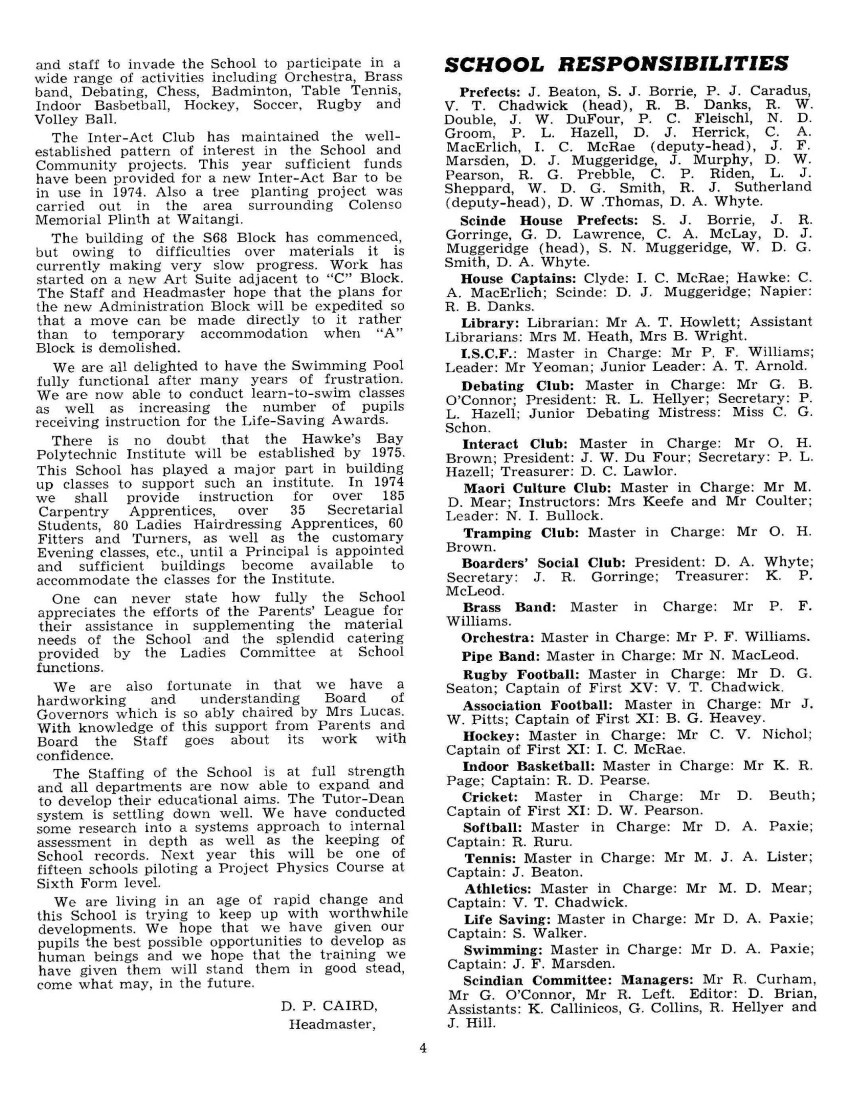
Page 5
SCHOOL DIARY
FEBRUARY:
4 – School commenced.
8 – Tabloid Swimming Sports.
15 – Swimming Sports Finals
26 – Tabloid Athletics
MARCH:
4-5 – V. Gisborne: Cricket and tennis.
8 – Finals of Athletics.
25-26 – v. Palmerston North Boys’ High School: Cricket and tennis.
28-29 – Education Seminar.
APRIL:
18 – Mr I. McLean – Liaison Officer, Massey University.
23 – Mr G. M. Ryan – Metric Co-ordinating Officer.
MAY:
5-8 – Scots College, Sydney: Rugby, some staff and parents.
10 – End of term.
15 – College Day: Rugby games held at McLean Park.
27-Second Term begins.
JUNE:
14 – Messrs Vedder and Rowland from Gideon Organisation.
25 – Minister of Education, Mr Amos visits school.
26 – 1st XV lost to Hastings Boys’ High School.
JULY:
3 – Annual fixtures with Gisborne.
5 – School Prefects held dance for Third and Fourth Forms.
11 – School closed: staff discussions on curriculum.
17-18 – Project Physics In-Service Course.
18 – Parents Evening – meet the staff.
24 – Annual fixtures with Wairarapa.
26 – Senior Dance held at Old Boys’ Gym.
AUGUST:
3 – Ruari McNeill, Otaki Scholar, visits school.
6 – Mr Arthur Lydiard spoke at Assembly about Sport.
7 – Mr P. Misiga, Education Officer from Soloman [Solomon] Islands inspects Agricultural Course and facilities.
8 – Annual Invasion of Palmerston North.
16 – Dr Howard Harper, N.Z. eye specialist working in Afganistan [Afghanistan] spoke at Assembly.
20 – Field Day with Hastings Boys’ High School.
23 – End of Second Term.
SEPTEMBER:
16 – Third Term begins.
23 – Art Department moved into new block.
16-20 – Annual Shearing and Wool handling competitions.
18 – Maori Education Officers spoke to Maori pupils about Trade Training.
21 – School Maori Culture Club took part at Colenso.
28 – Mini Pipe Band Contest.
OCTOBER:
1 – School Annual Cross Country.
3 – Sixth form Internal Exams begin.
14 – Evening School Orchestra and Napier gave combined performance in Hall.
29 – New block occupied: 2 Science labs and 4 classrooms.
30 – “A” Block demolition work begins.
NOVEMBER:
5-6 – v. Hastings Boys’ High School: Cricket and tennis.
15 – Sixth Form Accrediting List announced.
18 – School Certificate and Bursary Examinations begins.
25 – Accredited Sixth Formers ‘explore’ Waikaremoana environs.
25 – University Entrance Examinations begins.
DECEMBER:
2 – University Scholarship begins.
5 – Prize giving.
6 – Hastings Field Day.
13 – End of Term.
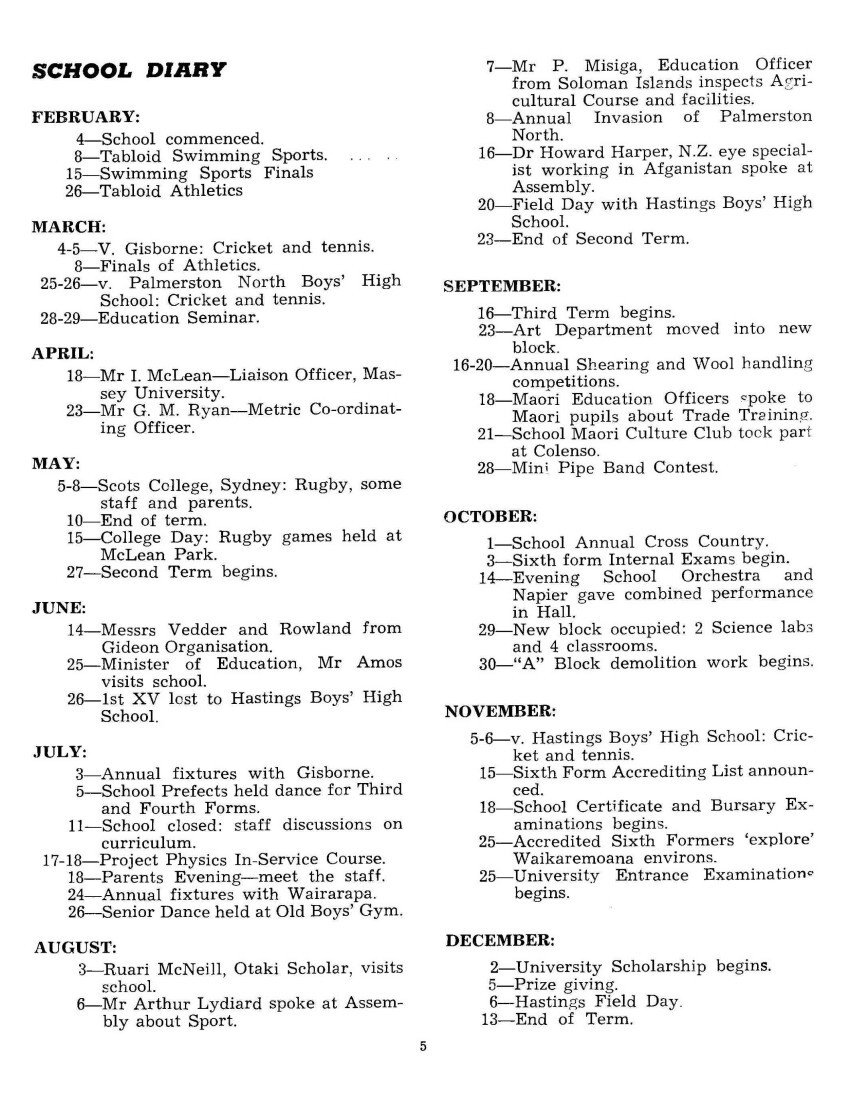
Page 6
STAFF NOTES
This year has been one in which we have been confronted with changes and prospects of change.
The long drawn out replacement of A Block by an S68 Block has caused inconvenience, borne with remarkable fortitude by staff and students. Mr Fry and his classes deserve special commendation by persevering in Al, while a mechanical shovel of dinosaur proportions chewed up the brickwork in the old south wing. The demolition was apparently accompanied by earthquakes of about force 5 on the Richter Scale.
As part of a national exercise on curriculum revision, we have as a staff examined the school’s course structures. Changes, especially to the senior school, are planned for next year. Syllabus changes have resulted in several staff members being required at an unusually large number of in-service refresher courses. We are grateful to Mr P. Riden, who at times such as these helped out by undertaking relieving work.
Another change was the appointment of Mr B. O’Connor to the new position of Senior Master.
Two changes in marital status occurred. We congratulate Ms G. M. Jenkins on her marriage to Mr L. Geor. During the year Mr Page was also married. and we likewise offer him and Mrs Page best wishes for the future.
As last year’s Scindian was published early in the third term, there was no opportunity to record in 1973 staff notes our gratitude to masters who left at the end of the year. Mr G. W. Ford and Mr J. B. Beardsell joined the staff in 1966. Mr Ford, a quietly efficient man, was in charge of the French Department, Master in charge of the Scindian and Senior Master in Scinde House. He is at present teaching in Tereora College, Rarotonga. Mr Beardsell was a valued member of the English Department, but will be especially remembered for his productions of musicals and plays. He is now H.O.D. English at Scot’s College, Wellington. Mr I. Roberts returned to us after leave of absence which took him to Great Britain. He has again left us, this time to take up a position at Bay of Islands College. He will be remembered for his art displays and enthusiastic coaching of athletics. Mr C. J. Duley gave valuable service in the Engineering Department and took a lively interest in P.P.T.A. affairs. He is now teaching in Auckland, at Kelston Boys’ High School. Mr P. B. White in the year he had with us established himself as a chemistry teacher, but left to travel overseas.
To replace these gentlemen we were pleased to welcome several new teachers at the beginning of this year. Mr D. Hutchinson came from Great Britain to join the technical department. Miss A. O’Donnell joined our English and French departments, Mr G. Walker, the science department and Scinde House. Mr Left took charge of art. After the appointment of Mr G. Clibborn to full time tertiary education, Mr P. Hunt came to replace him in the technical department. Mrs W. Campbell gave much appreciated assistance to the secretarial course at a critical time in the first half year. Her place was taken in July by Miss J. O’Brien who joined the staff as a full time tutor.
Most significant among impending departures is the retirement of Mr D. G. Revell. A highly respected and greatly esteemed teacher, Mr Revell perhaps gave the clue to his success as a school master when he once remarked, “I have always been fascinated by the genus boy.” A full valedictory to Mr Revell appears elsewhere in this issue.
Mr N. Macleod has decided to gratify an ambition to live in Auckland. Next year he intends to transfer to Long Bay College, a new school opening at third form level.
We owe Mr MacLeod thanks for his work in the technical department and for keen interest in the school’s pipe band, which this year reached unprecedented high levels of achievement.
Mrs Geor is leaving to travel overseas. We are well aware of the splendid work she has done to establish the secretarial course in the school’s polytechnic department.
Two masters have decided to leave us temporarily. Mr D. G. Seaton, attracted by the prowess of the touring 1st XV from Scot’s College, Sydney, and by opportunity to teach in Australia, has accepted a two year appointment at Scot’s College. Mr P. Aldous leaves to take up a one year position in the commerce department of Palmerston North Boys’ High School, so that he can continue studies at Massey University.
The opening up of the Hawke’s Bay Community College next year will mean that although Miss O’Brien, Mr T. A. Chalmers, Mr G. Lankow, Mr D. J. Sorenson and Mr G. Clibborn may still be working in the environs of our school, they will not be officially on its staff.
To all who are leaving, we extend good wishes for the future and thanks for their work and fellowship while they were with us.
As we go to press we have heard that Mr D. Monrad has resigned owning to ill-health. We are very sorry that this has happened. Those of us who have been on the staff for some years will look back to splendid dramatic productions in the past for which he was responsible. Full acknowledgement of his contribution to the school will have to wait until next year’s Scindian.
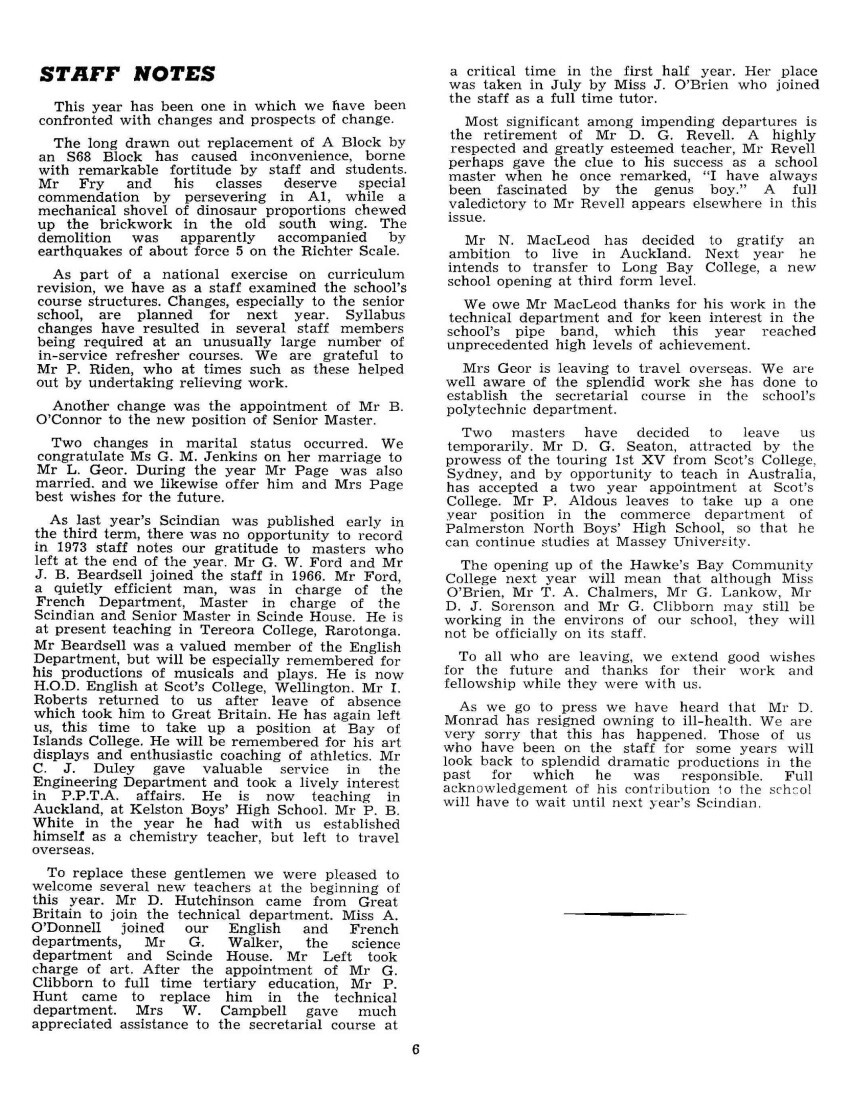
Page 7
MR. D. G. REVELL
– end of an era
In February 1975 Napier Boys’ High School loses one of its most respected teachers. Mr D. G. Revell B.A. Dip. Ed. retires and for the first time since he was five years old he is going to get away from the sound of the school bell. Mr Revell has been part of our school way of life for over thirty years and over this period he has learned to understand the boys he has taught. His mixture of discipline with the right to self expression is a very successful formula for teaching.
Mr Revell came to this school in 1944 after being demobilised and over the years his many talents have been employed. History and Physical Education were his specialities but he has also taught English, Maths, and Social Studies. Mr Revell has taken a keen interest in a variety of sports around the school and during the 1940’s and 1950’s his drive was a major reason for our school’s dominance in so many sports during those two decades. He coached both the 1st Cricket XI and the 1st Hockey XI and was one of the first teachers in New Zealand to participate in a revolutionary new concept of using movie films to teach greater skills in hockey. Mr Revell has helped mould such notables as Mike Shrimpton, Kevin Rigby and John Cullen into some of the country’s best sportsmen in their respective sports.
With the rank of Squadron Leader, Mr Revell also became actively involved in the now defunct School Cadet Battallion [Battalion] and was their officer commanding from 1962 until their abolition in 1964. He organised many exercises for the battalion. Some old boys will recall the defeat of an “invading” force at Tongoio [Tangoio] beach late in 1963.
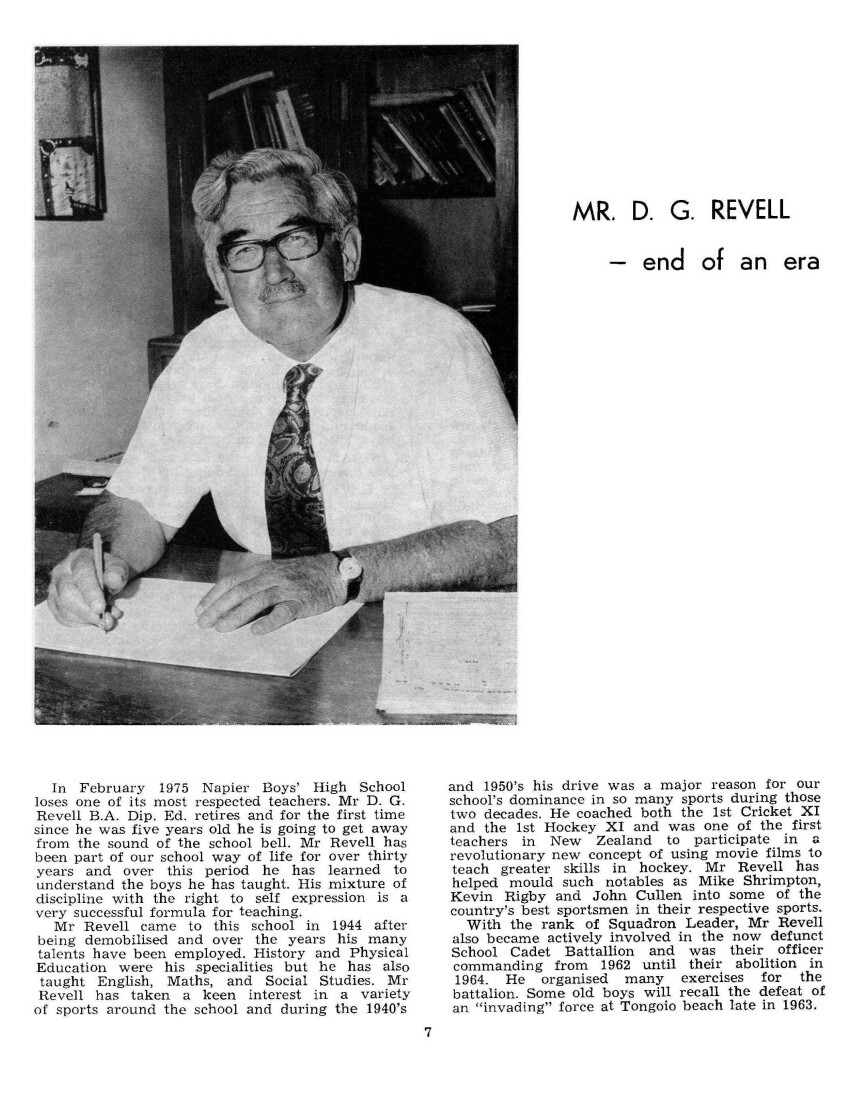
Page 8
In 1958 Mr Revell became Head of the History department upon the departure of the late Mr J. M. Reidy who became the first principal of Colenso High School. However, after 1958, Mr Revell’s extra curricular activities were severely curtailed when he was appointed head of the Technical and Continuation Classes Department. This other, often unknown to day-school students, side of our school has more than 1300 pupils which is considerably more than the school’s present daytime population of 850. Mr Revell is responsible for the welfare of these students and has the massive job of organising timetables and courses for our ‘other school’.
Over the years this side of the school has grown and next year Mr Revell looks forward to the opening of the Hawke’s Bay Community College at Taradale which he feels is the rightful place for the important needs of adult and technical education.
For a deeper insight of Mr Revell’s opinions and memories of the school the Scindian interviewed him.
SCINDIAN: What are your impressions of the students you have taught during your 30 years at Napier Boys’ High?
MR REVELL: The thing that has always impressed me about this school is the overall high quality of the students who leave us from the senior forms. Admittedly we have had some rogues in this place fellows who are mean to their mates and unpleasant to teach. However, most boys can recognise and avoid the fellow who is unco-operative and deliberately tries to make trouble; and most leave the school with the rough corners rubbed off and a genuine affection for their old school.
SCINDIAN: What are the main differences between today’s boys and those of thirty years ago?
MR REVELL: Fundamentally boys are much the same. There is very little difference except perhaps the modern boy is more willing to discuss things and express his point of view than the boy of thirty years ago. This I think is a good thing.
SCINDIAN: Is tradition an important part of today’s school?
MR REVELL: I have come to the conclusion that tradition is an important influence in this particular school. Boys are the most important people here and I have noticed how seniors in particular picked up good things and passed them down. This has been going on for over a hundred years. Loyalty to the school, staff, and class mates has always been an outstanding characteristic.
SCINDIAN: What are some of your most pleasant years at our school?
MR REVELL: Some of the most pleasant and rewarding times were those while I was coaching the 1st XIs in cricket and hockey. The long hours spent after school and in the weekends were well rewarded by the cooperation and enthusiasm of team members and the life long friendships made.
SCINDIAN: You were also very interested in the cadets. Could you explain what they were and the value of the movement?
MR REVELL: Well, up until 1964, cadets were always a strong feature of the curriculum. One whole week, known as Barrack’s Week, was set aside at the beginning of the year when all the school was organised along military lines. The school was divided into four companies and an A.T.C. unit. Instruction was given in elementary movements, weapon training, signalling, first aid and live shooting. This shooting took place on the school rifle range which was where the groundsman’s shed is now. Senior boys spent one full day out at the Roy’s Hill Range shooting with .303s and machine guns. Attached to the Cadet Battallion [Battalion] was a very strong Air Training Corps Unit (No. 20 School) which became well known in the Central Military District for its efficiency. When the cadets folded, due to lack of government finance, Flight Lieutenant Bremner attempted to carry on the unit but lack of assistance from the Defence Department forced him to close it down.
A full battalion parade was an exciting experience. It was a sad day when cadets went from the school. The unit gave an opportunity for leadership amongst boys which regrettably is not available in our school today. The cadets did not glorify war but the real value lay in leadership opportunities, responsibility for the boys, good bearing and posture.
SCINDIAN: What are the best and worst changes you have noticed since being here?
MR REVELL: Inevitably there have been many changes but who is to decide what is good and what is bad? So many of the values we had in 1944 have changed. I believe that any change which leads to better understanding of others and which leads to a fuller co-operation with others is good. I can’t help feeling that there is an element of selfishness creeping into the students of the school. “Chaq’un pour soi” (Each one for himself) is a little more prevalent today than it used to be; but then don’t we have to be strong individuals to survive in modern society?
Perhaps the greatest change that has taken place, and regrettably a retrograde one I believe, is the anonymity of some students which has come about by the increase in the school roll. In 1944 when the school roll was about 400 and all students participated (often compulsorily) in a much wider range of extra-curricular activities, every master knew every boy and usually sufficent [sufficient] about him to make him feel he belonged and that if the boy misbehaved he would almost certainly be found out. Something valuable was exchanged between master and boy in this situation. Today, I regret to say, that because of the larger roll and the freedom of choice in our school activities the shy boy or the boy with very little talent or personality can pass through the school with far too little of this master-student exchange.
In spite of what semi-informed radicals have been saying, there have been tremendous changes in the school curriculum, since I began secondary teaching. It is interesting to look at the very formal lesson and activities in a Physical Education film we produced here in 1946 and compare them with the comparative freedom, the wide range of activities available and the almost casual approach to the modern lesson.
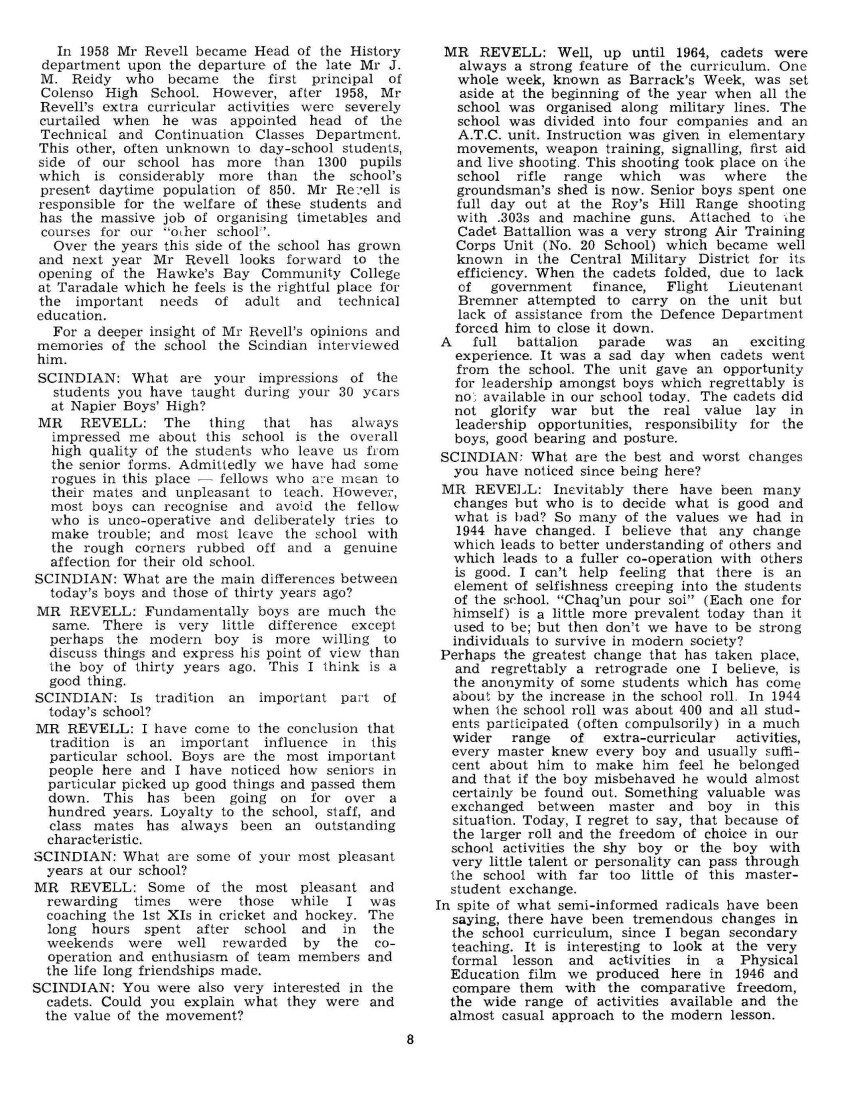
Page 9
It is doubtful whether the skills so necessary in our modern games are taught as well today. The modern syllabus tries to cover too much ground. History has always been a subject for the better student. It requires the ability to use the English langage [language] well. School Certificate History in 1944 covered such a wide range that students could get by with vague generalisations which today would have to be backed up by specific examples or sources or comparisons.
SCINDIAN: What is our school’s standing today?
MR REVELL: The school is in good heart. It has a good name throughout the country and old boys I meet in other parts of New Zealand speak with pride and affection of their old school. It will remain one of the great schools of New Zealand and I am pleased that I have been a small part of it for more than thirty years.
SCINDIAN: Thank-you Mr Revell.
PREFECTS’ NOTES
As has been the policy in past years the Seventh Form were asked if the prefects system should be continued or should a council system replace it. The majority favoured the continuance of the system and those elected were: – J. Beaton; S. Borrie; P. Caradus; K. Chadwick (head); R. Danks; R. Double; J. Du Four; P. Fleischl; N. Groom; P. Hazell; D. Herrick; C. MacErlich; J. Marsden; I. McRae (deputy); D. Muggeridge; J. Murphy; D. Pearson; R. Prebble; C. Riden; L. Sheppard; G. Smith; R. Sutherland (deputy); D. Thomas; D. Whyte.
The prefects this year saw a number of changes take place, these being: the appointment of a new master-in-charge, Mr R. D. J. McCaw; a boosting of prefect numbers from seventeen to twenty-four; and a new form of duty roster system. These changes were aimed at making the prefects’ role more prominent in the general running of the school.
The increase in numbers and the revised duty roster system were effective up to a point. The increase in numbers meant a greater spread of responsibilities which often led to some shirking their duties. If there is not full co-operation of all prefects, then the system cannot be utilised to its utmost. It is not right that once the office of prefect has been accepted, that any one should ignore the duties which are attached to that position.
On the brighter side of things, the prefects were represented in many areas of the school’s activities. Five were members of the 1st XI cricket, including the captain, D. Pearson. Eleven prefects played for the 1st XV Rugby, with K. Chadwick captain; two prefects were in the 1st XI Hockey, I. McRae the captain and S. Borrie the vice-captain; and five prefects gained selection for the school athletics team. We also had representatives in indoor basketball, debating tennis, swimming, Interact club and the orchestra.
This year the prefects combined with the third and fourth forms to organise inter-form sport in Rugby, and soccer. These games were played during lunchtime and the Rugby proved a great success. Unfortunately, owing to lack of time we were unable to begin the soccer games, but judging by the success of the Rugby I hope these games will be continued in future years. Thanks must go to the third and fourth forms for their co-operation and also to those prefects who either refereed or generally assisted in the smooth running of the games.
Another success story was the staging of our annual prefects’ dance on 26th July. The venue was changed from the rather cramped, stuffy, atmosphere of the James Banquet Lounge to the Technical Old Boys Gym. The night proved a success both financially and socially and special credit must go to the Dance Committee of J. Murphy, J. Marsden and D. Muggeridge.
On behalf of the prefects I would like to thank Mr McCaw for the guidance and assistance he gave to us.
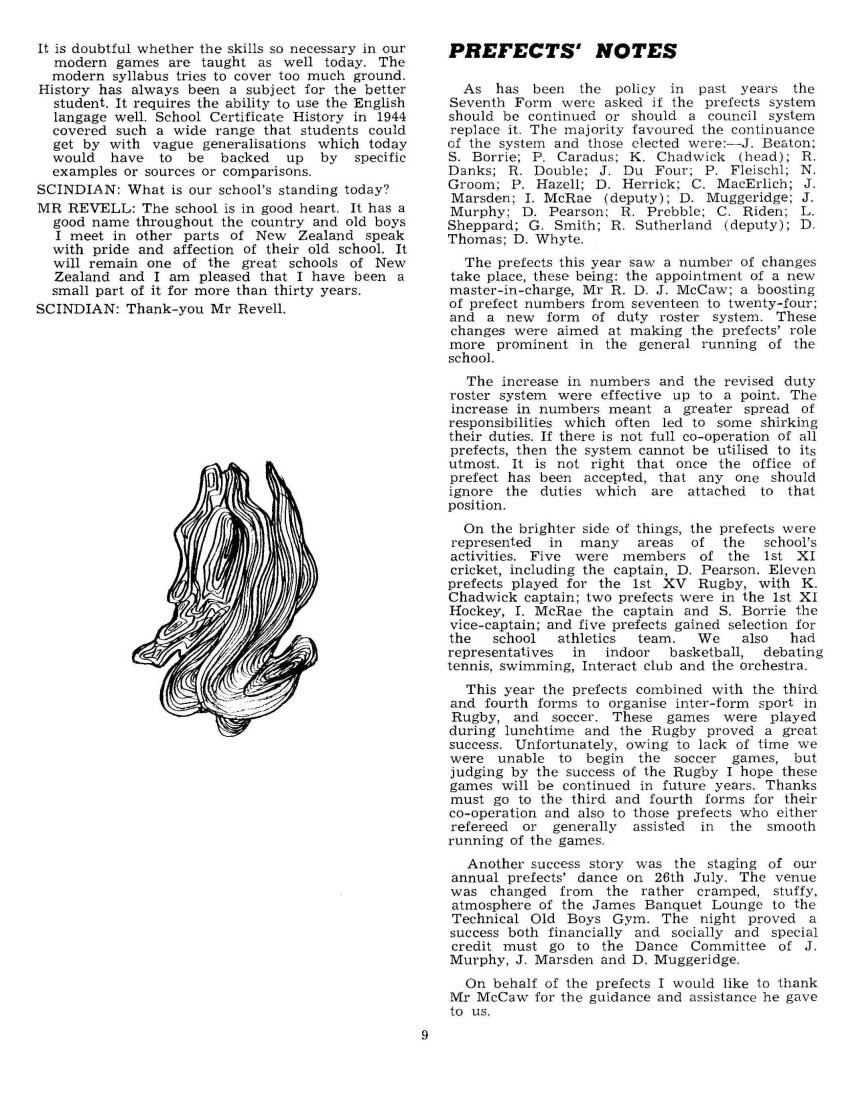
Page 10
Although I personally would like to see the continuation of the prefects’ system, I feel that it could be replaced by a council system in future years. Unless all prefects are willing to contribute their time conscientiously to their assigned duties and show by their personal behaviour that they believe in the system, then some kind of council system will surely be more viable. Perhaps with the direction of changes taking place in our society, such modifications are more in tune with our times anyway.
V. Te K. Chadwick
PREFECTS
Front Row: D. A. Whyte, N. D. Groom, M. J. Murphy, I C. McRae (Deputy Head Prefect), V. Te k Chadwick (Head Prefect), R. J. Sutherland (Deputy Head Prefect), J. F. Marsden, J. W. Du Four
Middle Row: D. J. Muggeridge, D. J. Herrick, P. J. Caradus, D. W. Thomas, J. Beaton, R. W. Double, C. A. MacErlich.
Top Row: J. C. Hazell, P. C. Fleischl, S. J. Borrie, R. B. Danks, D. W. Pearson, L. J. Sheppard, R. G. Prebble, C. P. Rider.
Absent: W. D. G. Smith.
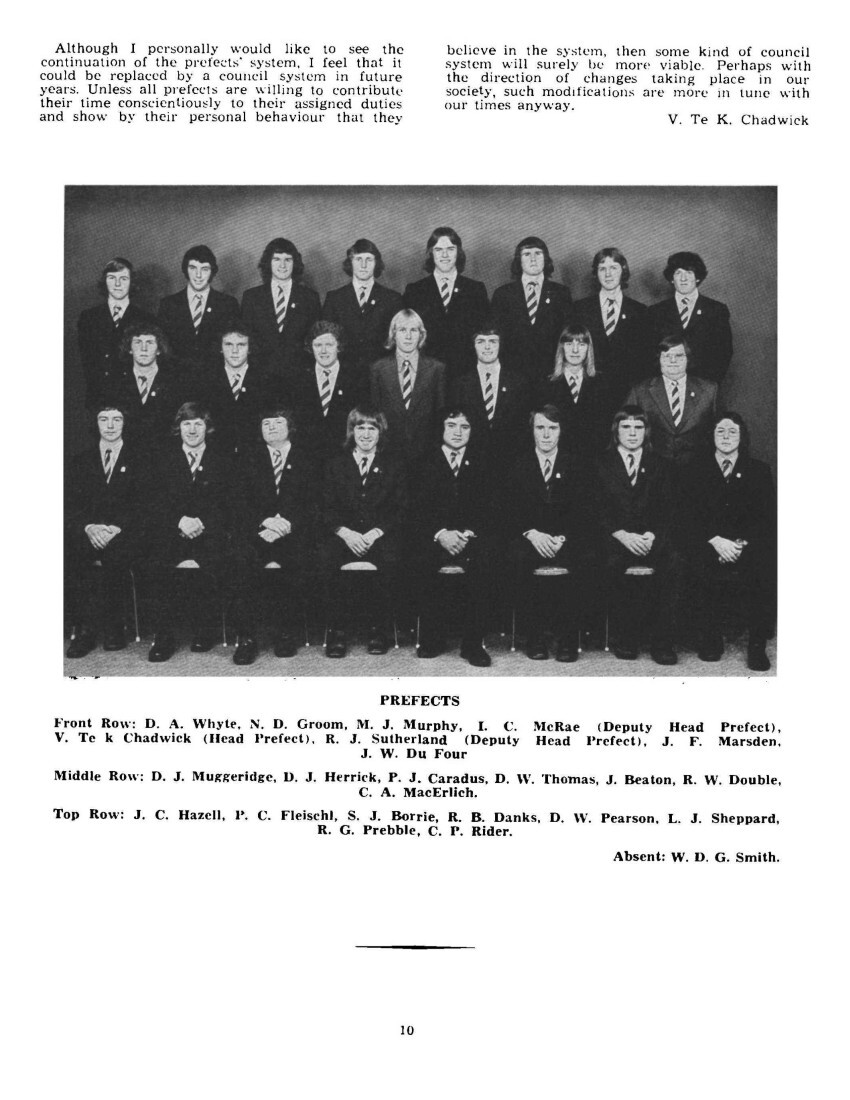
Page 11
The Head Prefect 1974
– V. T. Chadwick.
Haikus.
Aged tree of life:
A spark jumps into midst:
Smell of burning soul.
Solitary flame:
A Flicker in gentle breeze:
Timeless dance on walls.
The untouched field:
A Battle roars destruction:
Sound of the ravage.
The bouldered beach here:
A foaming wave smites the beach:
Feel of te sea spray.
J. Melhuish, 4A
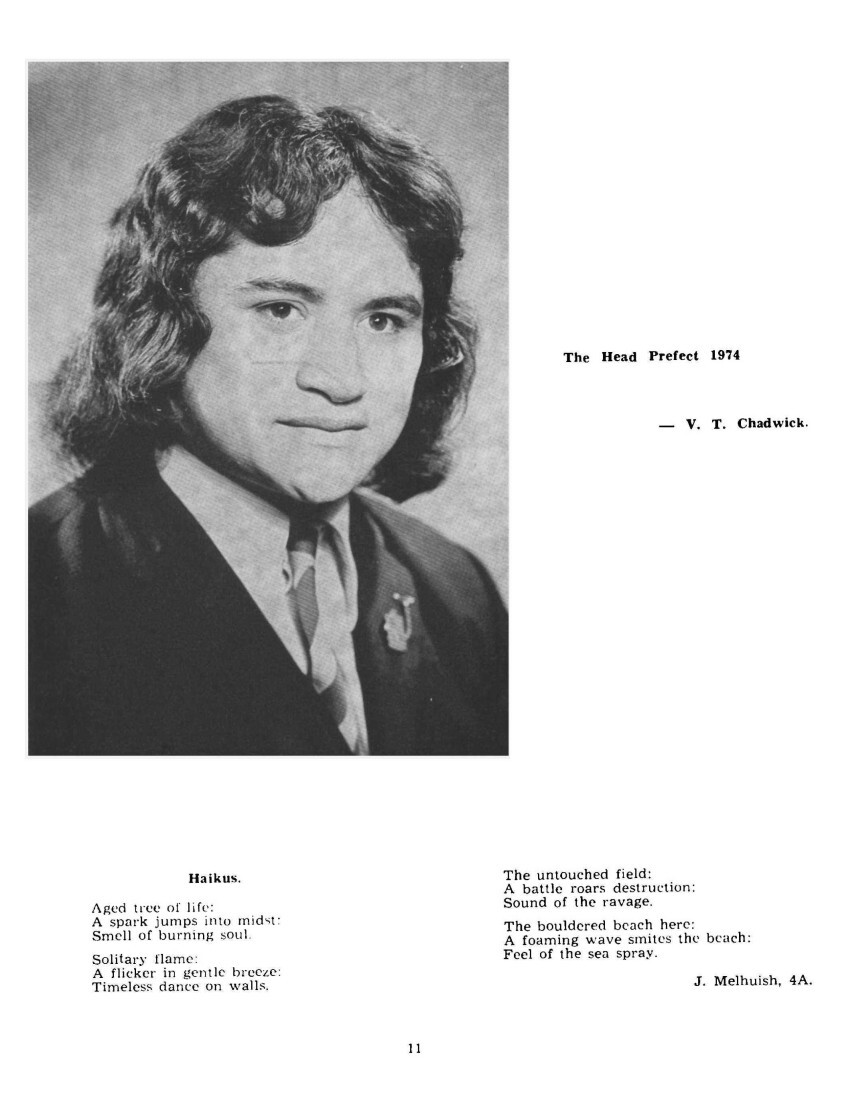
Page 13
INTERVIEW WITH C. K. ONG
Ong comes from a town of Malacca, West Malaysia, with a population of about 86,000. Malacca is a town rich in history and proud of its glorious past as the ‘half-way house’ between the East and the West. It has come under various European powers until the English came along in the 18th century, taking over not only Malacca, but also much of the Malay Peninsula. Malaysia developed rapidly under the British and finally, through the effort of the former Prime Minister, gained independence in 1936. Malaysia, today, with the tin and rubber industries as the main pillars of the economy is amongst one of the fast developing countries in SE. Asia, with an expanding population of about 10 million.
Scindian: Why did you come to N.Z.?
“Well, I sat S.C. a couple of years ago and passed all my subjects, but I am still not qualified for 6th form. So the only alternative was to apply for a place overseas where education opportunities are better. Fortunately, I was accepted by N.Z., which is one of the few countries I applied for. In actual fact, my own country rejected my entry into the 6th form, on the grounds that my Malay language mark did not reach an acceptable level.”
Scindian: Surely you must know the Malay language well, since you are a Malaysian?
“You must first take into consideration that Malaysia is a plural society with Malays, Chinese and Indians-the major races. Learning one language or knowing your own is not enough, if you want to get around. But English is widely used and I will be speaking it for most of the time instead of Malay, even though I do have a fair command of the language. I have to admit that most non-Malays can not write as well as they speak Malay.”
Scindian: By the way how many languages can you speak?
“I can speak 6 – English, Malay, Mandarin and 3 Chinese dialects. This I would say is about the average for the majority of Malaysian-Chinese.”
Scindian: How about the education system?
“Basically, we do 6 years primary, 3 years lower secondary and 4 years upper secondary; i.e., 4th, 5th, 6th and upper 6th.
Scindian: Do the students have to wear any uniform?
“Yes, we do have a common uniform throughout the country and that is – white shirt, white shorts, white socks and shoes. Because of this we have to wear badges to identify which school we come from.”
Scindian: Can you give us some brief description of the examination system?
“The examination system is more in line with those of the British in the sense that questions are set and marked in England in co-operation with the Cambridge University. This only applies to the S.C. and the H.S.C. papers. In the 3rd form, a student must take 8 subjects and sit them at an external examination at the end of the year. The certificate obtained; i.e., the Lower Certificate of Education, will enable the student to go to the 4th form. Anyone who failed this exam, will hope to sit again, provided that he can afford the finance for another year of education, otherwise he will join thousands of other dropouts. The 3rd form exams will decide whether the student is qualified for the Science or the Arts course. Those who qualified for science but wish to go to arts are allowed to but secondary arts students are to remain where they are throughout their secondary school life. In the 4th and 5th form, the number of subjects is increased to 9 and the S.C. is based upon the two years work. A student has to get more than a pass in S.C. to qualify for a 6th form year because of strict competition and limited 6th form classes. In addition to getting good marks, a student must have a credit pass in English and the Malay language. In the 6th form, the subjects are reduced to 5 and are more specialised in the sense that those students who want to be in the engineering field will go to the “maths class” and those interested in medicine “biology class” and of course there is the “arts class”.
Scindian: How about the school hours? Is education free?
“School goes from 7.30 to 2 p.m. without a lunch break. The sports activities usually span from 4.00 to 6 p.m. Education is not free. A secondary student pays from $10-$16 per month, school text books, plus other miscellaneous fees. As a common Malaysian saying goes, “Have money, will study”.
Scindian: Which is your national sport and what other popular games are played?
“Our national sport is “Sepak Tarkaw”. It is considered to be the national sport not because of its popularity but rather because the Malays originated it. The most popular sports however are soccer and badminton. Rugby and cricket appeal only to the minority but the sports council have been trying to create interest by providing sports facilities which most of the schools lack.”
Scindian: How do the teachers in New Zealand compare to those in Malaysia?
“I really can’t see much difference as far as teaching techniques are concerned except maybe the relationship between the students and teachers are much closer as compared to those back home.”
Scindian: What about corporal punishment?
“Corporal punishment is carried out on students who commit “crimes” like smoking, fighting in school and rude behaviour in front of teachers. Caning is carried out, usually during assembly so as to discourage would-be offenders and to embarass [embarrass] the offender.”
Scindian: Does the prefect system exist ?
“The prefect system does not vary very much from school to school. In Malaysia it is the teachers who elect the prefects and not the students. Their duties range from keeping the class in order in the absence of teachers, acting as representatives of the students and other small duties. There is a “court- trial” carried out by the prefects every week to give offenders a chance to defend their case but often enough the prefects normally win their case. Because of this, prefects are the most unpopular people in the schools.”
Scindian: Finally what do you think of New Zealand?
“Well, undeniably New Zealand is a wealthy country with the majority of people in comfortable
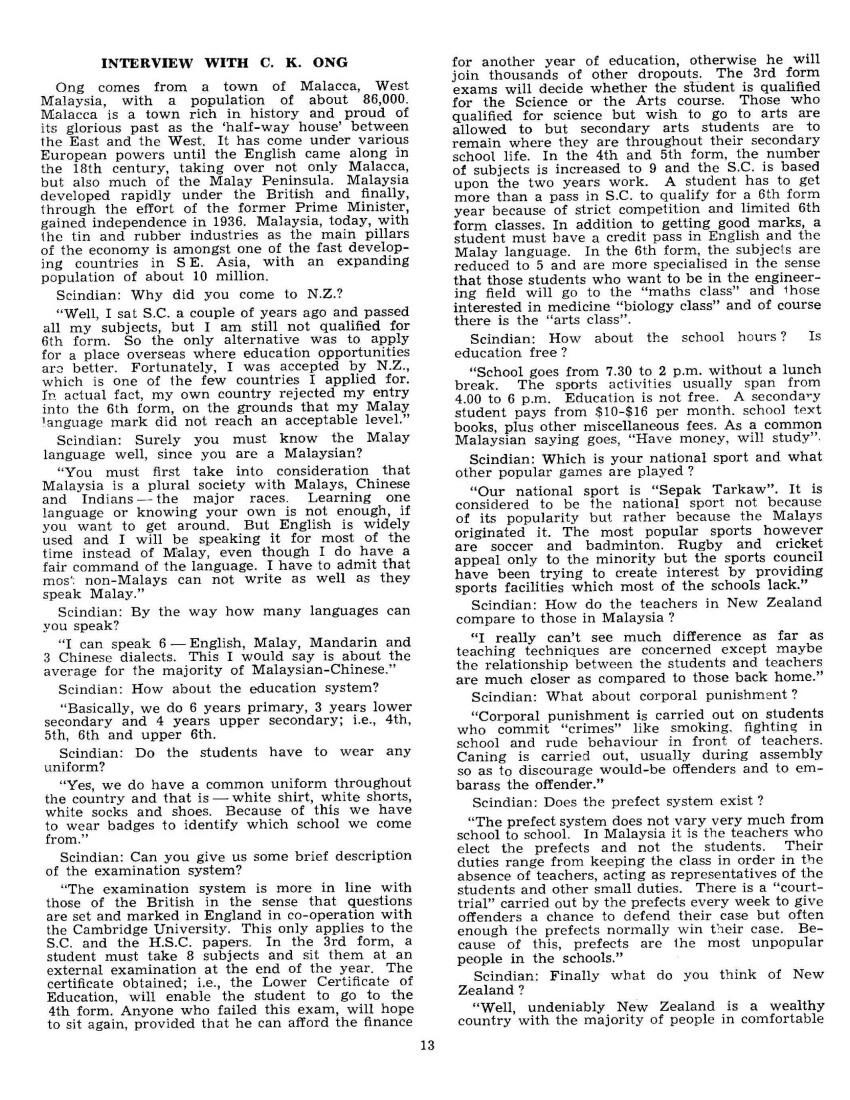
Page 14
and luxurious homes. After witnessing poverty which is at my own front door I cannot help feeling envy for ‘Kiwis’. And, of course, the beautiful countryside does not go unnoticed. As far as I am concerned I see New Zealand as giving me hope in my future career which I might not have if I stay in Malaysia.”
THE EEL
The Eel
Silvering Sliding
Enjoying the Light
Drifting with the current of the country stream
The willows drooping leaves
Curling Swirling with the current.
PAUL GURRAN, 4A.
MAN
Earth’s Fauna.
Perfected by society.
Great thinkers and creators.
Power wielders and wealth grubbers.
Anon.
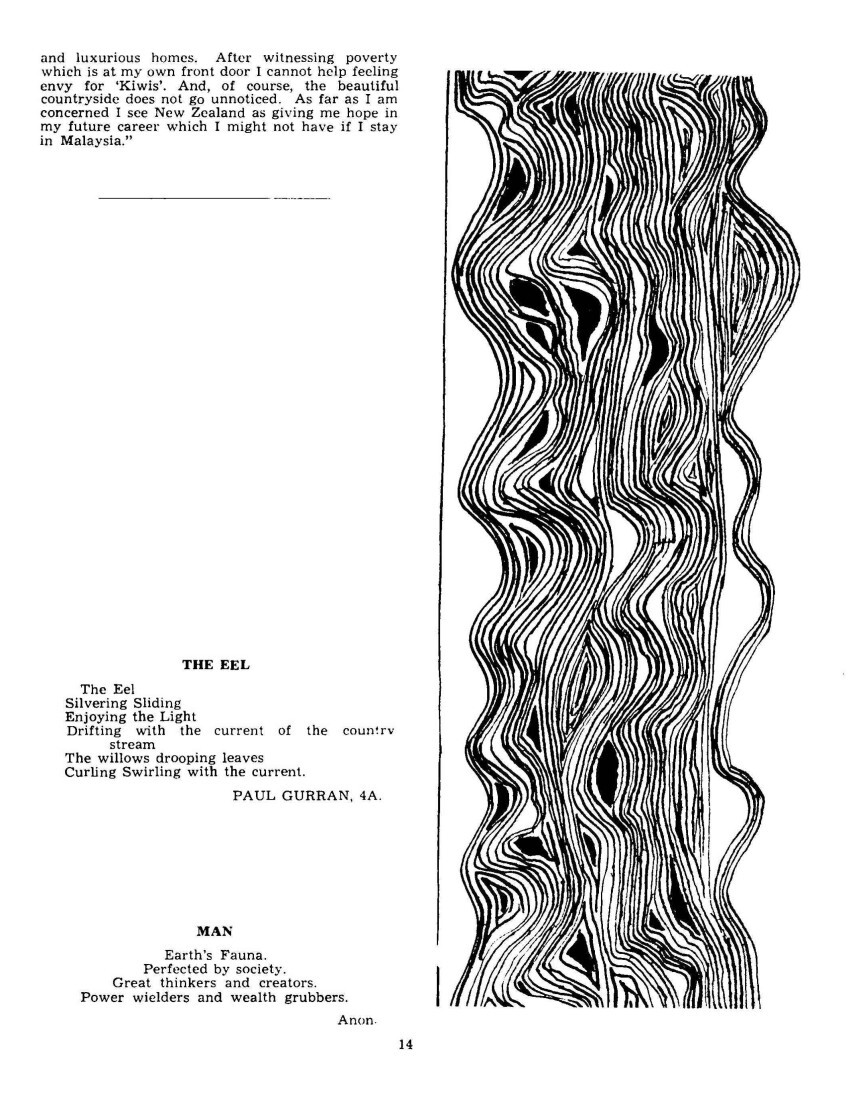
Page 15
THE SCINDIAN’S VERY OWN DAVID FROST INTERVIEWS MR PAXIE, CAPTAIN OF THE “HEADACHES” BASEBALL TEAM.
Frost: I wonder if you could tell us a bit about your team, Mr Paxie?
Paxie: Well, there’s who on 1st base, what on 2nd base and I dunno on 3rd base.
Frost: Yes, that’s very well, but……. what’s the name of the player on 1st base?
Paxie: No, he’s on 2nd base – Who’s on 1st base.
Frost: I dunno!
Paxie: No. He’s on 3rd base.
Exasperated Silence.
Frost: Well if you’re not going to tell us who’s on 1st base, maybe you could tell us who’s on 2nd base?
Paxie: No! He’s on 1st base. What’s on 2nd base?
Frost: I dunno!
Paxie: No, he’s on 3rd.
Frost: No, what I mean is; Who’s the player on 2nd base?!!
Paxie: For the last time – Who’s on 1st base.
Frost: I dunno!
Paxie No! he’s on 3rd base.
Silence
Frost: It’s obvious we aren’t getting anywhere!
Paxie: You can’t anyway. He’s on holiday.
Frost: Could you tell us the name of your pitcher?
Paxie: Tomorrow.
Frost: Why not today?
Paxie: I’m telling ya, Tomorrow!
Frost: But why not today?
Paxie: He’s backstop.
Frost: What other team members have you?
Paxie: Well, there’s Mine on right-out and Catchable on short stop and…
Frost: That’s fine thank you, Mr Paxie, I see our time’s running short.
Paxie: He’s a mighty good runner.
Frost: (Oh brother!)
Mr Paxie, in conclusion, what position do you play?
Paxie: Oh, I’m left – right out!
A.T. Arnold 5A
THE RISE AND FALL OF A YOUNG TURD
He knew not of glory,
But of meaknes and of average
Yes, he was a commoner
Contented and secure
He was an equal
He was with his peers.
He lived his world of fantasy.
Then pulled into the real world
His future thoughts were shuffled.
Everyone is a rival in this world of constant stress.
He said his humble ways must change,
To be of some success
With dynamic lust he forced himself
Onto the utmost peak.
No longer meek
His peers he did neglect.
Their calls and wishes he ignored
“I’m superior, they’re bores”
Yet the very forces of his reaches
Commanded his conformity.
Be a commoner
A common superior?
No longer content
He was secure no more
It was free to be different, autonomous.
So alone he sat.
He disturbed no one
And no one disturbed him.
He knew now of glory
And he sat all alone.
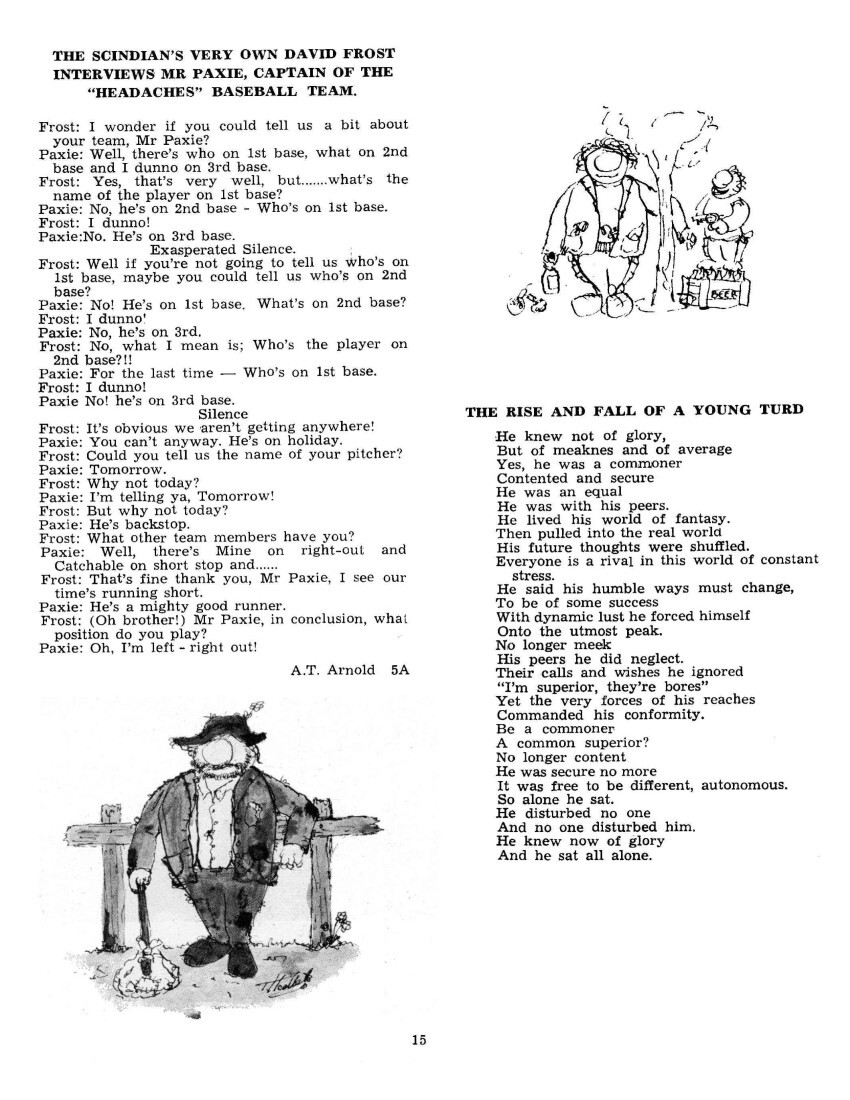
Page 17
TRANSLATION
Hello, everybody. My name is Yoshifumi Ito but please call me Yoshi.
I come from the southwest of Japan. My town is between Hiroshima and Osaka. My town’s name is Okayama. Our town’s population is about two million, but this is three cities altogether. It has about the same area as Christchurch, so you see Napier is very small.
Our school is about 100 years old. It is mixed and has about 1000 students. Our school has a landscape gardening course and I am taking it because my father is a landscape – gardener. We also do technical drawing but it is linked with gardening. In my gardening course, we do some projects in which we go out and plant trees, cut grass and plant flowers. Our school begins at 8.50am and finishes at 3.15 pm. In the Japanese school system we start school at 6 or 7 years old Primary school lasts for 6 years, then we go on to Junior High School or Intermediate. This lasts for three years then we go on to Senior High School or High School. You can leave at the end of Junor High School if you want to. After three years at Senior High School you can go to College or University. College is two years at a University but a proper University course is four years long. There are two different types of Senior High Schools, one is like a polytechnic and the other is an academic school
My town is on the coast of the Inland Sea. The main industry is connected with the oil companies There is also the iron and steel industry, ship building, and holiday makers come to the beaches. This part of the Inland Sea is also famous as a fishing area. My mother has a fish food shop, where she cooks fish dishes. I have two brothers and one sister. My eldest brother is 24 years old and he helps my mother at her shop. My second brother as an electrician and is 21 years old. My sister is 20 years old and she goes to Kobe University.
Japan’s national sport is baseball. There is a very famous Senior High School tournament held every year in summer. Most Senior High Schools play, including ours. At baseball, ours is useless even worse since I left. Rugby is only played at university so i tis not very common. Soccer, basketball, volley ball and tennis are very popular, especially in Senior High School. Unlike New Zealand sports, they are played all the year.
Pollution is very bad, especially in the big cities and is even in our town. Most of the time smog covers the town, and looks like a high cloud. Water pollution kills all the fish near the ports. The fishermen have to go further away for their fish.
Our Japanese house is a very tall house but not wide enough. We have a three storied house. Most houses can not have gardens or if they have, they are very small.
In conclusion, I would like to thank everyone concerned with making my visit here possible and especially the International Rotary Club which has organised and assisted me so much
Y. Ito.
PETER FLETT
5F
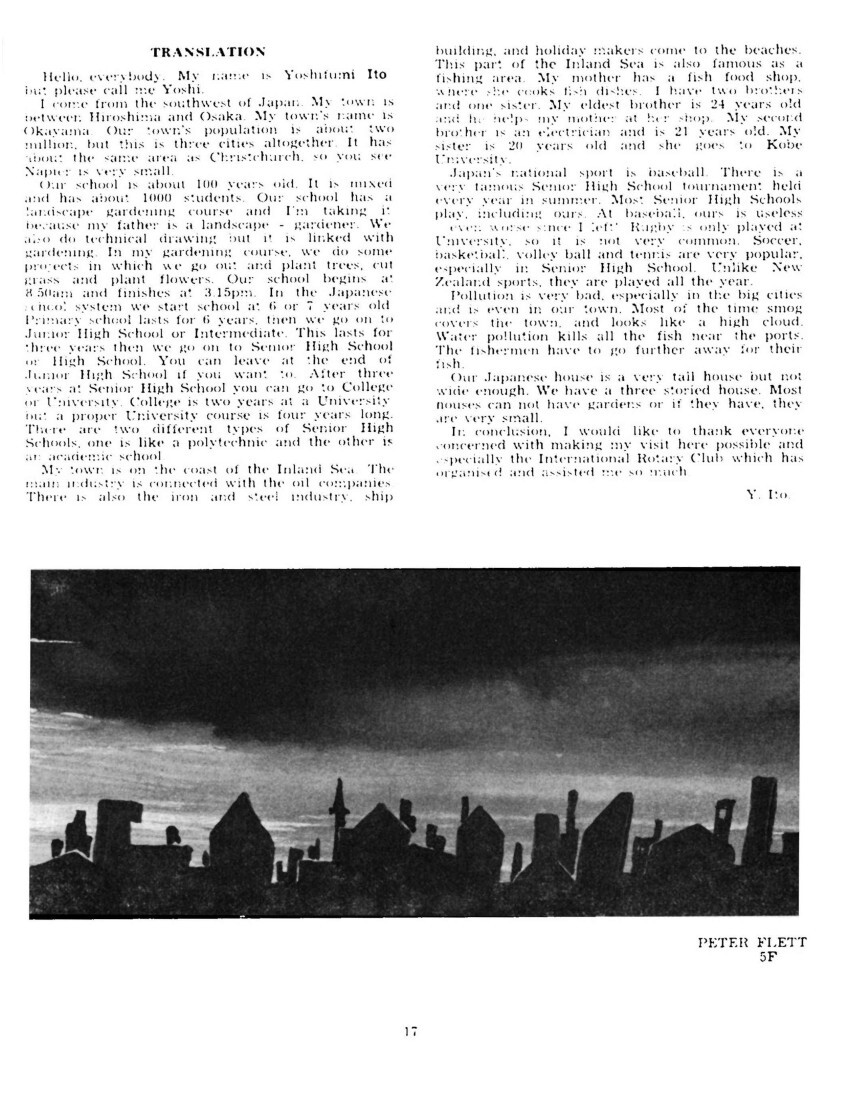
Page 18
Lindsay Sheppard receiving the voucher for a holiday for two in Hong Kong after winning the Napier Centennial essay contest.
The Winning Essay
In an attempt to describe Napier in the year 2074 special mention will be made of its form and function, with emphasis being placed on housing, recreation, tourism, communications, commerce and industry.
In the period 1974 to 2074 there will be even more spectacular change than in the previous hundred years, however, the ideas in this essay can only be expressed in terms of known technology. It is not possible to speculate too far beyond this knowledge, for this would take us into the realms of science fiction, and particular relevance to Napier would be lost.
FIFTH N.Z. CENTRE
Let us imagine that the year is now 2074 and in the two hundred years since the Borough Council’s inception Napier has established itself as the fifth largest urban centre in New Zealand. By limiting urban sprawl, Napier has remained the servicing centre for one of the richest agricultural zones in Australasia and its recreational facilities have insured its continued success as a tourist centre. Increased demand for wool has made Napier the largest processing and distribution city in the world.
With a population of one hundred and twenty thousand, efforts have been made to prevent the encroachment of the city onto valuable agricultural land. The idea of own your own land has given way to apartment buildings and now individually designed modules are scattered throughout the residential areas of Maraenui, Marewa, Pirimai, Tamatea, Taradale and Poraite [Poraiti]. Privately owned houses remain only on Scinde Island, where the links with the past are most evident.
These integrated modules are powered by their own solar collectors heating steam to drive turbines. Household wastes are composted and used as concentrated fertiliser.
A ready water supply is obtained directly from the artesian water basin and the buildings’ cleaning and maintenance is fully automated.
PARADE MARINA
However, with the increase in leisure time, greater demand is placed on outdoor recreational facilities. To cope with this, the area between the modules is set out in parks, domains, play centres and gardens. In addition to these areas, the Marine Parade, enlarged by a floating marina, not only provides relaxation and entertainment for the citizens of Napier, but also caters for the tourist trade which has developed around it.
The Marineland, recently extended, contains the greatest number and variety of dolphins and
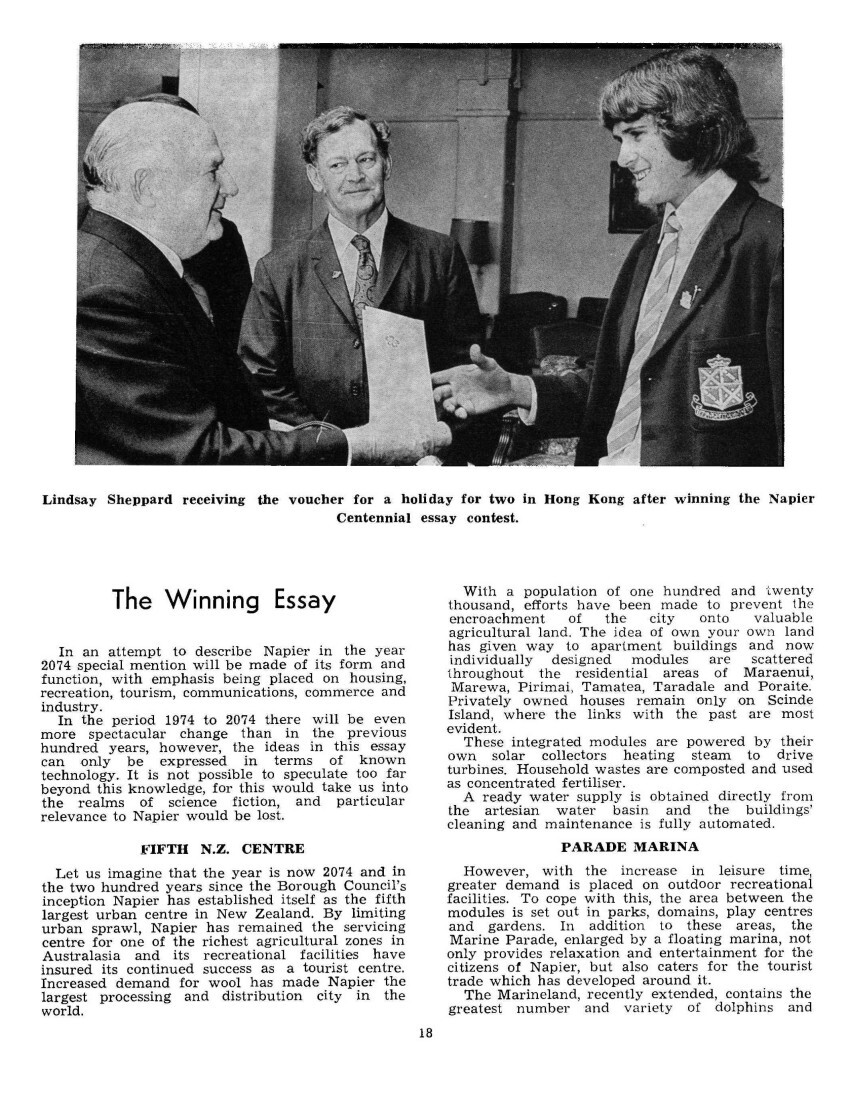
Page 19
sealions in the world. An artificial environment, as close to their natural habitat as possible, has been established and the breeding in captivity of these threatened species has taken place. An auditorium facing toward the sea and seating fifty thousand is situated to the north of Marineland. This complex is in full use as a centre for the bicentenary celebrations. Set in park-like surroundings, the swimming facilities, marina, sporting areas and beachfront have helped make the Marine Parade a source of substantial revenue.
Conservation and ecology have formed the basis of town planning in Napier for the past 90 years.
One of the greatest problems, congestion, has been alleviated by the moving of short-range transport underground. This now forms a system of computer-programmed interconnected subways.
Access to these subways is gained by escalators placed at each module, and vehicles powered by nuclear-charged batteries move magnetically above monorails. Electrically propelled buses travelling on guideways are the only means of conveyance above ground in the inner city.
MONORAILS
The servicing of the industrial and agricultural zones and the control of long-range passenger travel requires a much more complicated system. The brain of the network is located at the site of the old aerodrome. Its computers control trains, ships, hovercraft, helicopters and aircraft. Passenger travel is serviced by the monorails, with an underground terminal in each suburb. Once out of the residential sectors they are raised high above the ground, guiding air-cushioned trains accelerated by nuclear-turbine engines.
International travel is carried out by vertical takeoff and landing passenger jets. The transport of goods and produce to New Zealand and overseas cities is accomplished by nuclear-powered container ships. The harbour which extends from Bluff Hill to Perfume Point, can service 30 of these ships.
The supply of power to the transport, domestic and industrial needs of Napier is obtained from solar energy and a nuclear fision reactor built at Whirinaki. The reactor combines hydrogen atoms to form helium atoms and during the process nuclear energy is released. The only raw material needed is deuterium, a form of hydrogen. This is gained directly from sea water. Only a small proportion of its energy output is required by Napier.
The greatest percentage of this power is consumed by the city’s industries, which are situated in the suburbs of Onekawa, Ahuriri, Bay View and the Port. Three major industries have developed in these regions. Onekawa, the traditional industrial area of Napier, is the production and maintenance centre for the computers and mechanical equipment which, under the direction of the City Council, runs the city so efficiently.
SEA FARMS
The woollen industry provides Napier with its biggest source of revenue. Since the exhaustion of oil supplies and the lack of petro-chemical alternatives, the demand for woollen garments and carpets has made Napier one of the biggest processing and distribution regions in the world. Its factories and stores are spread over the suburbs of Ahuriri and the Port and partly over the reclaimed land at Westshore.
The processing of food grown in the regions extending to Hastings in the south, Eskdale in the north, and Rissington in the west constitutes the third major industry. Nutrients are extracted directly from the producer levels in the food chain and because of this the necessity for pig, sheep and cattle raising is eliminated. This process increases tenfold the amount of food available to the human population.
With food yield being the most serious problem facing the world, the processing plants are also designed to cope with the products of floating sea farms. Three such farms harvesting plankton, shellfish and small fish, operate within Hawke Bay. Excess food is placed in a world food bank
The administration of these industries and the control of the city is carried out by the City Council, centred in the suburb of South Napier and the central city. Being the nucleus of the city, this area contains the commercial buildings which form a computerised shopping complex, with insurance, banking and accounting controlled by master computers. It is also the focal point for community involvement in the city’s cultural activities.
CULTURAL CENTRE
Innovations begun by the Mayor and council of the 1970’s have continued so that now Napier is the cultural centre of New Zealand. The industrial and commercial interests of Napier have provided the citizens with a rich legacy of artwork and sculpture, as well as contributing to the enlargement of the art gallery and museum and the building of an auditorium.
The bicentenary celebrations have in fact stressed this historical and cultural aspects of Napier. As in the centenary celebrations, a procession portraying the past and present will pass through the city. By showing the steps made in transport, housing, industry, commerce and recreation, it will emphasise to the people of Napier the controlled planning and foresight which have been a feature of the city’s administrators, who have made Napier a prosperous and thriving community. A city which has kept abreast of world trends and yet retains its links with the past. A place where pollution has been eliminated and the people live in harmony with the environment.
To achieve all this, the planners of 1974 must be aware of the alarming acceleration of technology and be prepared to plan ahead, for the overall benefit of the people. It is now apparent that this problem is being recognised and Napier can look forward to its future with optimism.
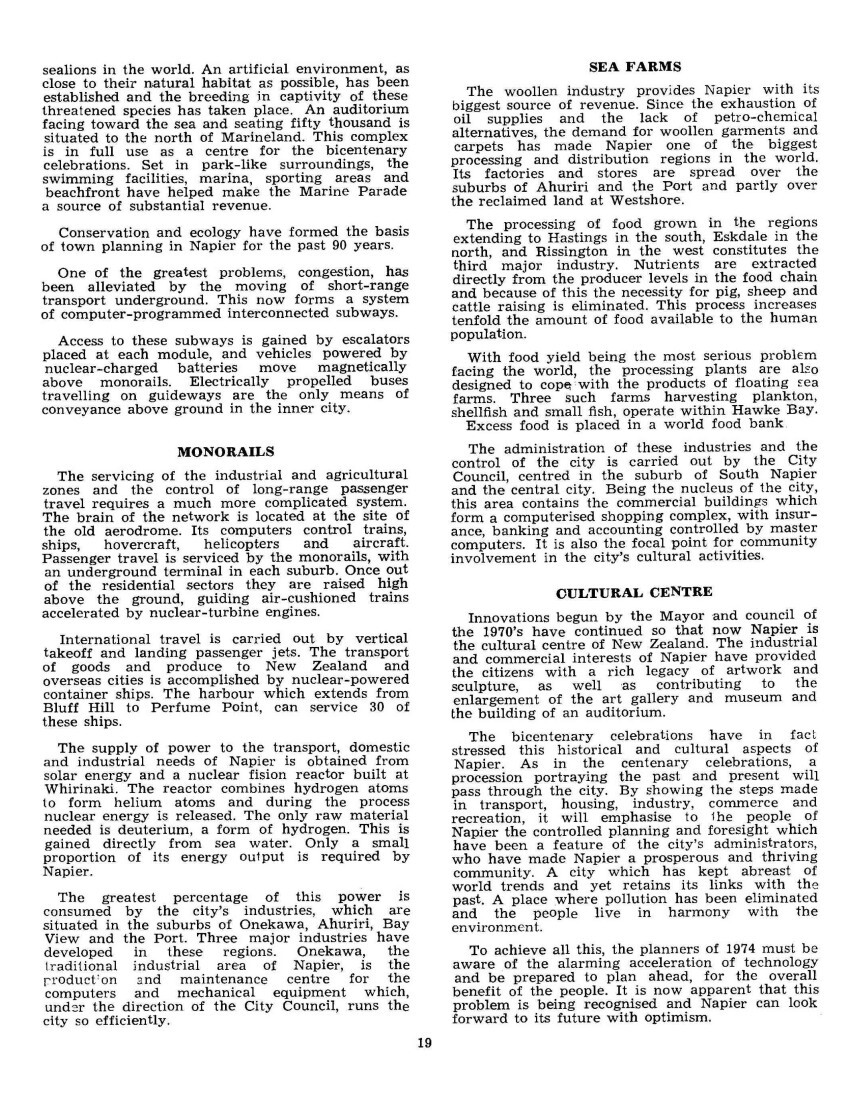
Page 20
HONG KONG – WHERE EVERYTHING IS DONE ON BIG SCALE
Lindsay Sheppard wants to go back to Hong Kong one day
My trip to Hong Kong has left impressions of a way of life completely different from anything in New Zealand. It is a land of striking contrasts. We arrived at Kai Tak airport at 9pm and stepped off a cool air-conditioned DC8 into 35 degrees Celsius of sticky humidity.
As soon as we had been cleared through Customs and had walked out the departure gates, several touts approached us. Speaking well rehearsed English, they asked us if we needed transport to a hotel. Luckily there was no delay before the Abel family arrived. We were soon on our way to Hong Kong Island, where they lived in an apartment building.
GREAT EXPERIENCE
Staying with the Abels was a really great experence [experience]. Not only were we entertained, fed, and housed, but we were given the benefit of their valuable local knowledge.
This knowledge helped us decide the best place for us to get rid of our money. As Hong Kong is a duty free port, stereo and photographic equipment is exceptionally cheap. However the shopkeepers in Kowloon are geared especially for the tourist trade, and are always looking for rich, gullible tourists who are easy to fleece. Fortunately a shop was recommended to us by Rod Abel. It was here that we spent most of our money. A stereo amplifier is an example of the bargains to be made. It cost $620 H.K. ($98 NZ). In Napier the same amplifier cost $299. Throughout this shopping area in Kowloon nearly all the salesmen have some knowledge of English. All are quick, shrewd businessmen and bartering becomes a necessity. Tailormade clothes are also cheap. We were taken to Aberdeen, a Chinese fishing village where English is not spoken. With sign language the material and design was decided and a couple of days later a sportsjacket was ready.
ALWAYS ON GO
During our stay we were constantly on the go, being taken all over Hong Kong Island, Kowloon, the New Territories and around the islands of Hong Kong. The really remarkable feature of Hong Kong is that in an area of 400 square miles (14 times the size of Lake Taupo) with five million people, there is such a large percentage of open land covered mainly in bush. It was difficult to accept so many people lived in such a confined area. The reason for the large areas of open space was that most of the people were housed in apartment blocks. One block alone accommodated 50,000 people
Everything in Hong Kong is done on a large scale. The 250-acre Ocean Park dwarfs Napier’s Marineland. At the moment it is at the foundation stage, with the number of animals increasing every day. It will be a mammoth task for Mr Abel and an American colleague, Dr Hammond to guide and control the progress of this oceanarium to the same level of efficiency achieved in Napier. It will probably be 10 years before they can relax.
There is no change in tempo as night falls. Shops stay open until 10pm and bars till 2am (no evidence of a legal drinking age). There are several ten pin bowling alleys, numerous picture theatres, many restaurants, and even New Zealand-style snooker rooms. The red light district in Wanchai, home of Suzie Wong, remains active throughout the night.
From what I saw, however, most of the people can not enjoy this wealth of activity. There is a great contrast between the rich and poor in Hong Kong. There were several shanty towns on the outskirts of Kowloon and in the New Territories and much free land has been taken over by squatters. This was one depressing feature of Hong Kong. On the other hand a director of the Royal Hong Kong Jockey Club was able to build a tunnel from Hong Kong Island under the harbour to Kowloon, which the Government couldn’t afford.
My experiences in Hong Kong will never be forgotten and my impressions of it are nearly all favourable. The places to see, the things to do, and the people I met have made it a place I want to return to.
CIVILISATION (To the native)
We who came late to civilisation.
Missing a gap of centuries
When you came we marvelled and admired
But with foreboding,
We had so little but we had happiness
Each day a holiday
For we were people before we were citizens
We who had so few things, the prime things.
We had no policemen, lawyers, middlemen
Brokers, financiers, millionaries [millionaires]
So they bewildered us, all the new wonders
Stocks and shares, real estate,
Compound interest, sales and investments
Oh! we have benefited, we have been lifted
With new knowledge, a new world opened.
Suddenly caught up in white mans ways
Gladly and gratefully we accept.
And this is necessity
But remember, white man, if life is for
happiness,
You too, surely, have much to change.
C. Fraser 4A.
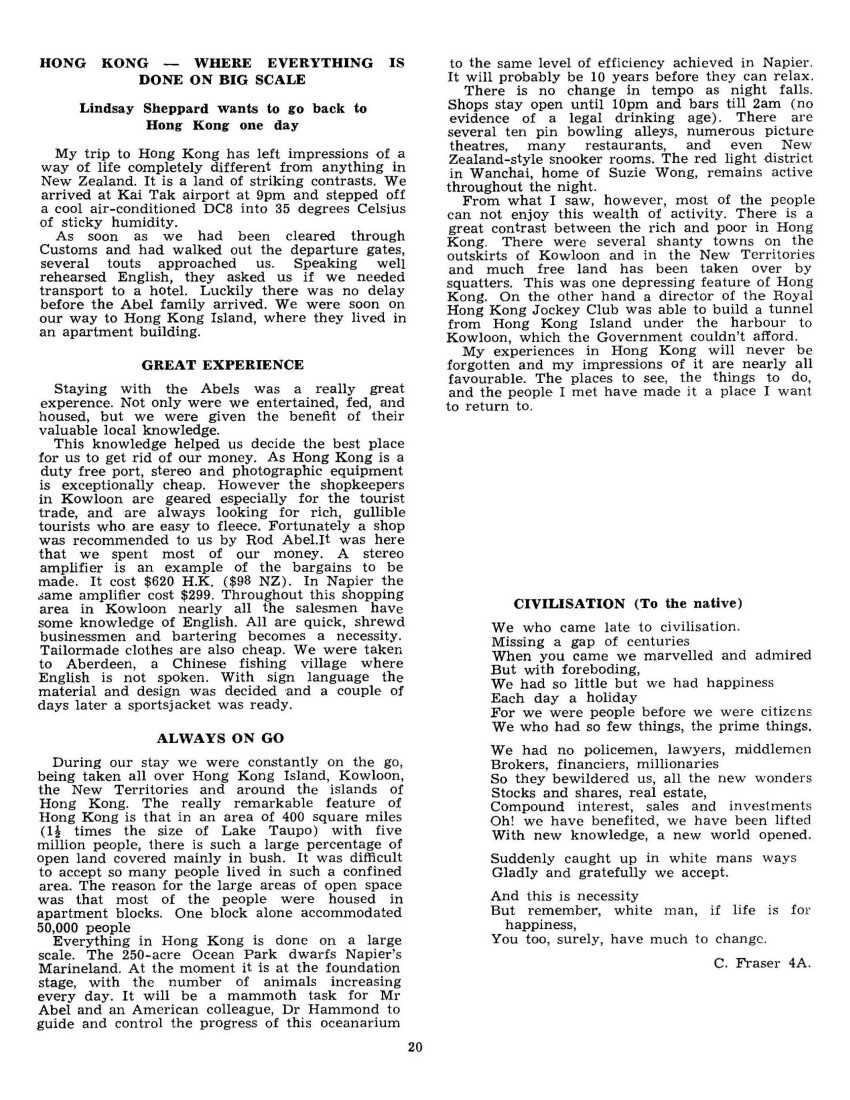
Page 21
THE DESERT
A worn-out carpet of sagebrush and gorse-
grown land,
Splintered bones of grass, dust, silt and sand.
Welding heat, crinkles up the beds of
shrunken pools,
Leaving swathes of baked mud, jigsawed
together.
A carpet of tangled undergrowth,
Guarded by the soldiering cacti, holding
their splintered weapons
The vulture-headed sun lies low, surveying
its moisture-sucked territory,
A petrified chaos.
– A. Mannering.
TWO WORLDS
Dancing sunlight filters through the fingers
Of old, gnarled boughs,
Casting a fiery tinge on all around;
Whispering the hushed secret of natural
beauty.
Thin leaves flutter, as nature’s gentle breath
Bears down upon a dark, lone figure,
Moving, silently, silently,
Across the forest floor.
His footfall follows paths of years ago
When passing through this lonely kingdom
His eyes can see, and his ears can hear,
The courting call of surrounding forest.
The muted roar of falling water,
Echoes the eerie, but strangely, familiar call.
The lonely figure paces on in fading sunlight,
To return to, – WHAT?
The blank, grey walls of the asphalt jungle,
Looming up above the multitude of noisy
cars;
Machines of pollution, devices of man’s
destruction.
He lives in two worlds, – a contradictory
existence.
A. T. Arnold, 5A.
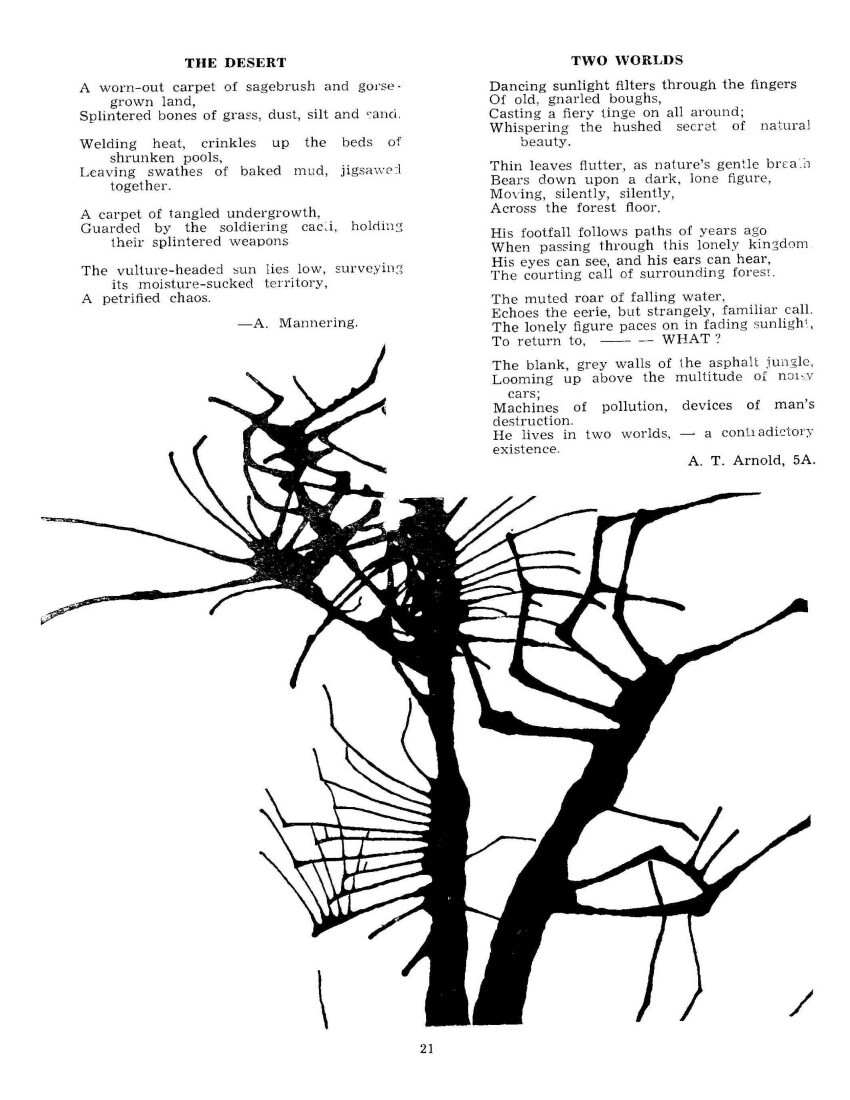
Page 23
ROSS STUART, 5E.
DEFILED
A stark rude oath decorated the wall. A rebellious fanatic had placed it there. It spat defiance at its subject and left a dirty smear in the minds of those who read it. Below children played in all innocence of its meaning but their minds were being slowly twisted by its presence. One child with the seeds of revolt in his mind picked up a piece of charcoal and copied it in his childish scrawl.
– G. Brown, 3A.
STREET OF LONELINESS
The lone, misty street with its dark shadows,
Offers no warmth or welcome to the person
Who bikes silently past,
Eyes straight ahead,
As though staring into nothing
Unmoved by the low, vicious growl of a dog
Who stands looking with a red, droopy tongue
As the figure disappears
Leaving the street to its dark, silent shadows
once again.
– David Bevin, 3A.
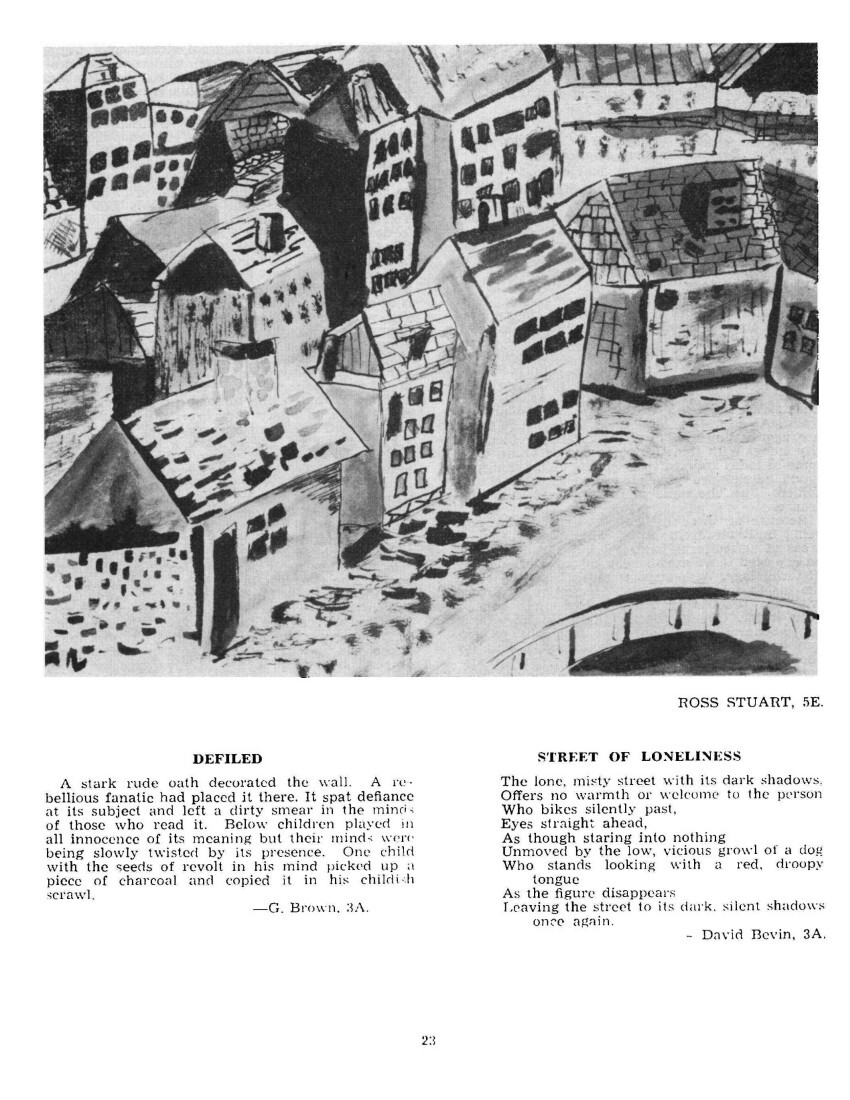
Page 24
THE RUSSELL JONES
MEMORIAL ESSAY 1974
This year’s winner was Guy Mannering of the sixth form. Here is his winning essay:
That Aircraft Technology is Growing Beyond Practical Application
In today’s age of hustle and bustle many values are forgotten. Aircraft technology is measured in how big we can build aircraft and how fast they can travel. Practical application is measured in money terms, not in human terms. The real values of technology are not used in today’s world. Unless something is economical it is left in the wake of technology.
Today commercial aircraft are being built bigger and bigger. This is to reduce the running costs of aircraft as much as possible. An aircraft like the Boeing 747 is a specific case. These planes are of staggering proportions. Although this enables passengers to travel in unprecedented luxury, little regard is paid to any of the environmental factors. The enormous motors of these Boeings are polluting the world’s air without restraint. At aircraft landing sites the exhaust fumes are aggravating the already serious problem of city smog. With the supersonic speeds attained by some of today’s aircraft the effects of breaking the sound barrier are plagueing [plaguing] thousands of householders. Just the noise of these aircraft is a hindrance.
Because of these difficulties airports are now being built far from cities. There is substantial areas of agricultural land lost but this is only to be expected if we are to keep at our glorious rate of technology. With airports miles from the cities the distance is too far for commuters to travel with any practicality. Aircraft technology can be quite ironic. One of the air flights in USA takes an unbelievable one hour. But ironically passengers have to wait up to an hour and a half for their luggage. The rate of technology at the airport has not kept up with aircraft technology. Aircraft technology has gone beyond practical application.
The best single example is the Concorde project. The aircraft is an utter failure. The plane requires such a long landing strip that few airports can handle it. Even with their speed they are of no practical use for short distance flights. For the millions of everyday commuters this advance in aircraft technology is of no use. Maybe on the long distance flights such as trans-Atlantic trips could it be of economic value. But because of the congestion at the international airports and other time wasting problems the supersonic speed of this aircraft is not utilised.
If aircraft technology advances are to be of any use to man the rest of his technology must be at the same level.
THE VALUE OF THE MONARCHY IN THE COMMONWEALTH
This is the speech written by Phillip Hazell which succeeded in winning the Anthony Eden Cup for Public Speaking. It was a tremendous effort and he achieved a great victory overpowering the strong opposition from all over New Zealand. The contest was organised by the members of the Overseas League and this year was held in the War Memorial Hall in Napier.
Mr Chairman, Ladies and Gentleman. This evening I am going to take you shopping. We won’t be buying anything but that won’t stop us from being able to evaluate the item in question – the Monarchy in the Commonwealth. When you go shopping the first thing you do is pick up the item you’ve got in mind and have a look at it. You ask yourself, “Will it do the things I want it to do?” It also pays to make sure it won’t do the things you don’t want it to do. “Is it good quality; is it durable?” and finally, “Is it fair value for money or could I perhaps get something equally as good for half the price elsewhere?” The product is of course the Monarchy, and for tonight anyway you will be the member nations of the British Commonwealth, the buyers. Australia, Canada, Tonga, New Zealand, and so on and on.
Well let’s have another look. The Monarchy. In our case a constitutional Monarchy. It is something of an antique, and the remarkable thing about antiques is that, while to some people they are of great value, to others they are items which would be better off left in an attic gathering dust.
First of all I’d like to have a look at some of the things our product doesn’t do. I’ve consulted some of the literature on the subject, the Consumer reports if you like, from which I’ve obtained the following comments. Professor Miller, a political scientist from Leicester University in England, said of the Quen’s [Queen’s] role as Head of the Commonwealth; “the office, if it can be called such, has no powers or activities attached to it”. “On the other hand, Sir Ivor Jennings said in his book, “The Queen’s Government”, that the Queen was the “essential link” in the Commonwealth. If you tie these two seemingly contradictory phrases together you can see that the Queen is important simply because she exists. At the risk of using a cliche, she is a figurehead. The fact that she has no real power is probably an advantage as far as the member nations of the Commonwealth are concerned. Let’s face it, if you went into a shop to buy a ceremonial sword for your living room, you wouldn’t buy one of those huge old Scottish broadswords, because you’d then run the risk of your 5-year-old son using it to decapitate his 3-year-old sister. No, you’d buy something a little more modest and certainly a lot less lethal.
But I feel that the Queen, and other members of her family, are of value to the Commonwealth because they promote a quality of living, on an idealistic plane the Royal Family is everything a good family should be, no scandals, no unmarried pregnant daughters, no broken homes, but at a more practical level, the members of the Royal Family are involved in many institutions and organisations which have the promotion of a quality of living as their aim. They’re either patrons, or active members and supporters, and because they are a group of people who are, let’s face it, forever in the public eye, they’re able to provide publicity for the aims of these organisations. Take for instance the National Institute for the Blind, the New Zealand counterpart of which is the Foundation for the Blind, or even the Royal schools of
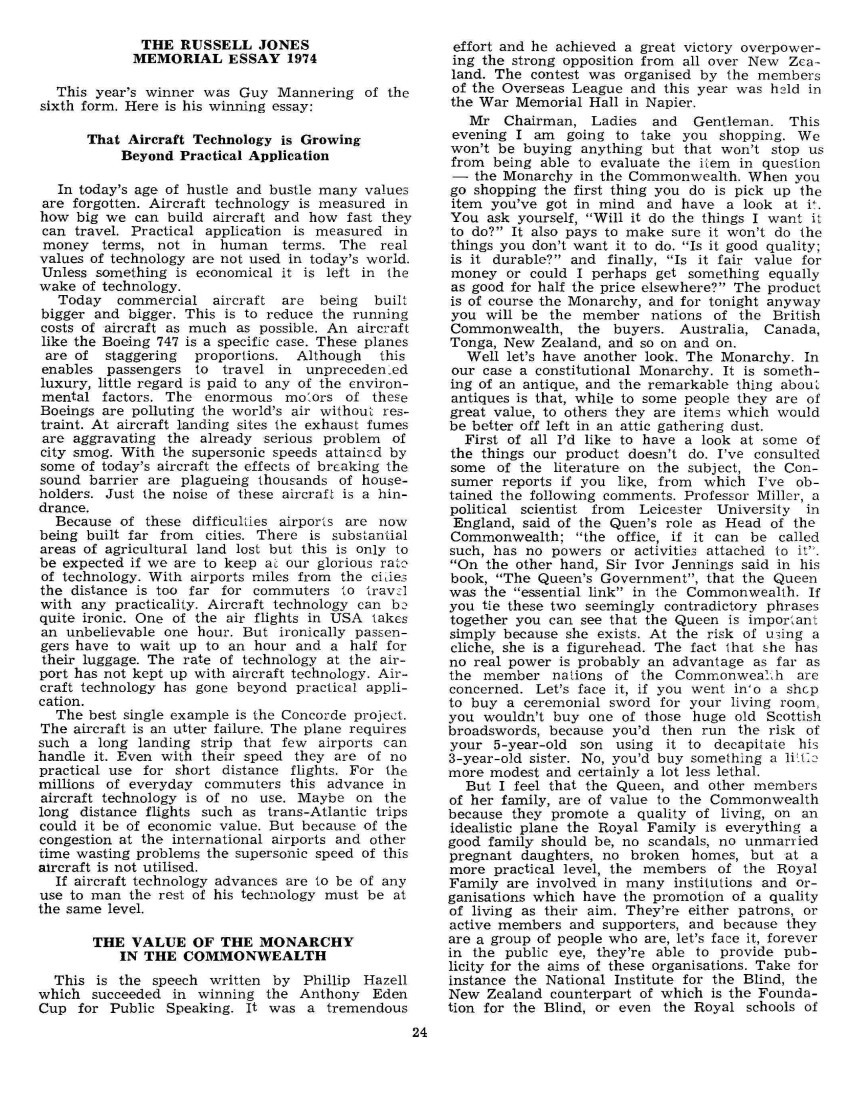
Page 25
music, a London based institution which sends examiners throughout the Commonwealth to maintain a high standard of musicianship.
The Queen is also important because she provides a link with the past, and political stability. We in the Commonwealth have never lived without a monarch, but let’s take in contrast a group of people who have. In December 1967 the Greeks ousted King Constantine and have since been ruled by a military junta. They now want him back, to provide political stability.
The reset question, is the product good quality, is it durable? Well, 22 years isn’t bad for one Monarch. But for all its pomp and tradition, the Monarchy, unlike the obvious alternative of an elected president, is above corruption. It is inconceivable that the Queen would compromise her integrity by being involved in anything even approaching a Watergate affair.
Finally, is the product fair value for money? In terms of cold, hard cash it is expensive. The Queen is paid an allowance of £980,000 a year, her husband £65,000, her mother £95,000, Princess Margaret £35,000. But this only affects the British taxpayer, what hits your pockets are the costs involved in maintaining a Governor General, and the heavy expenses incurred during royal visits. But the manufacturers know they can keep their prices up, because they’ve got a monopoly on the market. You can’t go around to the corner shop and buy a Monarchy. The Monarchy isn’t the sort of item which rolls off a production line at the rate of several hundred an hour. The Monarchy is a product, but a product which has been fashioned by history.
In conclusion, Mr Chairman, Ladies and Gentleman, for the last six minutes or so we’ve been looking at a product. It has no real power but it is of value because it promotes a quality of living as well as providing a link with the past and political stability. It is above corruption. In purely cash terms it is expensive, but I contend that it is fair value for money. However, due to the nature of the product I think it is really up to you, the member nations of the British Commonwealth, to decide whether the Monarchy is something of great value, or an item which would be better off left in an attic, gathering dust.
P. HAZELL, 7
ACCIDENT
10.47, the first sirens,
Already 30 spectators,
Tangled wreckage,
Capturing their glances.
S. Hiha, 5A.
TRAFFIC JAMS
Traffic jams last for hours,
People stay in their cars – wanting to get
home … to hot showers,
Dust, fumes everywhere,
Getting up noses, and in people’s hair,
Mustangs, Volkswagens, convertibles jam-
med together,
Not more than a hand apart,
Then there’s a signal… but a false start.
– Mark Coveny, 3E.
BOATS
Floorboards creaking,
Tacking the wind.
The orange sky brights.
Cream sails flapping under strain
Salty sea air hanging heavily,
Spray drifting across decks
Rewarding fishy smell.
Heading home,
Night
– G. Hard, 3A.
TO BE A FUGITIVE
To be a fugutive [fugitive] is to be alone
And on the run,
Always looking back
In case someone is right behind you.
Getting closer and closer
Ready to sieze [seize] you or shoot you down
You’re always hiding
In ditches, gutters and in
The cold, rain and snow
Trying to keep yourself warm
With only the rage you possess
Scrounging and begging for your food
But not sure if you can trust anyone.
Because they might report you to the police
Or send you to a camp for the rest of your life.
You’re always moving on,
Never staying in one place too long
And always meeting new adventures
Dangerous and sad ones
You long for someone to comfort you
And someone to talk to
As you go along your way
But someday you hope this running
Will soon end
And you become a normal citizen
And no longer a fugitive.
– Davis, 3D
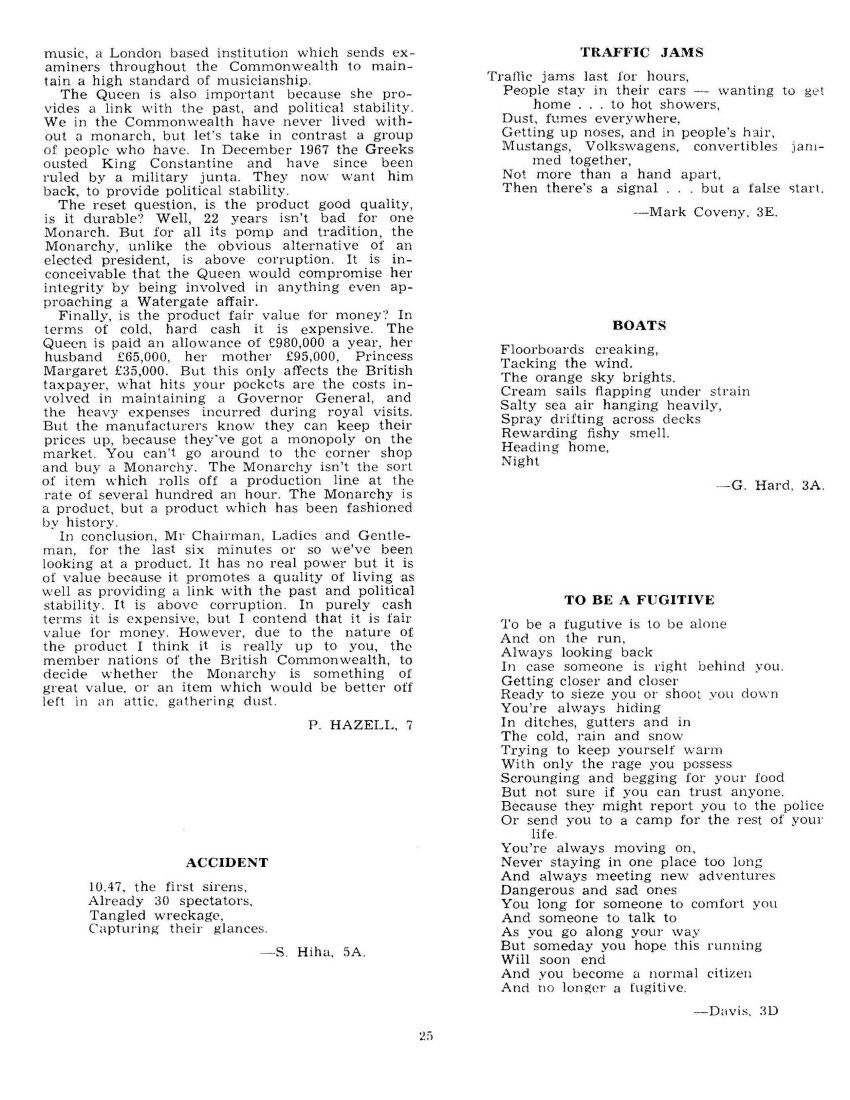
Page 27
TRANSFORMATION
A boy,
Gazes at a sea; angry and powerful,
That pounds a beach; grey and sombre,
Under a dark, heavy sky.
Deafened by the chorus of thunder and waves,
Stung by the keenness of salt-laden wind,
He stands entranced.
A captive of the mystic beauty,
A captive of the want of freedom
A man.
A man.
Turns his back on the sea; angry and powerful
That pounds the beach; grey and sombre,
Under that dark and heavy sky,
And walks from the deafening chorus,
From the salt-laden wind,
Back into the city, society, civilisation,
A boy.
– P. Bull, 5A.
AN ELDERLY PERSON
An elderly woman sits at home alone,
Too tired to answer the phone,
Shut away in a pensioner’s flat,
Her only companion a neighbour’s cat.
Each day she rests her tired bones,
Worn by years of toil and pain,
Surrounded by other pensioner flats
Now the only world she knows.
She has been shut away so long,
Far away from the teenage throng.
This is where she’ll spend the rest of her days
Alone and forgotten until she dies.
– Coveney, 3E.
FATHER SAYS
Father says
never
let
me
see
you
doing
that
again
father says
tell you once
tell you a thousand times
come hell or high water
his finger drills my shoulder
never let me see you doing that again.
My brother knows them all off by heart
so we practice them in bed at night.
R. Hall (3A)
AN OLD MAN
He watched the hustling flock of birds,
From the steps.
His mouth was drooping.
His hair all tousled.
He stared at the birds.
Pigeons cawing
The birds cringe at each soft step of a man
throwing food to them.
The children laughed and he just cried,
Wondering where on earth he’d die.
An old man without a home
No-one loves him
No-one likes him
Forlorn and stooping
Face all drooping
Crying on the steps he sat.
– R. Cavaney, 3A.

Page 28
SKY-DIVERS
One by one they drop,
Arms outspread, embracing
The rushing air.
They twist and turn,
Manipulating the sky.
Not a sound, except the
Gentle hissing of the wind.
Slowly the underworld turns
From grey to green.
A patch-work of land below.
Inviting them to land.
Above a great white bloom billows.
Lowering them down,
To the world of civilisation.
– Chris Waring 3A
CINQUAINS
Engines,
Throbbing dully,
Powering great machines
Moving the unwitting earth
Great, squat, shuddering metal boxes.
Machinery,
Whirring wheels
Clicking metal cogs.
Just one small piece
In the whole huge system.
– C. Jones, 3A.
DEADLY COINCIDENCES
Presidents Lincoln and Kennedy:
Both of these Presidents were concerned with the issue of civil rights: Lincoln was elected in 1860; Kennedy was elected in 1960.
Both were assassinated on a Friday in the presence of their wives.
Both were shot from behind and in the head.
Their successors, both named Johnson, were Southern Democrats and both were in the Senate. Andrew Johnson (Lincoln’s successor) was born in 1808 and Lyndon Johnson (Kennedy’s successor) was born 1908.
John Wilkes Booth (Lincoln’s assassin) was born in 1839. Lee Harvey Oswald (Kennedy’s assassin) was born in 1939. Booth and Oswald were both killed before going to trial.
Lincoln’s secretary, whose name was Kennedy, advised him not to go to the theatre. Kennedy’s secretary, whose name was Lincoln advised him not to go to Dallas.
John Wilkes Booth shot Lincoln in the theatre and ran to a warehouse. Lee Harvey Oswald shot Kennedy from a warehouse and ran to a theatre.
The names Lincoln and Kennedy each contain seven letters.
The names John Wilkes Booth and Lee Harvey Oswald each contain fifteen letters.
The names Andrew Johnson and Lyndon Johnson each contain thirteen letters.
Submitted by A. T. Arnold 5A.
JAMIE BEATON, 6B
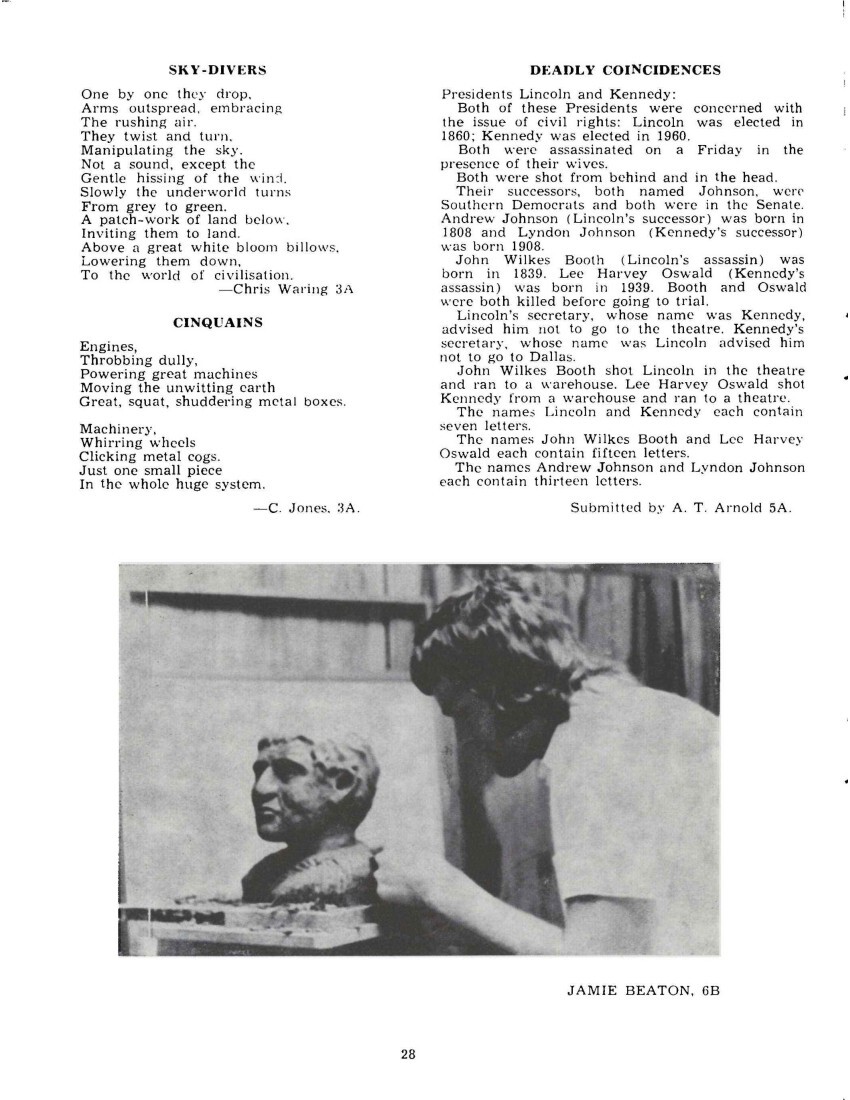
Page 29
SCINDIAN INTERVIEW WITH CHIP DANIELS, ROTARY EXCHANGE STUDENT FROM AMERICA, AUGUST 25th 1974 – JULY 1975
Scindian: Chip, what are the basic differences between American schools and Napier Boys’ High?
Chip: School at Napier Boys’ High is quite a change from high schools in America as practically all American schools are coed, so the most obvious difference is the absence of girls. Another obvious difference is in dress. American schools have no dress code and students come to school dressed mostly as they please, so long as it is decent.
Scindian: What is the population and location of your school
Chip: The high school I attended in Lakeland, Florida, had a student population of 2400. There were 670 in the graduating class of 1974.
Scindian: Do you have any racial problems at school:
Chip: In past years racial disturbances plagued the school but presently the climate is friendly.
Scindian: What are your school hours and how do pupils commute?
Chip: School starts at 7.20 am. and is over at 1.45 p.m. Most students reach school by car while the remainder come in buses. (The driving age is 16).
Scindian: Could you compare school academic standards?
Chip: The academic standards of New Zealand high schools is higher than that of American high schools. Most American students with ability continue on from high school to attend university. The curriculum of American high schools is more varied with subjects such as Bible literature, film making, home economics, choirs, auto mechanics, metalworking, art, black literature. Some broad areas of study are subdivided, such as mathematics which is split up into geometry, algebra I, II, III, and trigonometry.
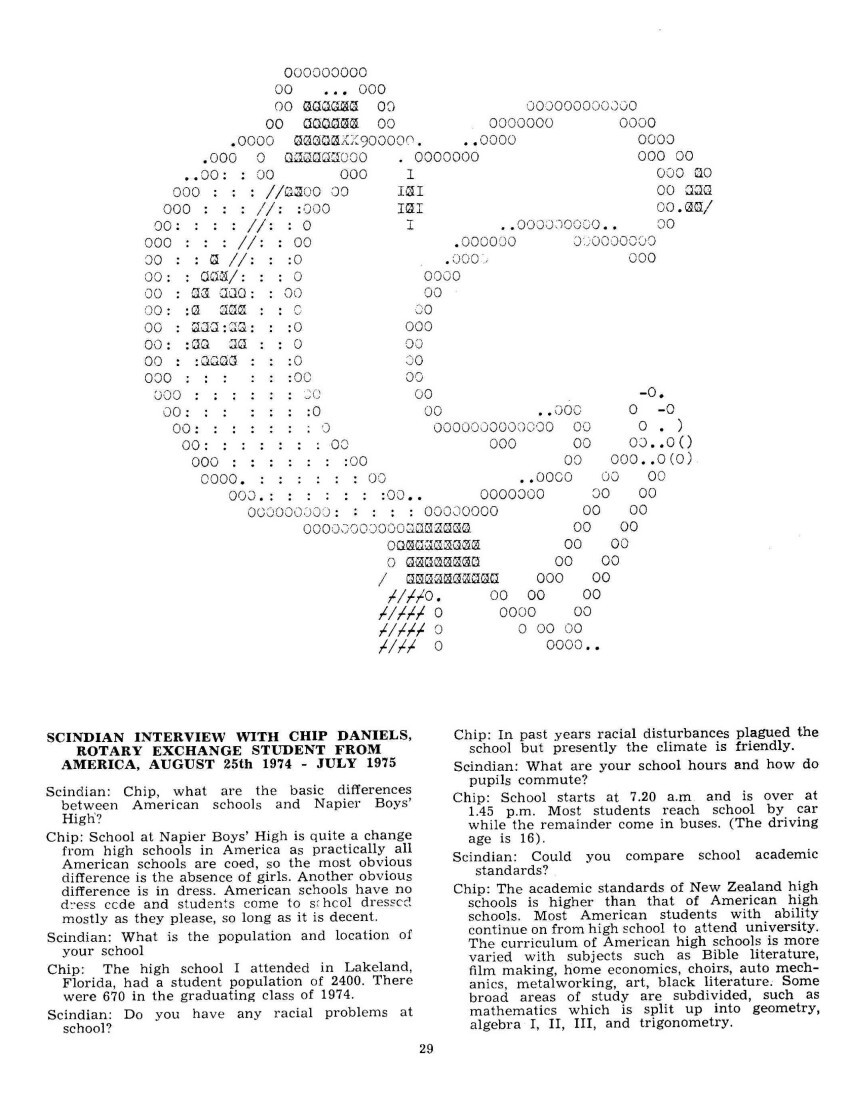
Page 30
Scindian: What sporting activities are offered to the students?
Chip: Sports in American high schools are grid-iron football, basketball, baseball, track, cross-country, wrestling, weightlifting, tennis, swimming and golf. Football is the major sport and it is taken very seriously. Football practice is held every morning before school starts, and every afternoon. All games are held at night and crowds of 10,000 are often drawn. Before the game the players sit together in silence for 3 hours to get ‘psyched up’. During Homecoming Week, a Queen and a King are selected from the student body on the basis of looks and personality. They are crowned at the homecoming football game. A dance follows the game.
Scindian: What happens when school is over for the week?
Chip: On the weekends, the social life becomes active. Apart from parties, there are drive-in movies, rock concerts and hamburger joints. The pizza parlours are usually full. Occasionally there is a dance. The most popular dance of the year is the prom. Dress for the prom is formal gowns for the girls, and tuxedos for the boys. On the first week of the three-month school holidays, a good portion of the student body heads for the ocean and a fun-filled “beach week”.
Scindian: Is there any form of student publication at the high school?
Chip: At my school there are three different publications: ‘The Bagpipes’ is a weekly school newspaper; ‘The Tamoshanter’ [Tam o’ Shanter], which is a magazine with poems, art and short stories, is published twice a year; and ‘The Highlander’, which is the school year book. It contains each student’s picture and includes photos of the year’s highlights.
Scindian: Thank you. It is always interesting to hear how our system of education compares with elsewhere.
THE LIVING DEAD
Land,
Barren,
Stretches out far and wide,
Yielding nothing,
Nothing but two children,
Who,
With dead eyes and hunger bloated stomachs.
Sit,
Like stone statues,
Waiting,
Waiting for the world of millions to feed
them,
This world of millions,
They call these children
The Living Dead.
G. Goldsmith 4A.
A SUFI GIVES A LESSON ON THE VALUE OF MONEY
There lived in the province of Assam a wise old Sufi, who one day sat on the steps of the Holy Temple, giving a lesson. He said to each one of his five pupils:
“I will give you ten silver pieces. Go into the village and spend them prudently.” The first pupil went into the village and bought a bullock. The second, several books on the teachings of Mohammed. The third pupil gave all his ten silver pieces to a blind man he found begging in the streets. The fourth made an anonymous donation to the Holy Temple. The fifth man gave all his silver pieces to Abdul Raman, the richest man in the village.
The following day the Sufi once again met his pupils on the steps of the Holy Temple. He asked each one in turn:
“How did you spend your ten silver pieces?”
The first pupil said, “I have bought a bullock which will help me to tend the fields.”
The Sufi replied, “You are lazy. You could tend the fields equally as well without the animal. Go and tend your fields, and cease to engage your mind in philosophy.”
The second pupil said, “I have bought several books on the teachings of Mohammed, so that I can understand the word of the Koran.”
The Sufi replied, “You are a fool. Is not the word of Mohammed enough? Go and read your books, but cease to engage your mind in philosophy.”
The third pupil said, “I have given my ten silver pieces to a blind man, because I thought he was most needy”.
The Sufi replied, “You are a murderer. Could you not see that the blind man would be set upon by robbers and beaten? Go and find the blind man and cease to engage your mind in philosophy.”
The fourth pupil said, “I have donated my money to the Holy Temple.”
The Sufi replied, “You are a hypocrite. You know that it is the Temple that can help you, and not the opposite. Go and pray in the temple, and cease to engage your mind in philosophy”.
The fifth pupil said, “I have given the ten silver pieces to Abdul Raman, the richest man in the village.”
The Sufi replied, “You alone have acted wisely. Money corrupts, therefore it is least harmful to give it to the man who is already the most corrupt.”
– Anon.
BITTEN
The dainty insect flutters on the surface of
the stream,
The fat brown trout snaps for it;
The little insect has the sting of a bee,
And we had trout for tea.
A. S. McLay 3E.

Page 32
SWIMMING SPORTS
Results of the Tabloid Swimming held at the School Pool on Friday, February 8th:
First Scinde, 375 points.
Second Clyde, 344 points
Third Hawke, 312 points.
Fourth Napier, 308 points.
Results of the Championship Swimming Sports held at the Olympic Pool on Friday, February 15:
Junior Championship:
100 metres Freestyle: P. Chen (H) 1. T Yates (N) 2. H. Macdonald (S) 3. 71.5secs.
50 Metres Freestyle: P. Chen (H) 1. S. McLean (C) 2. G. Wright (C) 3. 31.5 secs. Record
50 Metres Butterfly: P. Chen (H) 1. G. Cottrell (H) 2. R. Mildon (N) 3. 35.6 secs.
50 metres Breaststroke: P. Chen (H) 1. S. Dagg (C) 2. J. Zorn (C) and C. Fraser (H) 3. 40.9s.
50 Metres Backstroke: P. Chen (H) 1. M. Andrews (H) 2. M. Lampitt (S) 3. 41.0 secs.
1974 SWIMMING CHAMPIONS
From left: B. I. Strong, J. F. Marsden, P. S. Chen.
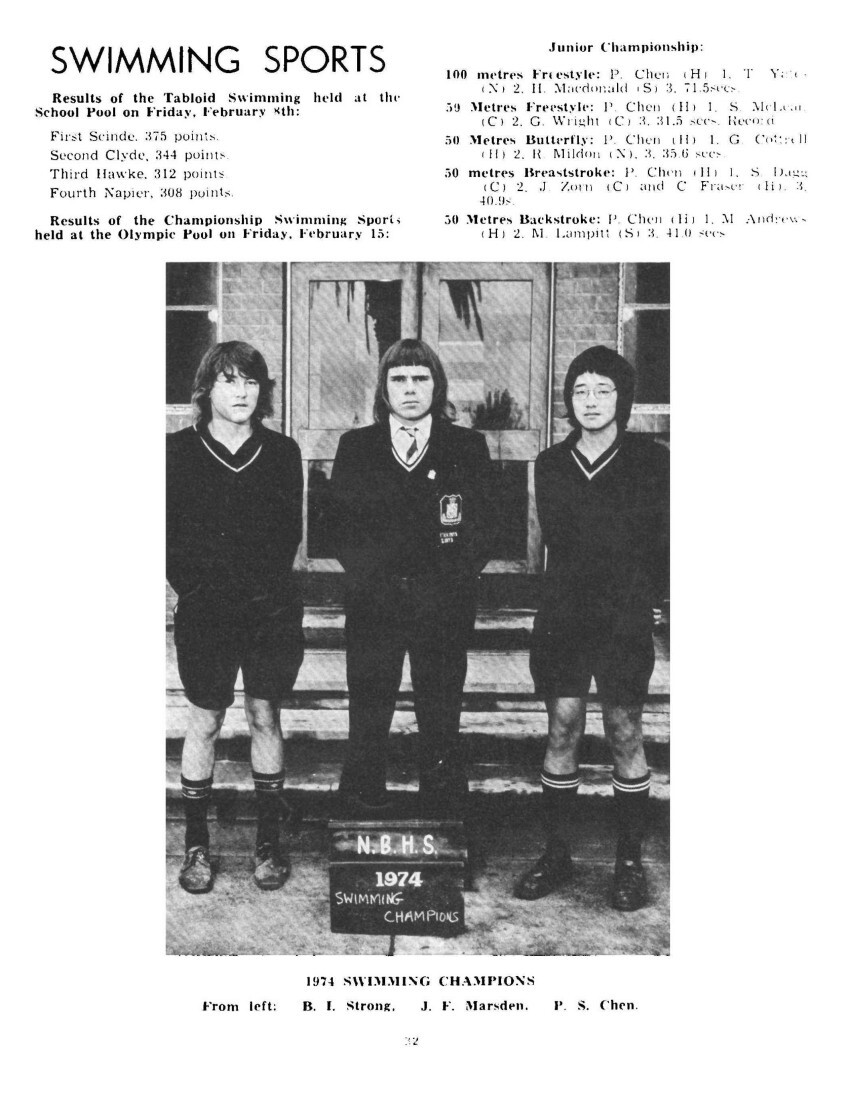
Page 33
Intermediate Championship:
200 Metres Freestyle: B. Strong (N) 1. P. Reeve (H) 2. M. Cadman (C) 3. 2mm 58.5 secs
100 Metres Freestyle: M. Allen (N) 1. B. Strong (N) 2 B. Muggeridge (S) 3. 71.9 secs.
50 Metres Freestyle: M. Allen (N) 1. J. Cottrell (H) 2. B. W. Muggeridge (S) 3. 32.5 secs.
50 metres Butterfly: B. Strong (N) 1. A. Bryson (C) 2. M. Digman (N) 3. 38.6 secs.
50 Metres Breaststroke : B. Strong (N) 1. G. Wright (C) 2. M. Cadman (C) 3. 46.0 secs
50 Metres Backstroke: A. Costello (N) 1. M. Bicknell (N) 2. D. Gempton (C) 3. 40.9 secs.
Senior Championship:
200 Metres Freestyle: J. Marsden (H) 1. P. Bloor (N) 2. S. Groves (N) 3.2mins 46.9 secs.
100 Metres Freestyle: J. Marsden (H) 1. P. Fleischel (C) 2. D. Pearson (H) 3. 69.6 secs.
50 Metres Freestyle: J. Marsden (H) 1. D. Pearson (H) 2. S. Muggeridge (S) 3. 31.2 secs.
50 Metres Butterfly: P. Fleischel (C) 1. J. Marsden (H) 2. S. Groves (N) 3. 36.5 secs.
50 Metres Breaststroke: P. Fleischel (C) 1. S. Groves (N) 2. B. Burgess (H) 3. 41.3 secs.
50 Metres Backstroke: P. Bloor (N) 1. P. Fleischel (C) 2. J. Marsden (H) 3. 38.0 secs.
Championship Swimming:
The Championship Swimming Sports were held at the Onekawa Pool on Friday, February 15. 1974. The races were keenly contested and thoroughly enjoyed by competitors, spectators and officials.
Champions:
Junior: Paul Chen (Hawke).
Intermediate: Bruce Strong (N)
Senior: John Marsden (H).
House Points:
First, Hawke, 184 points.
Second Scinde, 126 points
Third Napier, 117 points
Fourth Clyde, 108 points.
1974 SWIMMING TEAM
Standing from left: Coach, Mr D. A. Paxie, M. Allen, B. W. Muggeridge, J. F. Marsden, M. S. Bicknell, B. I. Stron.
Sitting from left: P. J. R. Reeves, M. R. Pedersen, K. P. McLeod, A. S. Bryson, P. S. Chen.
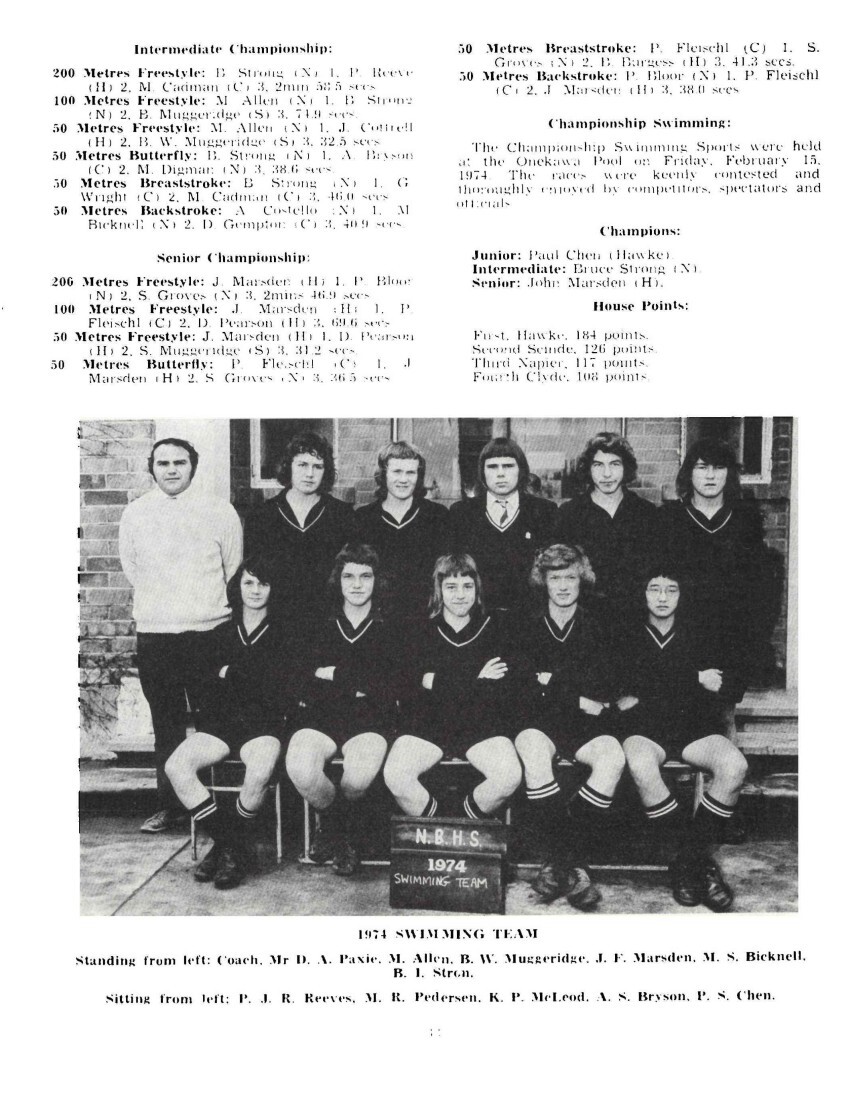
Page 34
Record Broken:
50 Metres Junior Boys Freestyle: Paul Chen (Hawke) 31.5 secs.
OPEN AND NON-CHAMPIONSHIP
SWIMMING RESULTS
Open Events:
Pyjama Race: B. Fisher (N) 1, Clifton (S) 2, M. Pedersen (S) 3.
400 Metres Freestyle: P. Chen (H) 1, P. Bloor (N) 2, G. Cottrell (H) 3, 6 min. 27 sec.
Surfboard Race: G. Wright (C) 1, R. Meyer (H) 2, P. Hazell (H) 3, 56.7 sec.
Diving: H. Thomsen (S) 1, R. Willis (H) 2, K. Baker (S) 3.
Junior Non-Championship:
100 Metres Freestyle: W. Morris (N) 1, A. Schwalger (N) 2, T. Morton (S) 3, 86.3 secs.
50 Metres Freestyle: H. MacDonald (S) 1, T. Morton (S) 2, G. Davidson (C) 3, 34.4 secs.
50 Metres Breaststroke: G. Cottrell (H) 1, H. Hutchieson (C) 2, A. Claudatos (H) 3, 48.6
secs.
50 Metres Backstroke: J. Zorn (C) 1, R. Mildon (N) 2, R. Waite (N) 3, 47.7 secs.
Intermediate: Non-Championship
100 Metres Freestyle: P. Reeves (H) 1, S. Hogg (H) 2, G. Wright (C) 3, 79.6 secs.
50 Metres Freestyle: C. Rogers (H) 1, P. Clements (C) 2, R. Glenny (H) 3, 32.5 secs.
50 Metres Breaststroke: K. McLeod (S) 1, J. Trinick (S) 2, T. Dockery (H) 3, 47.0 secs.
50 Metres Backstroke: P. Leary (C) 1, P. O’Niell (H) 2, M. Rofe (S) 3, 43.0 secs.
Senior Non-Championship:
100 Metres Freestyle: S. Tolley (S) 1, P. Bowley (S) 2, S. Bannister (N) 3, 84.6 secs.
50 Metres Freestyle: S. Tolley (S) 1, J. Du Four (N) 2, J. Gorringe (S) 3, 34.6 secs.
50 Metres Breaststroke: D. McLay (S) 1, J. Fitzgerald (N) 2, L. Sheppard (N) 3, 47.9 secs.
50 Metres Backstroke: S. Paget (S) 1, P. Gosling (N) 2, D. Mudgeway (H) 2, 43.0 secs.
H.B. SECONDARY SCHOOLS SWIMMING MEET
Results: Of the Hawke’s Bay School Swimming meet held at the Hastings Aquatic Centre on Saturday, February 23, 1974.
Firsts:
Junior: Paul Chen, 100 metres Breaststroke, 1min. 23.5 sec. Paul Chen, 50 Metres Breaststroke,
40 secs.
Senior: Peter Bloor, 100 metres Backstroke, 1min 23.8 secs. John Marsden 100 metres Freestyle
70 secs.
Thirds:
Senior: Paddy Reeves, 400 metres Freestyle. Peter Bloor 50 metres Backstroke.
NORTH ISLAND SECONDARY SCHOOLS MEET
Our sole representative, Paul Chen, dominated the Breaststroke events at the North Island Secondary Schools Swimming Meet held in Palmerston North in March. Paul won both the 100 metres and 200 metres Breaststroke in the Junior section. Congratulations Paul!
ATHLETIC SPORTS
This year’s school athletic sports was one of the main highlights of the school’s sporting year. Standards set were extremely high and were helped considerably by the fine weather which prevailed on the day.
As a result of dedicated training by some athletes a number of records, some long standing, were broken or equalled. In the Junior Grade, M. Stephenson equalled the high jump record of 5’-2”; M. Hutchinson bettered K. Morgan’s 1958 triple jump record with a new distance of 11.90 metres and C. Smith, showing considerable natural ability and potential, broke T. Dobbs 1973 discus record with a throw of 39.56 metres. Only record to fall in the intermediate grade was in the javelin, where M. Perry established the new mark of 146’-3”. New senior records were established by K. Chadwick in both the javelin and discus. Performing extremely well, Chadwick was able to extend the javelin record to 160’-8” and the discus record to 42.28 metres.

Page 35
Scinde House again displaying a higher standard of fitness and athletic ability came home a comfortable leader in terms of House points (611). Other houses finished in the following order Napier 431, Clyde 311 and Hawke 186.
Individual champions for 1974 were as follows:
Junior: M. Hutchinson 20 pts., C. Smith 14 pts., Yeoman 11 pts.
Intermediate: P. Catley 16 pts., S. Wedd 11 pts., T. Dobbs 10 pts.
Senior: I. McRae 20 pts., K. Chadwick 15 pts., Oldershaw 7 pts., Prebble 7 pts.
JUNIOR
100M: Yeoman (S) 1, Hardwick (H) 2, Church (C) 3. 12.9.
200M: Hutchinson (C) 1, Strawbridge (S) 2, Davis (N) 3. 26.8.
400M: Hutchinson (C) 1, Rofe (S) 2, Fraser (H) 3. 58.9.
800M: Hutchinson (C) 1, Yeoman (S) 2, McGurk (S) 3. 2.16.1.
1500M: Dagg (C) 1, Young (S) 2, Christenson (C) 3. 5.5.5.
100M Hurdles: Strickland (S) 1, Lowe (N) 2, Groom (H) 3. 18.3.
Long jump: Stephenson (H) 1, Smith (N) 2, Strickland (S) 3. 5.08m.
High jump: Stephenson (H) 1, Yeoman (S) 2, Fraser (N) 3. 5’ 2” equals record.
Triple jump: Hutchinson (C) 1, Smith (N) 2, Moreton (S) 3. 11.90m record.
Javelin: Neal (C) 1, Smith (N) 2, Wilcox (C) 3. 110’ 8”.
Discus: Smith (N) 1, Mataira (H) 2, McGurk (S) 3. 39.56m record.
Shot put: Collins (S) 1, Wallace (C) 2, Davidson (C) 3. 10.06m.
Relay: Scinde 1, Clyde 2, Napier 3, 52.9.
INTERMEDIATE
100M Catley (S) 1, McIntyre (N) 2, Bull (N) 3. 12.2.
200M: Catley (S) 1, Wedd (S) 2, Richardson (H) 3. 24.2.
400M: Lampitt (S) 1, Westbury (H) 2, Rolls (H) 3. 56.9.
1974 ATHLETICS TEAM
Top Row from left: R. Ruru, P. S. Neal D. H. Wilcox, R. L. Yoeman, P. Catley, M. J. Stephenson, M. M. Hutchinson.
Middle Row from left: J. C. Dagg, M. J. Rofe, P. E. McDougall, C. A. Kersey, J. R. McGusk, J. W. Mataira, E. P. Wallace, C. J. Strickland, coach Mr M. D. Mear.
Sitting from left: I. C. Sayer, G. A. McDonald, R. G. Prebble, S. J. Borrie, I. C. McRae, L. J. Sheppard, T. H. Foote, D.J. Horrick.

Page 36
800M: Kersey (H) 1, Moffat (S) 2, Buchanan (S) 3, 2 10.3.
1500M: Yeoman (C) 1, Kersey (H) 2, McDougall (S) 3. 4.29.6.
100M Hurdles: Wright (N) 1, Catley (S) 2, Johnstone (H) 3. 15.7.
Long jump: Wedd (S) 1, Catley (S) 2, Hargraves (N) 3. 5.67m.
High jump: Ironside (S) 1, Hargraves (N) 2, Perry (S) 3. 4’10”.
Triple jump: Wedd (S) 1, Catley (S) 2, Johnstone (N) 3. 11.97m.
Javelin: Perry (S) 1, Wedd (S) 2, Steele (S) 3. 146’ 3” record.
Discus: Dobbs (S) 1, Ironside (S) 2, Hargraves (N) 3. 40.87m.
Shot put: Dobbs (S) 1, Hargraves (N) 2, Bicknell (N) 3. 12.50m.
Relay: Scinde 1, Napier 2, Hawke 3. 49.4.
The following boys gained places in their events:
SENIOR
100M: McRae (C) 1, Purcell (N) 2, Prebble (C) 3. 12.1.
200M: McRae (C) 1, Prebble (C) 2, Purcell (N) 3. 24.0.
400M: McRae (C) 1, Herrick (N) 2, Muggeridge (S) 3. 55.5.
800M: McRae (C) 1, McDonald (N) 2, Herrick (N) 3. 2.6.1.
1500M: McDonald (N) 1, McGurk (S) 2, Herrick (N) 3. 4.28.9.
110M Hurdles: Sayer (N) 1, Prebble (C) 2, Herrick (N) 3.
Long Jump: Muggeridge (S) 1, Purcell (N) 2, Borrie (S) 3. 5.71m.
High Jump: Oldershaw (N) 1, Torr (S) 2, Burgess (N) 3. 5’ 3 1/4.
Triple Jump: Borrie (S) 1, Oldershaw (N) 2, Purcell (N) 3. 11.68m.
Javelin: Chadwick (C) 1, Dempsey (C) 2, Gorringe (S) 3. 160’ 8” record.
Discus: Chadwick (C) 1, Foote (S) 2, Herrick (N) 3. 42.28m record.
Shot Put: Chadwick (C) 1, Stancombe (N) 2, Foote (S) 3. 13.32m.
Relay: Clyde 1, Napier 2, Hawke 3. 48.2.
Juniors
High jump: Stephenson 2nd, Yeoman 3rd. Long jump: Stephenson 3rd. Triple jump: Hutchinson 1st. (11.39m). Shot put: Collin 3rd. 100m hurdles: Strickland 2nd. 200m: Church 2nd. 400m: Hutchinson 2nd. Relay: Napier 1st equal (50.5s).
Intermediate
Triple jump: Wedd 2nd. Discus: Dobbs 1st (42.38m). Javelin: Perry 2nd. Shot put: Dobbs 2nd. 100m: Catley 2nd. 200m: Catley 2nd. 400m: Lampitt 3rd. Relay: Napier 1st (48.0s).
Seniors
High jump: Oldershaw 3rd. Triple jump: Borrie 1st, Sheppard 2nd (11.87m). Discus: Chadwick 1st (42.54m). Javelin: Chadwick 2nd. Shot put: Chadwick 1st (13.33m). 400m: McRae 2nd. 800m: McDonald 2nd. 1500m: McGurk 3rd. Relay Napier 2nd.
Relays:
Junior: Scinde 1, Hawke and Clyde, 2 equal, 2mins 28.2 secs.
Intermediate: Hawke 1, Napier 2, Scinde 3, 2mins 18.2 secs.
Senior: Scinde 1, Hawke 2, Clyde 3, 2 mins. 15.9 secs.
Combined: Scinde 1, Hawke 2, Clyde 3, 7 mins 5.6 secs.
From the place getters in the school athletic sports, a team was selected to represent the school at the Hawke’s Bay Secondary Schools Athletic Championships held at Hastings on March 23rd. As can be seen from the number of placings that follow, Napier Boys’ High School was one of the strongest schools competing.
CRICKET
1st XI CRICKET
This year’s team consisted of: D. Pearson (captain), R. Sutherland, D. Herrick, L. Sheppard, G. Smith, J. Cotterell, S. Eddy, R. Danks, M. Perry, M. Heath, M. Sweetapple and D. Harper.
The team was basically the same as last year’s, with seven members returning. Playing in the Second Grade A competition, the team performed creditably, if at times a little inconsistently. In this grade where competition is keen, the team secured a good fourth place.
A highlight of the season was the two centuries scored by Russell Sutherland in a club competition which contains many crafty and skilled bowlers. Another highlight was the inclusion of David Pearson in the New Zealand Secondary Schools’ Cricket Team which toured Australia at the beginning of the year.
In school matches we fared reasonably well, defeating Gisborne outright; drawing with Palmerston North; and suffering an unfortunate loss at the hands of Hastings. In the Palmerston North match, the game was stopped with outright victory for Napier a mere formality.
Some solid batting came from R. Sutherland and D. Pearson who both topped 500 runs for the season. They were well supported by G. Smith, D. Herrick and L. Sheppard. The bowling was led by D. Pearson who took over 70 wickets during the season. He was ably supported by D. Herrick who was devastating in some of his bowling spells. J. Cotterell emerged as a bowler of considerable promise, and should develop his left-arm orthodox bowling with considerable success.
Club Matches: Notable performances.
Batting: R. Sutherland, 100 not out v. Marist; 111 v. Old Boys, Hastings. D. Pearson, 48 v. Marist; 79 v. Whakatu-Mahora; 74 v. Napier H.S.O.B.; 60 v. H.B.H.S. L. Sheppard, 48 not out v. H.B.H.S.; 69 v. Whakatu-Mahora. D. Herrick, 47 v. Marist; 64 v. Napier H.S.O.B.
Bowling: D. Herrick, 5 for 22 v. Whakatu-Mahora.
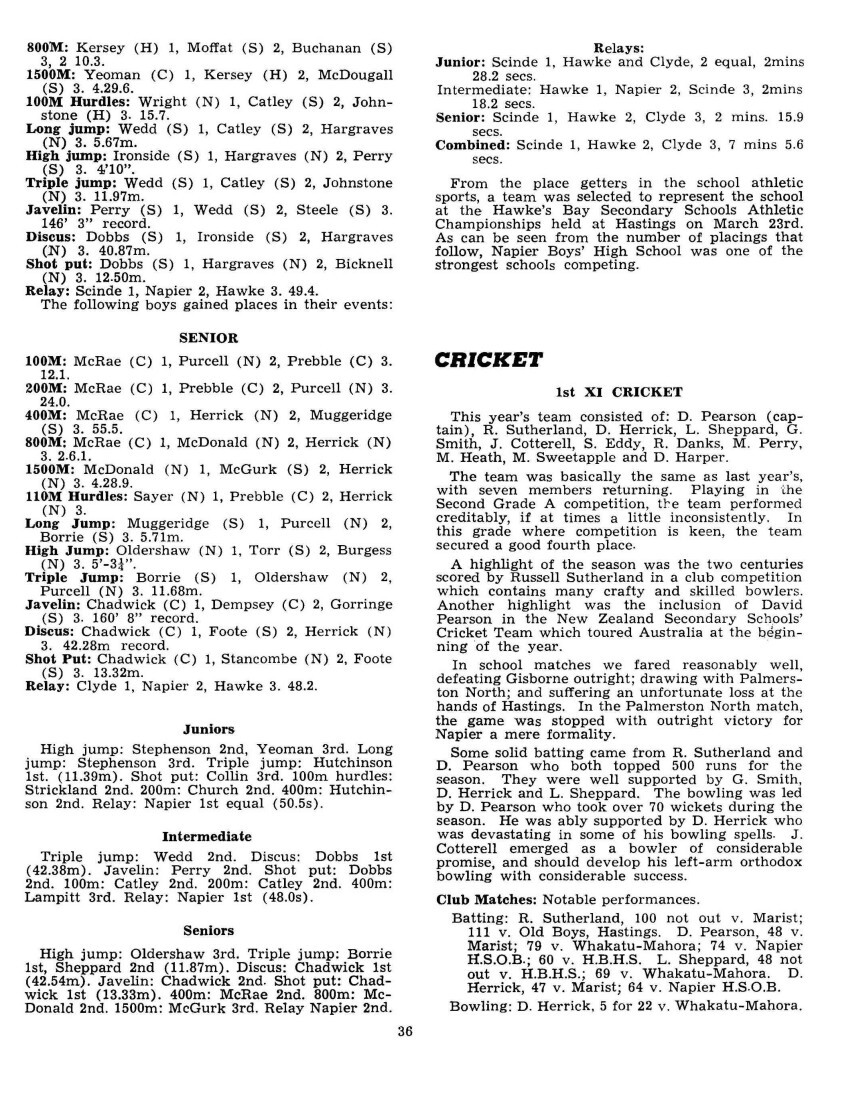
Page 37
Club Matches: Results for 1973-74 season.
v. Marist – Outright win by an innings and 71 runs.
v. Whakatu-Mahora – Draw
v. Old Boys, Hastings – Abandoned.
v. Napier H.S.O.B. – Draw
v. Hastings B.H.S. – Loss outright.
v. Marist – Outright win by 117 runs.
v. Whakatu-Mahora – Loss outright.
v. Old Boys, Hastings – Loss outright.
v. N.H.S.O.B. – Outright win by 8 wickets.
v. H.B.H.S. – Outright loss.
Played 10. won 3, lost 4, drew 3.
INTER-SCHOOL
v. Gisborne B.H.S. at Gisborne
Napier won the toss and sent Gisborne in to bat on a damp pitch. The Napier bowlers took advantage of this and soon had Gisborne in trouble. This was due to some good opening bowling by D. Herrick and D. Pearson who exploited the pitch to the fullest. They were well backed up by J. Cotterell who bowled consistently. Gisborne were dismissed soon after lunch for under a hundred runs.
When Napier batted, the batting was consistent rather than spectacular with many batsmen reaching 20. Good batting came from L. Sheppard and G. Smith. Thanks to this consistent batting Napier managed to surpass 200 runs. This type of batting was encouraging, especially with the Palmerston North match looming up in a very short time.
In Gisborne’s second innings, D. Herrick completely demoralized the Gisborne batting line-up, taking 7 wickets. This rout did not take long and the game was over before lunch on the second day.
Result: Outright win to N.B.H.S.
v. Palmerston North B.H.S. at Napier
Napier won the toss and batted with better knowledge of local conditions. R. Sutherland and D. Herrick got into stride quickly and were scoring nearly a run a minute, which is extremely good for openers facing the new ball. The innings suffered a couple of minor collapses, but this was rectified by L. Sheppard who batted sensibly for his 48 runs. The lower order batsmen contributed well to the cause and Napier reached a most respectable total of 214 runs. The innings closed at two thirty.
With the Napier innings closing when it did, it left half an hour for the Napier bowlers to get at the Palmerston North opening pair. This they did,
NAPIER BOYS HIGH SCHOOL 1st XI CRICKET 1974
Front Row: M. Heath, J. Cotterell, Mr R. Ellis, D. Pearson (captain), R. Sutherland, S. Eddy.
Back Row: G. Smith, R. Danks, L. Sheppard, D. Herrick, M. Perky, M. Sweetapple.
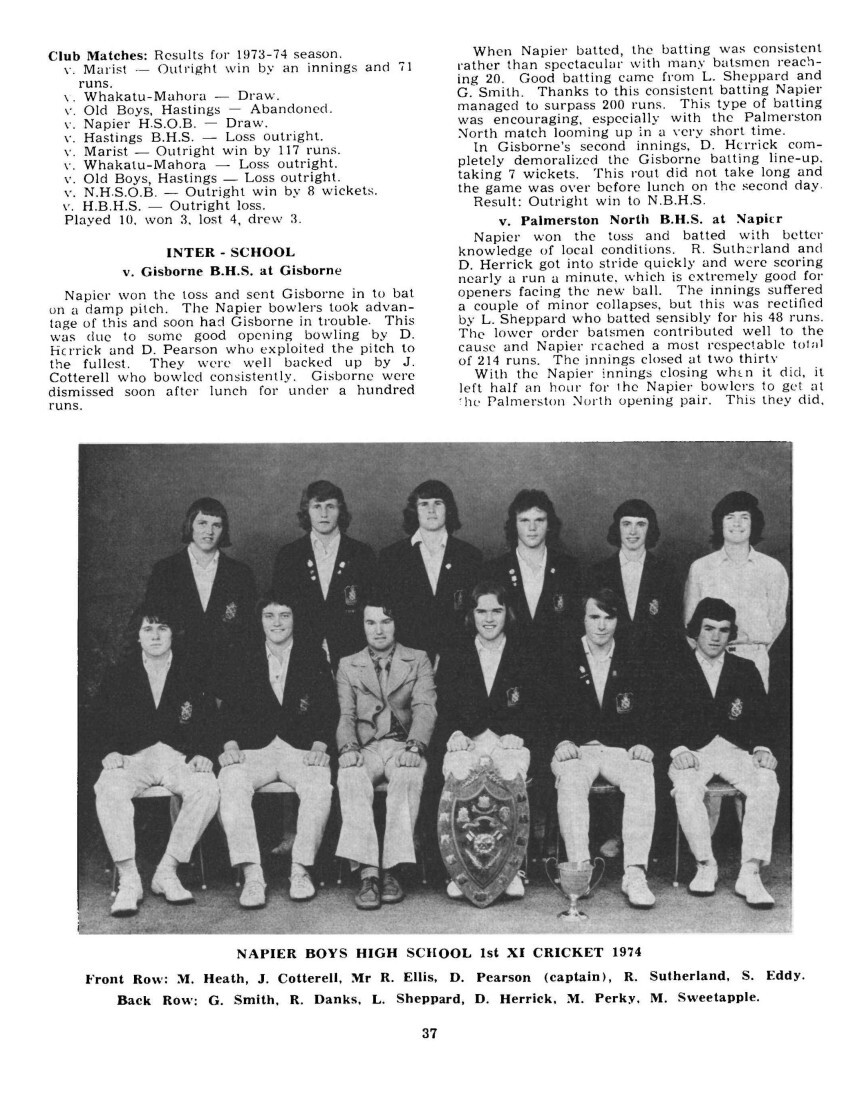
Page 38
removing two batsmen for a minimal total before tea.
After tea, wickets continued to fall, but the run rate remained the same. By stumps, they were 8 wickets down for 138 runs – not a happy state of affairs if they were to regain the coveted Challenge Shield. This small score was the result of a determined bowling spell by D. Pearson who claimed 7 wickets for 60 runs in the Palmerston North innings. The Palmerston North innings closed the next morning at ten thirty. This meant that there was plenty of time for play and an outright result one way or the other looked imminent.
Napier’s innings began disastrously with D. Herrick out without a run on the board. Once again L. Sheppard came to the rescue, this time with an aggressive 45 runs. He was joined by D. Pearson, and the onslaught began. It was a fine batting display from these two, and it was exactly what Napier needed to keep their victory hopes alive. The innings was declared closed at 180 for 5.
Once again the Napier bowlers had half an hour at the Palmerston North openers with the same success – two most valuable wickets. After tea, the Palmerston North scoring rate stalled as the wickets continued to fall. It soon became obvious that if an outright result was to occur it depended on Napier’s approach and ability. In the end, it was only bad light that prevented Napier from their deserved outright win.
NBHS 214: D. Herrick 32, L. Sheppard 48, J. Cotterell 35 and 180 for 5 declared: D. Pearson 78 not out, L. Sheppard 45.
PNBHS 149: D. Pearson 7 for 60 and 126 for 8 at stumps.
RESULT: Draw.
v Hastings at Hastings
Once again Napier won the toss. The pitch appeared to be a batsman’s wicket and so Napier elected to bat first. Napier were soon in trouble, due mainly to poor batting rather than good bowling. The innings was a mere parade of batsmen with little resistance offered except for the innings of D. Pearson and D. Herrick, who were the only Napier batsmen to get past fifteen. Napier were all out for 107 just after lunch.
The Hastings innings began sensationally with D. Herrick claiming two quick wickets, which had Hastings on the defensive immediately. D. Herrick maintained his bowling standard and saw the rout through, claiming 5 for 30 in an inspired bowling spell. Thanks to this bowling, and some reasonable fielding Napier managed to dismiss Hastings for 2 less than their own score of 107.
Napier’s second innings appeared to be a continuation of the first innings with a definite lack of resistance. However, a courageous 45 runs from the opener R. Sutherland, who batted with extreme restraint throughout his innings, helped our cause. Napier was all out for a meagre and disappointing 78 runs.
From here it became a mere formality for Hastings to gather up the 81 runs required for victory. Napier did however manage to capture 3 Hastings wickets. On the whole it was a rather disappointing result.
Napier 107: D. Pearson 55 not out, D. Herrick 20 and 78: R. Sutherland 45.
Hastings 105: D. Herrick 5 for 30 and 81 for 3.
RESULT: Loss outright by seven wickets.
On behalf of the team, I would like to thank Mr R. Ellis most sincerely for the time and effort put into coaching the team, and as captain I wish Mr Ellis and next year’s team all the best.
RUGBY FOOTBALL
RUGBY 1st XV
With the conclusion of the trials we saw a squad of 40 being selected. This number was later to be divided into two groups of twenty constituting the 1st and 2nd XV’s. Before the split was made several boys were seen to opt out and we were finally left with, what was a squad of 40, now reduced to approximately thirty. Those finally selected for the 1974 1st XV were: – K. Chadwick (Captain), J. Purcell (V. Captain), J. Murphy, J. Marsden, D. Brown, R. Danks, K. Johnstone, D. Muggeridge, D. Pearson, D. Bird, P. Caradus, R. Sutherland, D. Herrick, S. Muggeridge, N. Groom, T. Aranui, R. Pearse, L. Sheppard, D. Addis, F. Chadwick, G. Collins, S. Wedd*, T. Dobbs*, M. Devine†.
* S. Wedd, T. Dobbs – left during the season.
† M. Devine – promoted from the 2nd XV.
Of those named above, six were from last year’s 1st XV.
The team played in the Napier-Hastings under 23 competition and proved their supremacy by again winning the Lane Cup for the top Napier team. However, we were unable to retain the top team position, which 1973’s 1st XV gained, but finished a creditable fourth, with the first three places being taken by Hastings teams.
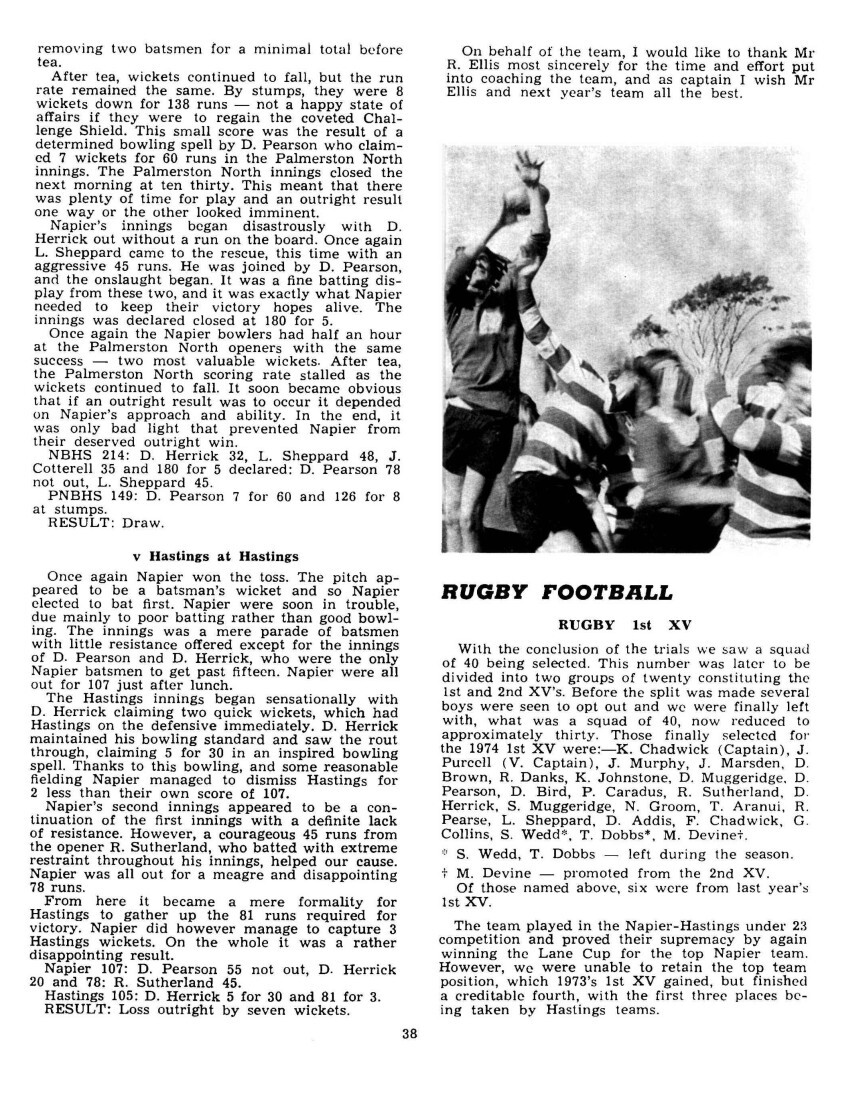
Page 39
This year’s team, although at times gaining some glory, were struck by bad luck right from the outset with boys withdrawing from the team early in the season. With the withdrawal of these boys, be it for personal or other reasons, the team was unable to settle into any form of combinations. This saw boys being played out of position early and for some this lasted throughout the season. With this aura of bad luck over the team, we were really unable to field our strongest team. The team was struck by injuries, and withdrawals, which led to a diminishing in spirit and confidence amongst the boys.
J. Purcell, one of our two seasoned 1st XV backs, could be said to be the unluckiest player in the team. Early in the season he sustained a shoulder injury during training which kept him out of early season games. He joined the team later but was to suffer a smashed kneecap, which left him sidelined for the remainder of the season.
Later in the season we were to lose another seasoned 1st XV player; J. Murphy, with a broken collarbone. Luckily, this mended quickly and we saw his return to the front row before the close of the season.
Besides our annual inter-school fixtures the 1st XV played other secondary schools these being: the touring Australian Scots College, Mount Albert Grammar (Auckland) and Dannevirke High. An account of these games is as follows: –
Versus Scots College (Australia) at Napier.
For various reasons the school was unable to field its strongest team. With the withdrawal of some boys, alterations had to be made, thus weakening the whole team. Such alterations no doubt upset the entire team resulting in the boys playing well below themselves. Scots took full advantage of the situation, showing dominance in lineout play and backline movements. In other phases of play we were able to match them. The scoring opened with a penalty goal to Scots but was followed by Napier’s second five-eighth, R. Pearse, dropping a field goal. Scots went on to score three tries with two being unconverted. The final score saw a win to Scots College by 17 to 3.
Points: – R. Pearce 1 dropped goal.
Versus Mount Albert Grammar (Auckland) at Napier.
This game was one of the many staged on College Day by the Hawke’s Bay Secondary Schools Rugby Union. The dominant features of this game were two-fold. One was the strength of our forward pack over the Auckland pack; the other being the class of the Mount Albert Grammar backline. Full credit must go to the Napier forward pack which combined exceptionally well on the day, out driving, out-rucking, and out-scrummaging the Grammar pack. Our forwards were seen to gain 80% of the ball, only to watch our back line fritter possession away though indiscriminate kicking and general mishandling. The Mount Albert backline revelled in our wasting of possession, and often displaying a fantastic exhibition of back play which many a senior side would envy. This waste of possession gave Grammar scoring opportunities which they took, thus running out victors by 23-0.
An account of our traditional fixtures were as follows: –
Versus Dannevirke High School at Dannevirke
This game was a traditional fixture. Prior to this game we had not won a College game as such, thus giving Dannevirke added confidence in their bid to defeat us. The boys by now, rather downhearted, rose to the occasion and played exceptionally well. The forwards, after a slow start, drove as a cohesive unit resulting in an abundance of ball for the backs to work with. Several players impressed, one being D. Brown, who scored two tries. D. Pearson dominated the lineouts and overall everyone played well. The team was well rewarded for their efforts by soundly defeating Dannevirke High by 34 to 10.
Points: D. Brown 2 tries, L. Sheppard and D. Muggeridge 1 try each, K. Johnstone 1 dropped goal, R. Danks 3 penalties, 2 conversions.
Versus Hastings Boys High at Napier.
The game was to be the curtain-raiser prior to the Hawke’s Bay, East Coast game. The weather and ground offered conditions for entertaining rugby but this was not to be. The team played well below themselves with countless tackles being missed, possession being squandered away by pointless kicking and a general lack of interest and support overall. Hastings took advantage of our negative play, and scored three tries. We replied with a dropped goal by K. Johnstone, and two penalties by R. Danks, one of which was a fine 42 yard kick. Another sad point of this game was the loss of J. Purcell who suffered a smashed kneecap which side-lined him for the remainder of the season. F. Chadwick replaced J. Purcell, and later D. Addis replaced L. Sheppard who also retired injured. The Ebbett Trophy was at stake in this game with Napier being the holders for the last five years. With Hastings’ 12-9 victory over us, this trophy will travel and remain in Hastings until the seventy-five season.
Points: – K. Johnstone, 1 drop goal; R. Danks, 2 penalties.
Versus Gisborne Boys High School at Napier
The weather was against both teams for this game. The ground became a quagmire and the game was played through continuous rain. Gisborne, though having powerful forwards and a capable backline, were held to a four-nil lead at half-time and up to about 15 minutes before full-time. Up to this point the team played quite well holding the powerful Gisborne side. But with about 15 minutes to go the boys just seemed to lose interest in the game thus allowing Gisborne to add 23 points and defeat us by 27-0. Another trophy was lost in this game and I hope it is not another twelve years before it is seen in Napier again.
Two senior players were injured in this game: – J. Murphy with a broken collarbone and R. Danks with a shoulder injury.
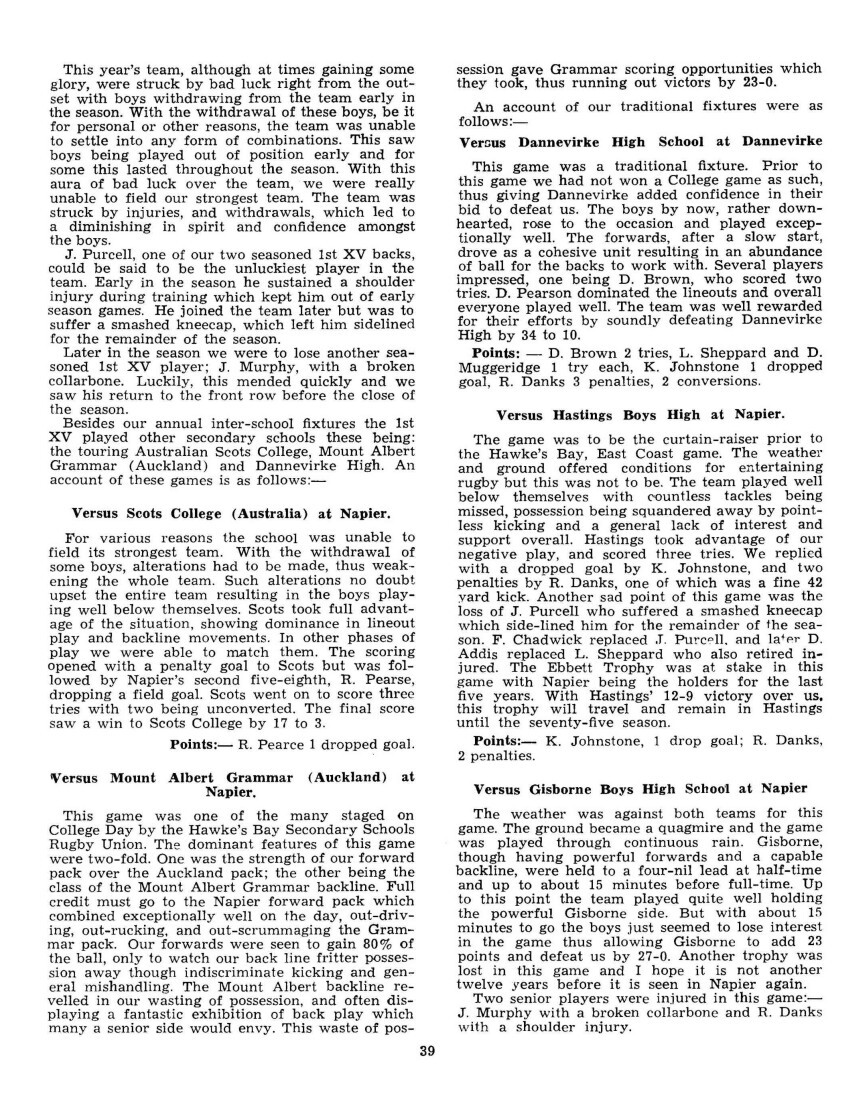
Page 40
Versus Wairarapa College at Masterton.
Nothing much of praise can be said of this game: Poor tackling, lack of support and a general looseness amongst the forwards were the main features of our game. These factors, combined with Wairarapa capitalising on our mistakes, saw yet another defeat for the team.
Wairarapa drove as one whereas with our looseness in forward play, we were denied the majority of the ball which enabled Wairarapa to dictate play. What ball we did gain was squandered away by negative back play. Our only points came from tries scored by L. Sheppard and R. Danks with R. Danks also gaining a conversion.
Versus Palmerston North Boys High School at Palmerston.
This game was staged at the same time as the annual invasion, this year being in Palmerston. Though being defeated by 23-6 this score was no indication of the game. The boys played with a lot more fire and determination which was lacking in past college games. It was through mis-tackles which gave Palmerston a victory. The retention of the coveted Polson Banner. Though our play was of a more positive nature we were just unable to finish off scoring movements. Inexperience showed in some of our younger members at times, but even so they gave their utmost right to full-time. R. Danks played an outstanding game and gained the teams only points by scoring two penalty goals. D. Muggeridge had to leave the field after gaining a gashed ear through over-vigorous rucking.
Though another defeat was suffered by the team full-credit must go to the boys for their efforts in this game. They suffered many a setback this season and with this game being our big game of the season a lot was against them. Even though a victory was not gained the team must be congratulated on their performance.
Five member’s of this year’s 1st XV represented the school in different representative teams. K. Chadwick and R. Danks gained selection for the Hawke’s Bay Secondary School team with K. Chadwick being vice-captain of the side. J. Marsden was our only member to make the Hawke’s Bay under
NAPIER BOYS HIGH SCHOOL 1st XV – 1974
Front Row: N. D. Groom, S. N. Muggeridge, R. J. Sutherland, K. L. Johnstone.
Middle 1st Row: R. B. Danks, M. J. Murphy, J. N. Purcell, (vicecaptain), V. T. Chadwick (captain) Mr P. J. Berry (Coach). J. F. Marsden.
Middle 2nd Row: T. Aranui, D. R. Brown, P. J. Caradus, G. S. Collins, D. G. Bird, M. J. Devine, F. R. Chadwick.
Top Row: D. J. Herrick, R. D. Pearson, L. J. Sheppard, D. T. Muggeride [Muggeridge], D. F. Addis.
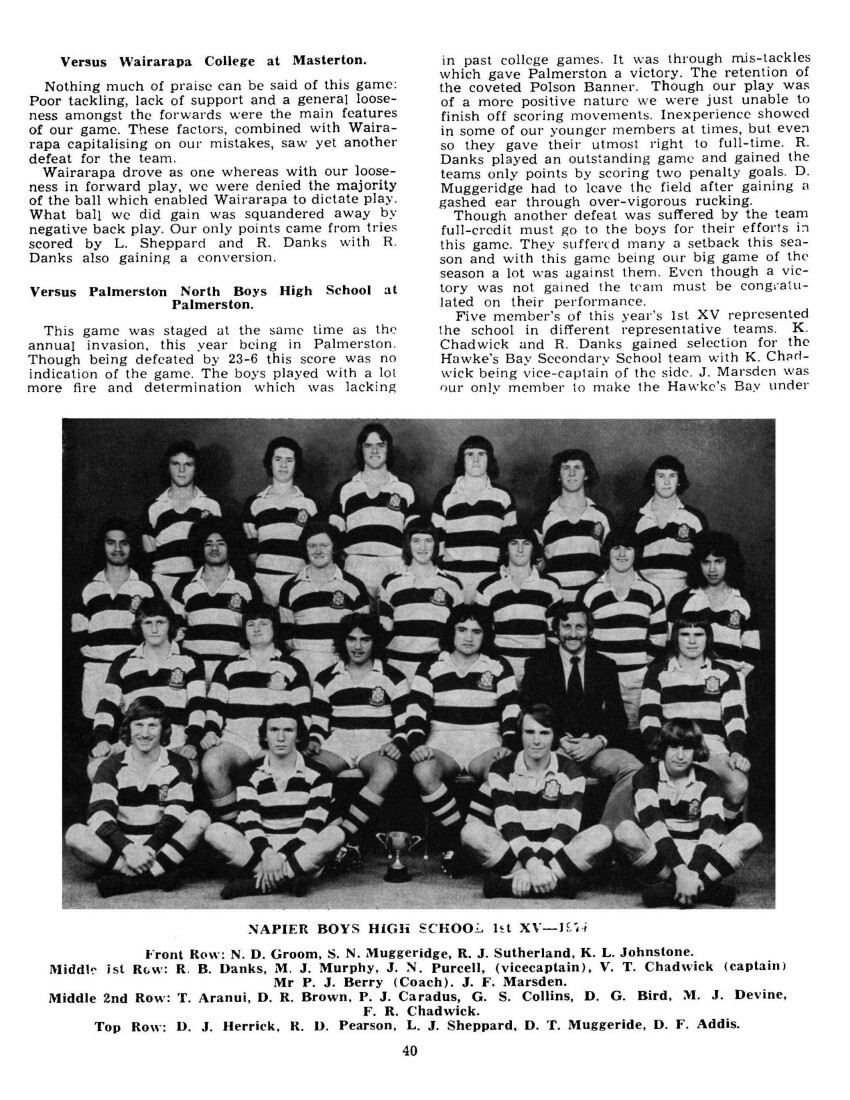
Page 41
18 side, while M. Devine and K. Johnstone gained selection for the Hawke’s Bay under 16 side.
To conclude, on behalf of the team I would like to thank Mr Berry for the time and effort he put into the team. Even though the team was to suffer many a setback he carried on regardless and kept the boys going even when everything seemed against us. He considered the boy’s problems as his problems and was to be respected for this by every member of the team. To Mr Berry and future 1st XV’s we wish you every success.
– V. Te K. Chadwick.
2ND XV RUGBY
Once again the 2nd XV was entered in the Secondary Schools “A” Grade competition, winning only four of our nine games.
Possibly some of our more notable wins were against Taradale B.H.S. 1st XV, beating them 13-0 and 27-10. On many occasions we were unlucky to lose some of our competition matches, losing to Dannevirke 1st XV 10-0 and Karamu 1st XV 22-0 and 15-10. This last result shows conclusively the improvement made by the team throughout the season.
However, in our inter-school matches we only managed one win out of four. The first inter-school match was against Gisborne 2nd XV at Napier. We lost this game 9-3 but this loss can be partly attributed to the appalling conditions – a southerly wind and rain making the ball very slippery, which led to numerous handling mistakes.
The second inter-school fixture proved to be our most successful game, defeating Wairarapa 2nd XV at Masterton. This game was the first real opportunity in the season to play a game where we had the majority of possession, dominating most areas of play, especially lineouts.
Unfortunately the Palmerston North game was not very successful from our point of view, losing 25-0. Despite our will to win we were outplayed by a faster, heavier and better Palmerston North team.
Our last inter-school fixture was against Hastings B.H.S. 2nd XV at Hastings. Previously beating the same team 14-8 in a competition game, we had high hopes of a win. However, we lost to Hastings in a close fought match, 15-11.
This year’s team members were: I. Kennedy (captain), S. Eddy (vice-captain), P. Clifton, N. Harvey, R. McDonald, K. McLeod, M. Anderson, J. Agnew, G. Mannering, M. Devine, J. Cotterell, B. Muggeridge, I. Smith, C. McLay, T. Strawbridge, C. Sutton, P. McAuley, B. Hardgreave.
Congratulations must go to four team members on their selection.
Rugby – C Grade A
Coach: Mr Mear. Captain: D. Lawlor. Vice-Capt.: W. Rolls.
The team had a very successful season experiencing only one loss against the eventual C grade champions, Taradale High School. Throughout the season, C grade A rugby was always of a high standard and many of the team matured considerably as players.
Two of the most memorable games were against Palmerston North Boys’ High which we won to the tune of 25-10 and N.B.H.S. C Grade B (coached by Mr Aldous) which we won 14-11. The game against Palmerston North was a great win for the team a game in which everything ‘clicked’.
The one against C Grade B was memorable in view of the fact that it was a try in the corner in the very last minute of the game which gave us victory.
All told we had a good season of enjoyable rugby and after all that’s what it’s all about.
Points for season:
For 248 Against 59
Won 10 Lost 1
On behalf of the team I would like to express our thanks to Mr Mear who has given up a lot of spare time and energy for our benefit.
D.L.
C Grade: B Rugby Team
This year C grade B team was not particularly successful in the Napier competition. But they thoroughly enjoyed the rugby they played. However, the season was not a good one in terms of weather, having many Saturday games cancelled.
Altogether the team won 4 games, lost 4 and drew 1. In the annual interschool matches against Palmerston North, we easily won 34-4. Later, in the Napier-Hastings Boys’ High Schools’ Field Day, we played their B Grade team and beat them by 30-4.
Our team expresses their thanks to our devoted coach, Mr P. B. Aldous who attended two coaching sessions per week and backed us up from the side-line on Saturdays.
The team was: M. Shone (capt.). S. Walker (vice-capt.), M. Tester, R. Parkes, S. Reid, M. Whittle, P. Kelliher, S. Green, G. Ericksen, A. Double, P. Glenny, M. Houston, H. Baker, S. Hiha, W. Mist, E. Brown, R. McKenzie, G. Pidd, N. Crosse, J. Apiata, S. Elliot, K. Cheer, R. Gordon, I. McLeod, W. Gates.

Page 42
F Grade: C Team
This was not a very good year. We won 1, drew 1, lost 10. Part of the reason, I think, was because most of the time we didn’t even field a full team. The outstanding player of the team was J. Puketapu who played first-five eight. As well as being the outstanding player of the team he was also top points scorer.
Inter-school games:
vs Palmerston North B.H.S. lost 4-8.
vs Hastings B.H.S. lost 6-38.
The Palmerston North game was very exiting, but against Hastings, we just couldn’t hold them back.
1974 SOCIAL TEAM
This year the Social Team had a very good season in which we won most of our games and drank more than the 1st XV. Out of our sixteen games we won twelve and lost four. Not all of these games were in the “B” Grade competition and of the competition matches we won ten and only lost two, our best competition win being against Hastings 4th XV in which we won 62-8. During the season we played some unofficial games which were more for enjoyment than for the purpose of winning. In one of these games we combined with our 1st XV to defeat Taradale High School’s 1st XV by 48-3.
Our annual trip to Palmerston North resulted in a loss but this can be attributed mainly to the tiring trip down. We were exhausted by the end of the first half but recovered sufficiently to come back in the second half to lose by only 15-10.
Over the whole season we scored 347 points and had only 123 points scored against us. Our type of team has received much criticism about our attitude towards the game and our style of easy going Rugby. I would like to say that Social Rugby builds up more spirit and determination in the players than other teams have ever had. Many boys play Social Rugby because if they played for any other team they would miss out on valuable study time due to lengthy practices several times a week. Our team gives everybody a game, not just the best players, every week, and does not see the remaining players sit on the sideline all season. Every boy who turned up to a game would get at least half a game. We even risked and lost
1974 SCINDE HOUSE FIRST FIFTEEN.
Top Row from left: A. J. Arnold, P. W. Bowley, Mr Pedersen, P. C. Clifton, R. S. Fraser.
Middle Row from left: D. S. Tolley, K. P. McLeod, J. L. Agnew, I. R. Kennedy C. W. O. Sutton, C. A. McLay.
Sitting from left: G. D. Lawrence. B. W. Muggeridge, S. N. Muggeridge, D. J. Muggeridge., G. S. Collins, J. R. Gorringe, W. D. G. Smith.
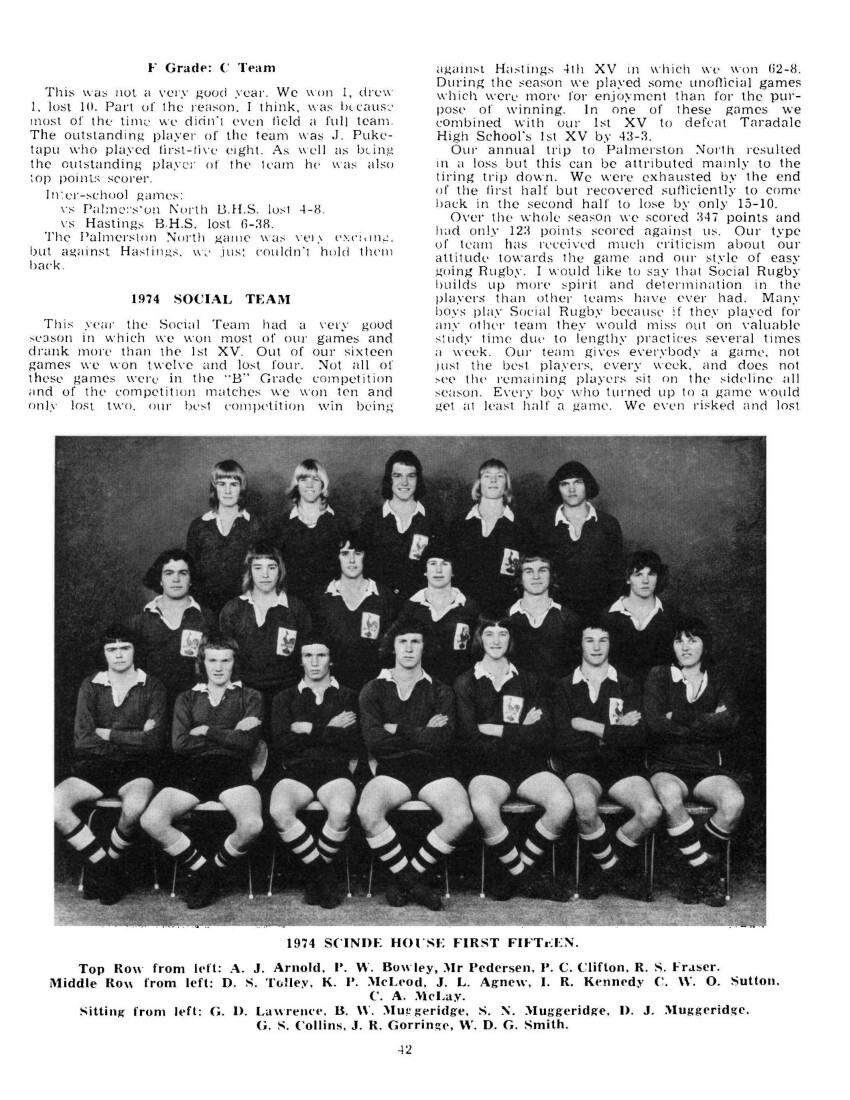
Page 43
one game because we changed our team so much at half time that it was to our detriment.
The Social Team has five members who have never played Rugby before and this in itself is a great achievement as all of these boys are amongst the most keen and enthusiastic in the team.
I would like to thank our coach, Mr Sheat, for his tremendous support on the sideline and for his unquestionable ability at conducting our after match post mortems. I would also like to thank all the players who have helped us throughout the 1974 season.
The team: Jamie Beatroot, Lock No. 8; Mugs Brian, wing; O’Alan O’Bramley, O’prop/lock; Pete Callinicos, prop/flank/captain; Eric “The Fish” Cox, fullback/No. 8; Christine Dempskey, centre/second five-eighth; Roger Fritzgerald, flunker; Terry Elton Foote, centre/wing; Russell “Babyface” Gillies, No. 8/lock; Muwwee Heap, first/second five-eighth; Dicky Hellyer, first/second five-eighth; Lewis Bladder Kenah, hooker/whore; Hairy Kennerley, wing; Leopard Lafferty, first five-eighth; Chris Leek, prop; Grime “Flasher” Lawrence, flanker; Ray Peebles, wing; Michael “Groin” Simmons, flanker; Ruck Stancombe, lock; Alan Tanklor, second five-eighth: Callinicos-Team; Donny Whyte, halfback; Mascot and Chief Supporter, and not to mention Bwucie, our masseur.
Love, Pete Callinicos.
THE PALMERSTON NORTH INVASION
Hordes of virile and athletic troubadors from our illustrious institution invaded the rival camp at Palmerston North Boys’ High. Our spies had already forewarned us that we were grossly outnumbered but undaunted we called upon our allies from Taradale High School to try and ensure a complete and utter annihilation of Palmerston. Being chronically short of defence funds our only means of attack was by using 30 buses especially hired for the occasion.
The first wave of debaters, scrabble players, and badminton boys, left our fortress at 7am steeled for the attack. This advance suicide squad was soon followed by Neanderthal-like Rugby players, fruity soccer battalions and successions of crack minority sporty types. And last but not least were those daring young men of the social team, the schools secret drinking weapon.
The first advance was brutally repulsed. The debaters had their notes ripped up, the scrabblers had their boards desecrated and the badminton boys had their shuttlecocks plucked. Having sustained such heavy losses so early on in the engagement, we expected a tactical retreat, but Commander Seaton kept calling for reinforcements. By 12.00 we had infiltrated into the school and were surveying the scenes for potential engagements. The Palmerston troops put on an air of disinterest which lulled us into a false sense of security. We freely exchanged jokes with the enemy and even accepted food and drink from their nearby supply depots. Surely our generals should have realised the peril we were in. Weighed down by excessive food and still shaken up from the gruelling advance, our men were at an immediate disadvantage. The vicious slaying of our earlier units should have been a warning. But no. At about 1pm we were ordered into action. Our demise was quick and absolute. The first XV, second XV, third XV, social, first hockey XI, first soccer XI and many more units were trapped in the mud and died miserable deaths as the Palmerston Boys routed us in Blitzkreig-like fashion. Our generals watched in horror as one of the biggest and most comprehensively planned invasions ever turned into a horrible beating unparalleled in the history of inter-school confrontations.
The wounded and dying returned to their buses to reconsider the folly of the day’s engagements. The trip home was a muted affair with few words spoken. Our generals were also pensive, and the delegating of responsibility to inexperienced siblings was an obvious flaw in the organisation.
However, undaunted by this defeat, planning for defense, against Palmerston’s retalitary [retaliatory] invasion of us next year is already well under way.
R.H.
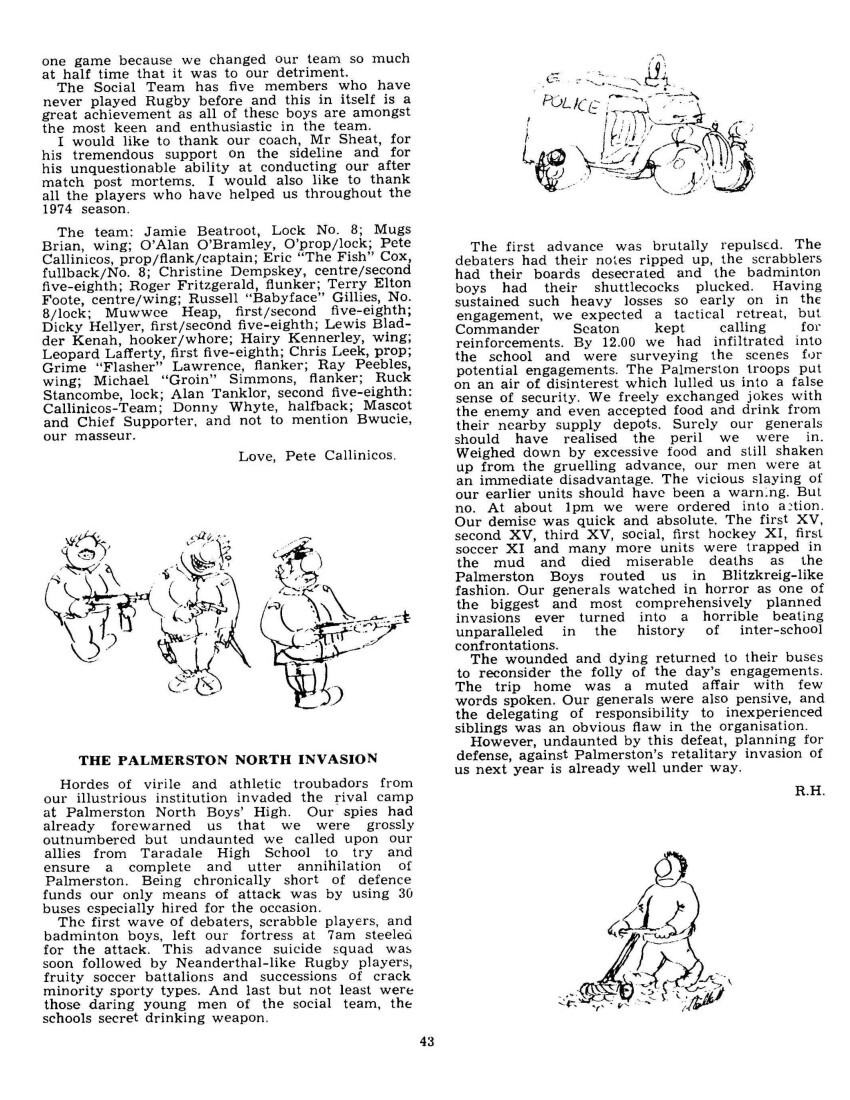
Page 44
HOCKEY
1ST XI HOCKEY
1974 proved to be the most eventful year for the 1st XI for many years. Although the team was lacking in experience, it proved that it had the necessary ability to succeed. For the first time in many years, the team played in the Napier-Hastings senior grade. Although we won only one game in the inter-city competition, the experience gained from playing against much stronger opposition was of much benefit later in the season.
We started the season with seven of last years team; I. McRae (captain), S. Borrie (vice-captain), P. Catley, P. Lister, D. Williams, S. Paget and R. Allen. The new members of the team were: G. Proctor, C. Fraser, A. Pearson, A. Guest, J. Bannister and R. Clark. Mr Curham took over from Mr Nicol as coach, having previously coached the 2nd XI.
Interschool Fixtures
Vs Gisborne Boy’s High School
The team travelled to Gisborne determined to bring back the trophy they had lost the previous year. In a game that was marred by many errors Napier regained the Hustler and Goldsmith trophy by winning 6-1. The first half was fairly even with Napier scoring first but then relaxing and allowing Gisborne to equalise. With a half-time score of 2-1 Napier were determined to play better hockey Although we scored four more goals, our standard did not improve and the score gave no indication of our potential against a weak Gisborne side.
Scorers: C. Fraser (2), I. McRae, R. Clark, A. Pearson, G. Proctor. Final score: 6-1.
Vs Wairarapa College
Once again this was our hardest interschool game of the season. Napier started well and by applying pressure were able to get a 2-0 lead. This was cut back to 2-1 just before half-time when Wairarapa scored from a penalty stroke. In the second half we were put under constant pressure by the Wairarapa attack and were unable to hold them out. Two quick goals by Wairarapa put the match beyond doubt. The final score of 3-2 was a fair indication
NAPIER BOYS HIGH SCHOOL 1ST XI HOCKEY 1974
Front Row: R. Allen, R. Clark, S. Borrie (vice-captain), I. McRae (captain), A. Guest, R. Catley, A. Dearson.
Back Row: R. B. Curham (coach), D. Williams, C. Fraser, D. Lister, S. Paget, G. Proctor, J. Bannister.
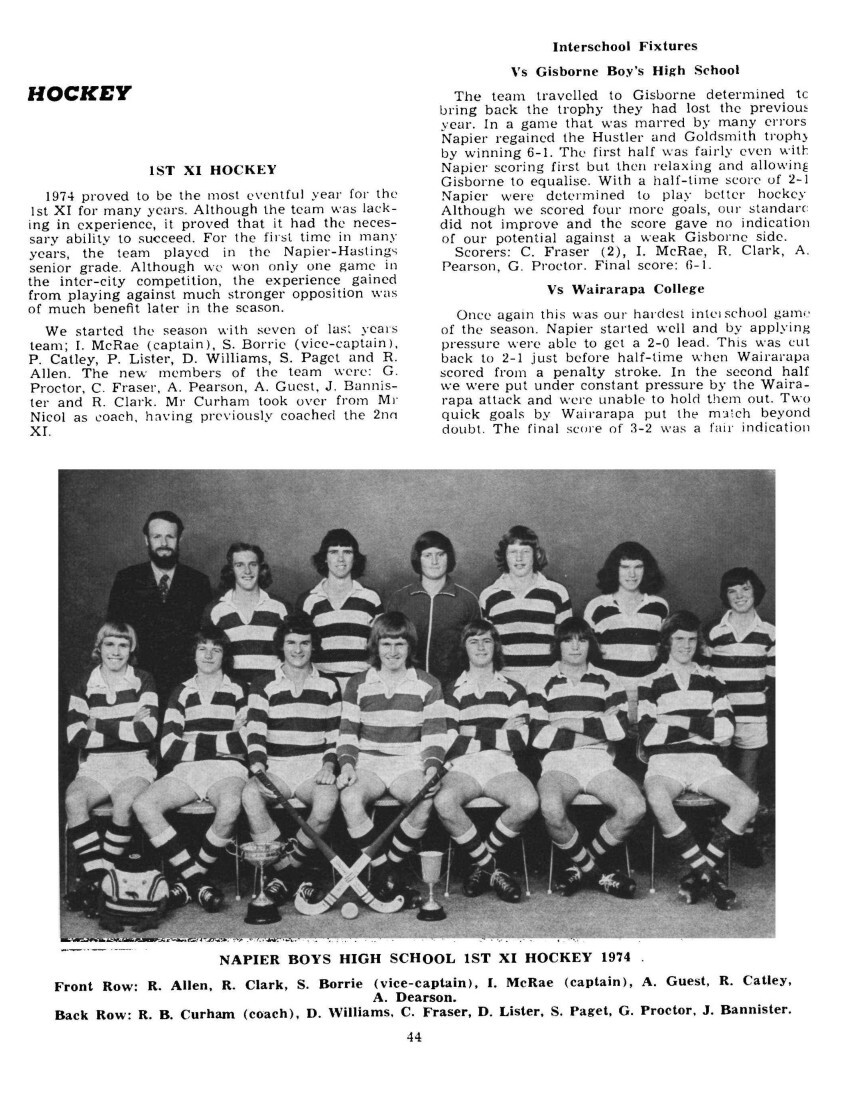
Page 45
of the game. Wairarapa College were later to be joint winners of the Rankin Cup, the top secondary school trophy in the country.
Scorers: S. Borrie, A. Pearson. Final score 2-3.
Vs Palmerston North Boys’ High School
We travelled to Palmerston North on the day of the invasion. The field was very poor and we obviously suffered from the long trip. However Napier opened the game well and within ten minutes were two goals up. This was to be the end of our glory and although we held this lead until half-time, the second half was a dismal anticlimax. The Napier defence fell apart and the opposition took this opportunity to score five goals. This was perhaps our worst display of the season and fortunately it was not repeated.
Scorers: G. Proctor, S. Borrie.
Vs Hastings Boys’ High School
This was our last game before tournament and we wanted a convincing victory. This was not to be. Playing on a very wet field, Hastings scored first but we soon equalised with a good field goal from Fraser. Hastings scored again and this was to be the half-time score. The second halt saw no great improvement in our play and only a last minute penalty stroke by Napier saved the game. Hastings were much stronger this year than in previous years and the score was a true reflection of the game. Scorers: C. Fraser, P. Catley, I. McRae. Final score: 3-3.
N.Z.S.S.H.A. Tournament
This year the team travelled to Wellington to play for a new trophy, the Founders Cup. This was donated by the surviving members of the founding committee of the N.Z.S.S.H.A. this year. The tournament was divided into two sections, each comprised of six teams. We were drawn with Te Awamutu College, Takapuna Grammar School, Hagley High School, Rongotai College and Welling ton College. The other section contained Hillcrest High School, Kings High School, Rotorua Boys’ High School, Otaki College, St. Patrick’s College, and Wellington High School.
Monday
Vs Wellington College
We were somewhat worried being drawn against such a strong team for the first game. Our opposition apparently had the same fear, with the result that we were all very nervous and never really settled down. Wellington scored first but Fraser soon equalised. The half-time score was 1-1 and this did not change in the second half. The game was not particularly good but it gave us some idea of our relative strength.
Final score: 1-1.
We had a bye in the afternoon.
Tuesday
Vs Hagley High School
Playing in the Karori Park mud, we completely dominated the game, never allowing Hagley to penetrate our tight defence. S. Borrie (3) and C. Fraser (2) scored Napier’s goals. Our defence of P. Catley, P. Lister and R. Allen played very well and were never really pressured.
Final score: 5-0.
Vs Te Awamutu College
This game was played on the drier fields of Rongotai College and it was soon obvious that our strong opposition in our early season games was paying off. In spite of a shaky start we soon settled down and the final score of 6-0 left us all feeling very confident.
Final score: 6-0.
Wednesday
Vs Takapuna Grammar School
This game followed the pattern of the previous day’s encounters with almost total domination by the Napier forwards and halves, giving the defence a break and allowing them to rest for the big games ahead.
Final score: 5.0.
Vs Rongotai College
We took this game very lightly in order to conserve our energy for the semi-final the next day. In spite of this we had a comfortable victory.
Final score: 5-1.
This meant that Wellington College and ourselves were joint winners of our pool. In the draw for first and second placings we came first, with the result that we met King’s High School in the semi-final. Wellington College drew the harder semi-final, meeting Wellington High School.
Thursday
Semi-final Vs King’s High School
We were confident of beating King’s but were not expecting a large margin of victory. By applying pressure early we were able to hold a 3-1 lead at half-time. This was extended even further in the second half, aided largely by the shattered morale of the opposition.
Scorers: C. Fraser (4), P. Catley, C. Proctor (2).
Final score: 7-1.
This meant we were through to the final. Our opponents were to be Wellington College who had beaten Wellington High 2-1 in their semi-final.
Final Vs Wellington College
This was, without doubt, the most important, and toughest game of the season. Playing on a rugby field that was ten yards longer than a hockey field, we were determined to beat a confident Wellington side. We scored twice in the first half, both indirectly from penalty corners. The half-time score was 2-0. In the second half, Wellington applied much pressure and this was rewarded by a goal from a penalty corner. They continued to apply pressure and it required some desperate defence by P. Catley and P. Lister to
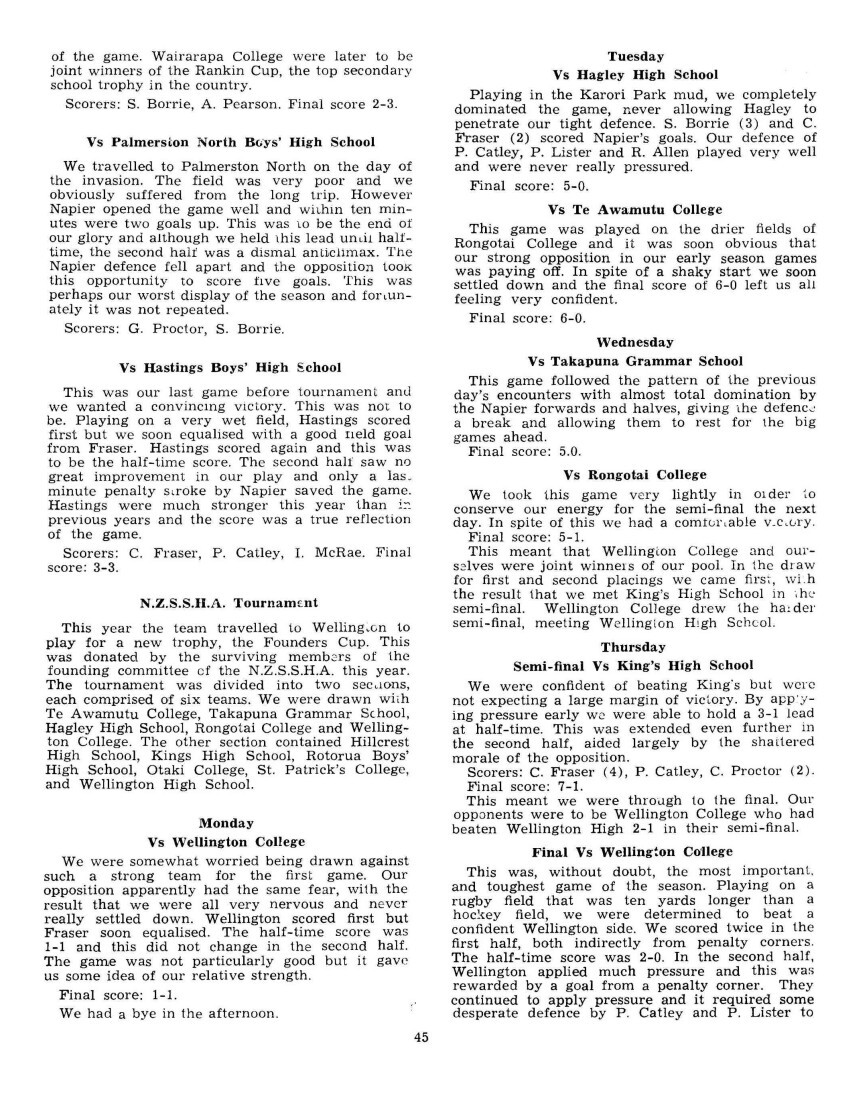
Page 46
keep the Wellington attack out. They did not score again and when the final whistle went, Napier Boys’ High had won the Founders Cup.
After the presentation of the trophy and pennants, the representative team was announced: Peter Catley, Peter Lister and Cameron Fraser were selected from our team. This was their reward for some great hockey during the tournament.
Five-a-side Tournament at Wanganui
To end the season we sent a team to this tournament. The team, consisting of: I. McRae (capt.), S. Borrie, P. Catley, R. Clark and C. Fraser, travelled to Wanganui by car with our coach and inspiration, Mr Curham.
We were undefeated in our three section games and went through to the post-section play. In a succession of games, we beat Wellington College Old Boys, Wanganui Collegiate (quarter-finals), Palmerston North Boys’ High (semi-finals). This latter win gave us much satisfaction and partially compensated for our earlier loss to them. In the final we met Wanganui Boys’ College and although this game went to extra time, we eventually won 2-0.
This win gave us the H. MacIntyre Memorial Cup, and capped off a very successful season for the team.
On behalf of the team I would like to thank Mr Curham for his efforts during the year and I hope that future teams have as much success as this years team.
I. McRae
During the year, Ian McRae sat a test for his New Zealand Hockey Umpires badge. He passed with flying colours and became the youngest such umpire in New Zealand, and the only one so qualified in Hawke’s Bay.
N.B.H.S. SECOND HOCKEY ELEVEN
The team played in the Second Grade in the Men’s Division of the Napier-Hastings competition. This was the first time for many years and the team went well against far superior players. Although they were not successful in the competition it led to an improvement in their hockey skills and play. This helped the team greatly for their inter-school fixtures in which they never lost a match.
The team this year was made up mainly of younger players. This was to help to build up the strength for the next years First Eleven. Most players showed good capabilities, especially the forwards. Garry Lindsay went to the Wellington tournament with the First Eleven during the August holidays. He played well and showed great promise.
The Inter-school fixtures were:
Versus GISBORNE Won 4-0
This was the first interschool fixture and the team were unsure of themselves, but quickly started to dominate the game. With the half-time score 2-0 they had the feeling that they had the game. In the second half they completely dominated the game with the goalie even sitting down having a rest. Opportunities were lost and the final score was only 4-0.
Versus WAIRARAPA Draw 2-2
This was the hardest game of the year with our team being constantly pressured. No one really dominated the game, but we had the better of it.

Page 47
The half-time score was only 1-0 to us, but during the second half Wairarapa were quick to retaliate with a quick goal. The pressure was on and half way during the second half Napier was awarded a stroke. It was successful and put Napier back into the lead. Again the defence was pressured and Wairarapa scored. Napier then came on strongly but were unlucky not to score again. The final whistle went with the score being 2 all, a well earned draw by both teams.
Versus PALMERSTON NORTH Won 4-0
This was a relatively easy game with Napier dominating most aspects of play. Armitage scored a well deserved goal to give the team the confidence it needed and the pressure was on Palmerston. They fought back and were unlucky not to score several goals. The Napier defence was good and couldn’t be penetrated thanks to G. Lindsay and J. Melhuish. One attempt by Palmerston was saved brilliantly by A. Guest who ran across the front of the goal, with ball just about the enter, and saved an almost certain goal against us. The win was deserved by all.
Versus HASTINGS Won 7-0
The Hastings match was completely dominated by Napier during both halves. Napier was slow to start, but once again one goal up set Napier alight. The defence never had a vital role in this game The forwards and halves completely dominated the game in the second half which lead to this well earned victory of 7-0.
This rounded off a very successful season.
The team was: G. Lindsay, captain: B. Fisher vice-captain; J. Melhuish. R. Yeoman, G. Fraser. S. Radburn, G. Davidson, R. Lowe, J. Savory, Armitage. J. Higgins.
On behalf of the team I would like to thank Mr Nicol our coach for the time and effort he has put into coaching the team. Thank you very much Mr Nicol.
THIRD HOCKEY XI
The team had fairly tough competition often playing the 1st XI of other schools. Of the 19 games we played, we won 5. When we visited Palmerston North we played the 3rd Form. rep. team and lost 3-0.
The team was: W. Steele (captain). G. Anthony. C. Smith, A. Dennis, R. Bullock. K. Lister, C. Wills, B. Lee, C. Strickland, B. Sargent, N. Nicholson.
5TH XI HOCKEY
The team had the misfortune at the beginning of the season to lose its goalkeeper and also one of the better players. After a good 3-1 win over Taradale Intermediate A, we were re-graded into the 4th grade, and as a consequence we had to play against other schools’ 3rd XIs. Although well beaten in some games, the team put up good performances to beat Taradale C 1-0 and to draw l-all with Colenso B.
The team was: O. Jackson, D. Farrell, B. Moore, N. Yoeman, C. Le Compte. B. Mogford, C. Waring, G. Brown, R. Willink, D. Watt, R. Mock, D. Richardson.
INDOOR BASKETBALL
Basketball has increased in both popularity and ability within the school. The “A” team consisted of: R. Pearse (captain), R. Ruru (vice-captain), J. Du Four, D. Thomas, L. Sheppard, T. Aranui, M. Simmons and L. Buchanan. Three players were in last year’s team. They included T. Aranui, R. Ruru and R. Pearse. The team was entered in the men’s “B” Grade competition, finishing in third place. Throughout the season the team developed into a fine attacking machine, with great team spirit. The team was chiefly known for its speed and originality of play. The enthusiasm within the team was tremendous and this duly showed in their play.
Early in the season the team was invited to play in a school tournament held in Napier. Although we lost to Wellington College, St. Pat’s (Silver-stream) and Dannevirke, it gave us all experience at high school level of basketball. This was to show in our future school games.
vs. Gisborne Boys’ High
The team went up to Gisborne without the services of R. Pearse, T. Aranui and L. Sheppard, who were committed to the 1st XV. J. Du Four and D. Thomas worked up a good combination, and this was to help in the school’s 37-32 win.
vs. Taradale High School
This game was very important to us, as it was the curtain-raiser game to an invitation Australian team and the local representative team. School was up 12-9 at half-time and were unlucky to finally go down 21-23. The team looked the better of the two teams, but had a lapse at the crucial moment and suffered the consequences.
vs. Palmerston North Boys’ High
This game was played at Palmerston and school went down with only five players. We were down 9-10 at half-time and this made us more determined to win. R. Ruru played exceptionally well being the highest scorer and M. Simmons distributed the ball well and L. Buchanan rebounded effectively. After a tight and somewhat close game, school came out winners, 20-16.
vs. Hastings Boys’ High
For years Hastings have outplayed Napier, and this year was no exception. Having superior height and shooting ability, Napier could not stop Hastings’ effectiveness. School never gave up and finally lost, 31-63.
On behalf of the team, I would like to sincerely thank Mrs Flowers for giving up her valuable time to come and coach us. The team is truly indebted to her for helping us master the finer points of basketball. Also to Mr Page, we would like to thank him for his organisation of our school games.
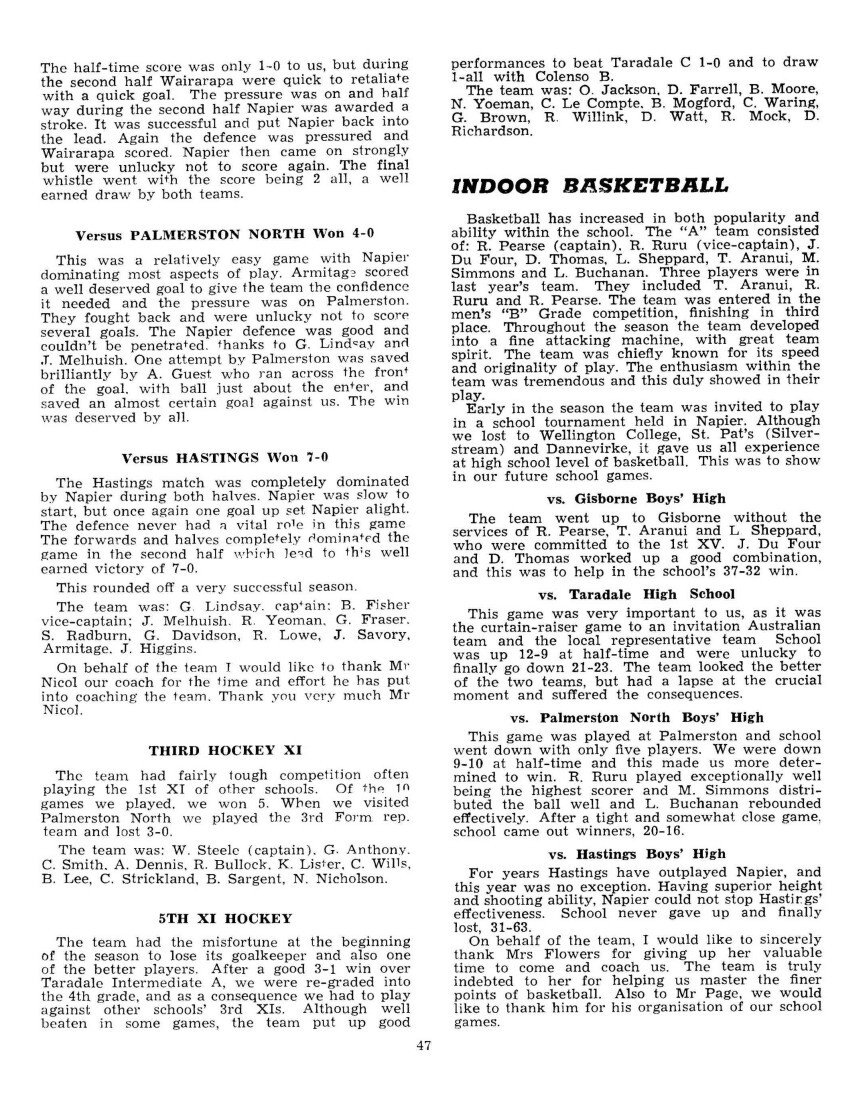
Page 48
Finally, I hope basketball will continue to grow and prosper, even with competition from the major sports within the school. Maybe now basketball will be recognised as a sport that is rewarding if people participate and play in the true spirit. In closing, I’d like to wish the successive teams of the school the highest success in their future endeavours.
R. Pearse (captain).
SOCCER
SOCCER
The 1974 season was one of mixed fortunes for the school teams. Six XI’s were fielded, this reflected the growing interest in the sport, but the number of seniors participating was very disappointing. As a result the First XI were a very young side and faced difficulties in school matches. Nevertheless the First XI improved greatly over the course of the season and finished with a splendid performance against a strong Palmerston team losing only 2-1. As almost all of the team are returning next year potentially next season could be a more successful one.
The season was most notable for its deplorable weather and the cancellation of many fixtures in the junior grades who for the first time participated in a secondary schools competition with great success.
I would like to thank the staff especially Mr Gourley and Mr Stephens for giving freely of their time and First XI players who frequently assisted in refereeing on Saturdays.
1st XI SOCCER
Back Row: A. Bryson. M. Sweetapple, M. Bicknell, M. Melbourne, T. Cowley, P. Temple, B. Heavy.
Front Row: P. Nixon, M. Cadman, G. Allen, N. Fidanis, M. Ball, Mr J. Pitts (Coach).
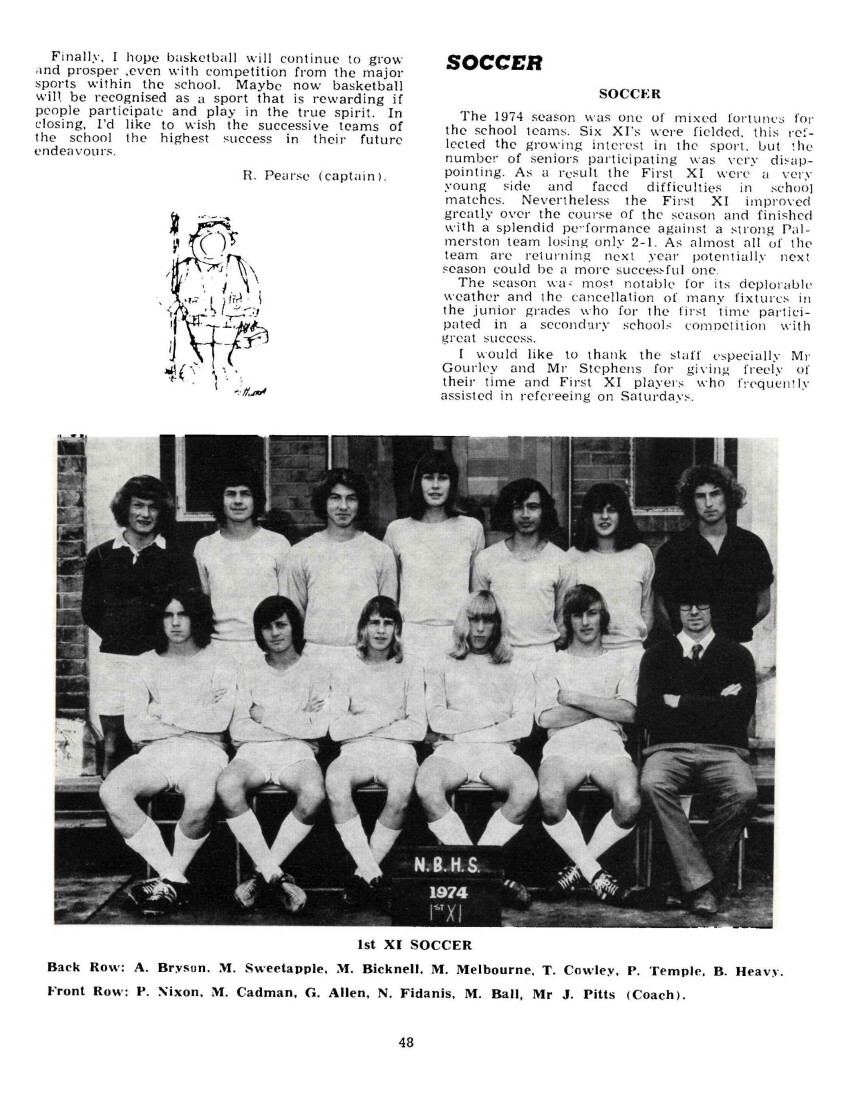
Page 49
SOCCER 3rd XI
This year’s team consisted of G. Anderson, M. Andrews, P. Chen, D. Cowley, M. Dunn, J. Hambleton, G. Hardwick, M. Hughes, J. Mitira, D. Plowman (capt.), K. Robertson, M. Stevenson, K. Wigmore.
We started the season off with initial success, but slumped during mid season. However, we seemed to pick up again near the season’s end. The highlight of the year was the game against Palmerston North Boys’ High School at Palmerston. Although Palmerston were a much older and bigger side, we managed to hold them to a nil-all draw and it was only through sheer bad luck that we didn’t score.
The other inter-school game was against Hastings B.H.S. and again we managed to draw. This was an interesting game, as we were short of players (due to illness), but we still managed to score a goal and just when it looked like we were going to win, an own goal put the score at one all.
Overall the season was quite successful, mostly due to the support of a high team spirit. Finally I would like to thank Mr Hambleton for his support from the sideline every Saturday.
D. Plowman.
4th XI SOCCER
The season began well for the 4th XI, the team being entirely made up of fourth formers. After a few games, some members became disinterested in playing so they left, leaving us short and desperately needing players, especially a goalkeeper. This situation was saved by Jim Thorburn joining us, and giving us confidence in the defence and freeing the forwards to concentrate on the attacking side of soccer.
The wet winter months also played havoc with all games and teams. Many games had to be cancelled because of waterlogged grounds.
The highlight of the season was our annual game against Palmerston North Boys’ High. Although we lost 9 – 1 I feel the trip was enjoyed by all.
Another major match was against Hastings where we lost again, this time not by so great a margin as Palmerston.
The team was: M. Helliwell (capt.), S. Collins, R. Bowie, G. Guerin, K. Okawa, M. Rush, S. Carley, J. Thorburn, A. Harrison, and J. Watson. The team was aided by Mr Stevens. Our thanks to him for coaching us.
M. Helliwell.
6th ELEVEN SOCCER
The team did not have a very successful season and only managed to win two of its fourteen Saturday games. In school games the team fared little better losing both games, against Hastings and Palmerston North, by substantial margins. There were four games cancelled during the year, which was rather disappointing. Overall, the season was a very poor one for the team. The best
of the two wins was against Colenso, by six-two. The other win was four-three, also against Colenso. On behalf of the team I would like to thank Miss O’Donnell, our coach, for turning up every Saturday to watch us play.
TENNIS
Tennis once again, as in previous years proved to be very popular throughout the entire school. Prospects look very good for next year, as much potential is shown, especially in the junior teams. The school team was weakened by the loss of Dennis Mitchell, and Warren Arlidge; but nevertheless managed to retain the Shuker Shield in Napier for another year.
The senior A Team was: J. Beaton; B. Heavey; J. Chesterman; R. Clark; G. Collins; P. Clifton.
The junior A team was: B. M. Muggeridge; M. Hughes, B. W. Muggeridge, M. Rofe; M. Dunn; M. Digman.
INTER-SCHOOL MATCHES
Versus Gisborne Boys’ High School
Played at Gisborne. After having fought many gruelling matches the teams managed to defeat Gisborne, and once again win the Shuker Shield. The school senior team won 10-5 and the school junior team won 9-6.
Verses Palmerston North Boys’ High School
Played at Napier, and once again found the Palmerston North Boys’ very strong opponents. The senior team narrowly lost by four matches to five, and the junior team lost three matches to six.
Saturday Competition
The senior team was J. Beaton; B. Heavey; G. Collins; P. Clifton. Overall the team came third in the competition.
The junior team was B. W. Muggeridge; M. Hughes: B. M. Muggeridge; M. Dunn. This team came 1st in the junior competition.
On behalf of both the senior and junior teams, I would like to thank Mr Lister for all the encouragement and support he has given us throughout the year.
– Jamie Beaton.

Page 50
CYCLING
1974 saw a new sporting club formed at N.B.H.S. It was the school cycling team consisting of K. Andrews, G. Andrews, M. Alyward (who left during the year), C. Devine, W. Howell and C. Macmillon. After two wins over Palmerston North (20-11) and Hastings Boys’ High (30-2), we travelled down to Levin for the Sir Bernard Ferguson Trophy race. As it was the first time we had raced in such an event, inexperience showed, but we were not disgraced, coming 11th out of 18 teams. Without the help of Mr Andrews this task would not have been achieved.
C.K.M.
NAPIER BOY’S HIGH TRAP SHOOTING TEAM
This year, was a very successful year as far as shooting went. Our six man team won all competitions in which we entered. Our most memorable win was in the annual Hawke’s Bay Inter-Secondary School Trap Shoot. Napier lost only 12 points out of a possible 60 to win by a clear 5 points from Lindisfarne College who narrowly defeated us last year.
The team this year was D. Whyte, R. Danks, J. Corringe, D. Bird, S. Borrie and C. McLay.
Reserve: N. Smith.
1974 CYCLING TEAM
From Left: P. M. McMillan, W. F. Howell, G. B. Andrews, K. C. Andrews.
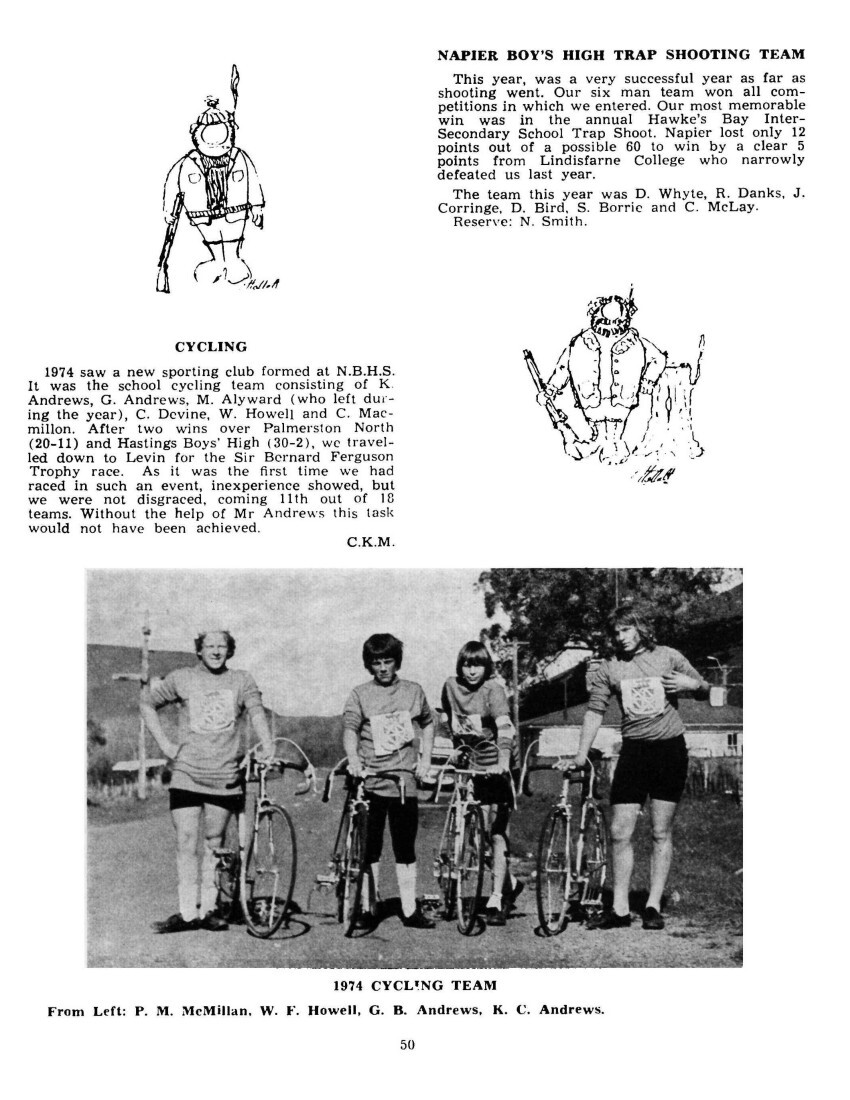
Page 51
SOFTBALL AGAINST PALMERSTON NORTH
At lunchtime on Tuesday, 26th March, both our softball teams were very worried. We were not impressive in our morning practice games against Palmerston North.
In the afternoon the Palmerston North Junior team won their game against our Juniors convincingly 27 to 8.
Our Seniors, however, were determined to regain some of their prestige and after a very tight first four innings ran out the winners 8 to 1. A feature of this game was the fine pitching of T. Dobbs which was ably supported by R. Ruru, A. Taylor, G. Scott. P. Purcell, T. Aranui, K. Buckendahl, H. Tahau, D. Plowman and P. Armitage. A fine team effort.
Mr P. Berry and C. Wright were very capable and astute umpires. This is the third successive year we have played and beaten Palmerston. Coach Jim McCulloch is determined to break this streak on his home ground next year.
D. Paxie
1974 SOFTBALL TEAM
Standing from left: P. J. Armitage, D. R. Plowman, H. T. Tahau, T, Aranui, coach Mr D. A. Paxie.
Sitting from left: G. A. Scott, G. Kemp, R. Ruru, K. D. Buckendahl.
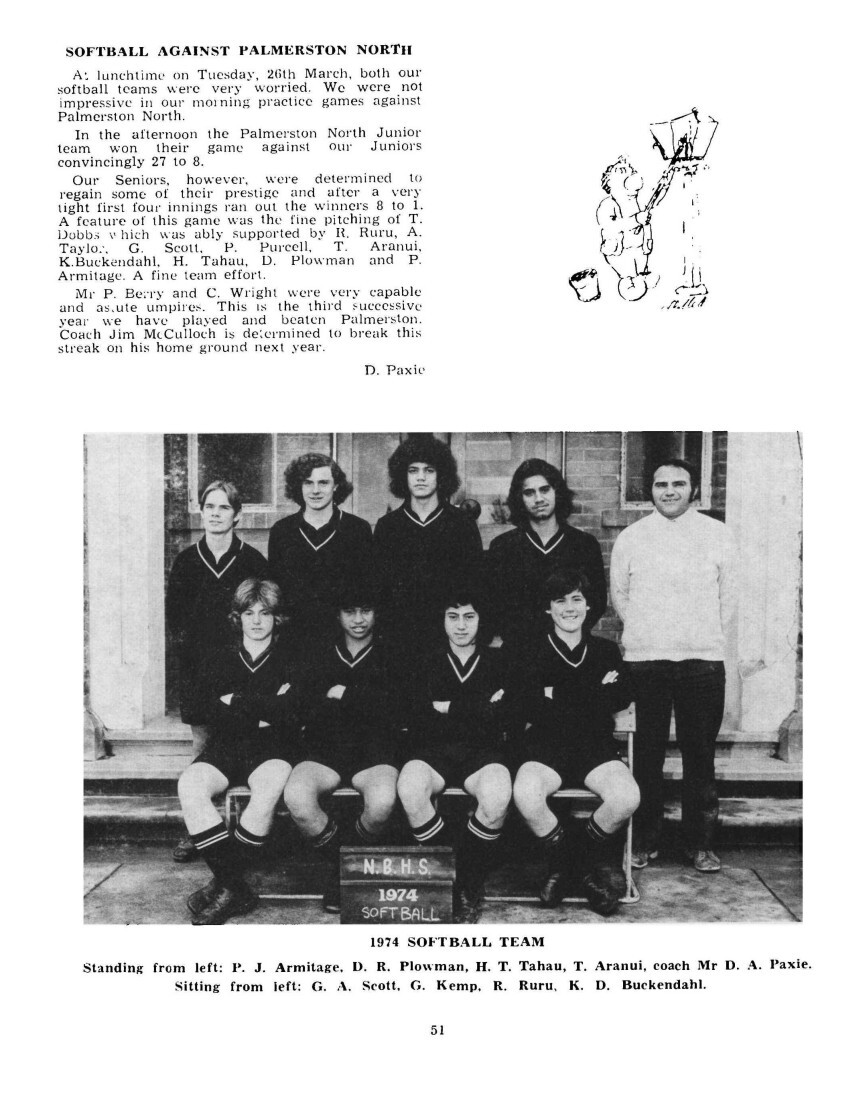
Page 54
MUSIC NOTES
There are many opportunities for students to participate in musical activities in the school. Instrumental tuition is available free on a wide range of instruments – orchestral brass band, guitar, pipes and drums. It just needs interest, some ability and the will to succeed. Many boys take the opportunity and begin an interest which both enriches life and provides an interest which can still be followed in all circumstances.
ORCHESTRA
The orchestra has had a very successful year. Items have been given on several occasions at both Boys’ and Girls’ High School assemblies, and a very good standard has been reached. At the end of the second term the orchestra spent two days visiting Te Aute College and Palmerston North Girls’ and Boys’ High Schools, where it was very well received and highly praised for the items given. A combined “Musical Happening” was presented, with Palmerston North secondary schools, to a large audience.
At the end of last year an afternoon course was held at Girls’ High School for all 3rd and 4th form players, with all the instrumental tutors present. The orchestra was guest artist at the Napier Primary Schools’ Festival and played at a combined parents’ evening as well as both Girls’ and Boys’ High Schools’ Prize Givings.
Several players have attended the secondary schools’ holiday orchestral courses and have gained great benefit from these.
Peter Fleischl had the honour to be selected for the National Youth Orchestra again this year.
The orchestra is grateful again for the valuable help and tuition given by the visiting instrumental tutors.
BRASS BAND
This group has had a rather difficult year. With no Brass Band specialist on the school staff we have appreciated the efforts of Mrs June Clifford in the period 5 Wednesday practice.
THE ORCHESTRA
Top Row: A. E. Cornwall, G. R. West, M. J. Proctor, N. A. Earnshaw, D. J. Bloomer, P. S. Chen, F. Walker, G. B. Hansson, C. J. Cook.
Middle Row: A. D. Richardsn [Richardson], N. W. Christensen, M. P. Cox, G. B. Goldsmith, P. C. Fleischl, G. F. Proctor, A. K. Pearson, W. D. Cavanagh, J. R. Melhuish, Mr P. F. Williams.
Sitting: G. C. Bell, R. C. Cappie, M. E. Lum, K. Okawa, P. L. Hazell, G. B. White, M. T. Andersen, P. D. Morrell.
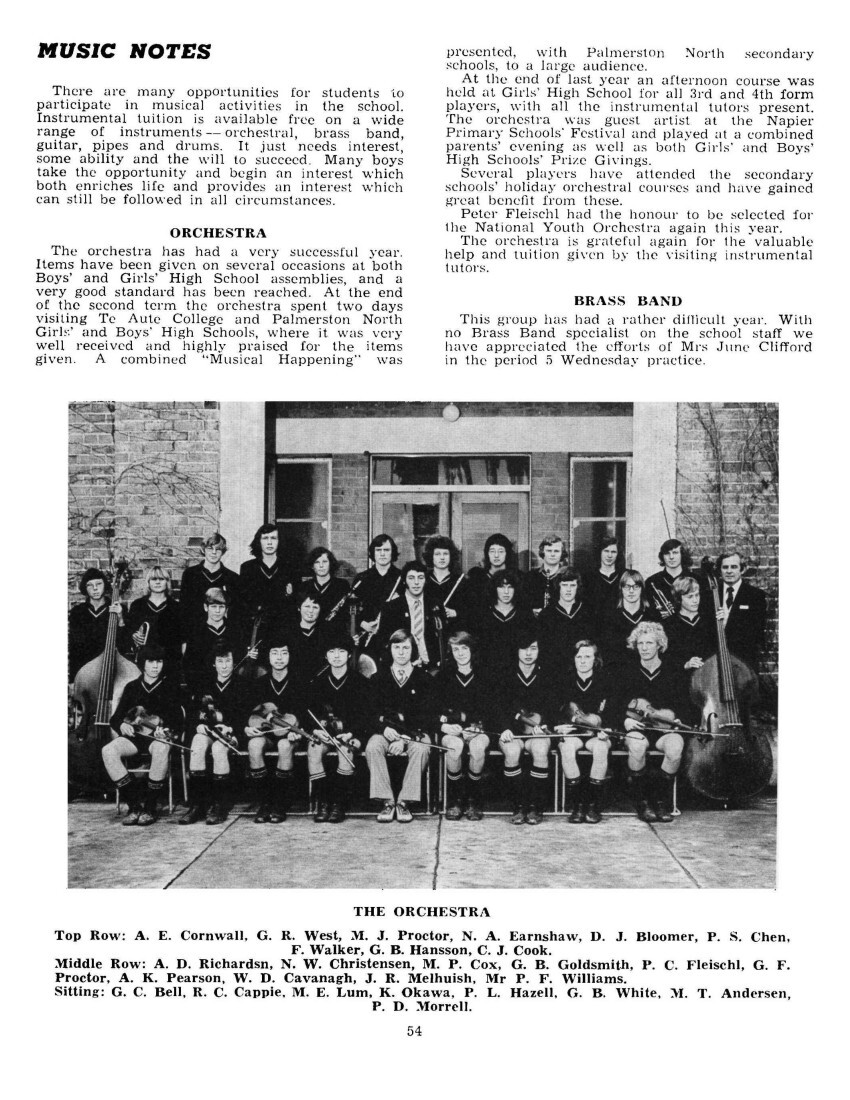
Page 55
A group of boys joined with players at Palmerston North Boys’ High School in some combined items at the “Musical Happening”.
MUSIC COMPETITIONS
These were judged this year by Mr Vincent James, organist at St John’s Cathedral. Winners were Senior Instrumental: Bernard White and Christopher Cook, first equal. Junior Instrumental: Martin Lum. Senior Singing: Phillip Hazell. Junior Singing: Craig McKenna.
CHAMBER MUSIC
Students from our school took part in five groups in this year’s contest held in June, Peter Fleischl was in the winning Brahms Trio, but they were not successful in being selected to play in the National Final. All students taking part played extremely well and learnt a great deal.
CONCERT
A combined Girls’ and Boys’ High Schools’ Concert was given at the end of the second term for a large audience in the Girls’ High School Hall. Items were presented by chamber music groups, the orchestra, the Maori Club, a third form French choir and some individual performers. A highlight of the concert (and of the visit to Palmerston North) was the bracket of Japanese folk songs by our three Japanese students – Seiji and Korji Okawa and Yoshi Ito.
Proceeds of the concert helped towards the tour of the South Island towns by the Maori Club.
EVENING ORCHESTRA
This has had a busy year despite the loss of some players. At the end of last year the orchestra provided the accompaniament [accompaniment] for the Civic Choir’s performance of Haydn’s “Creation” in the School Hall and at Havelock North. This year a ‘‘Programme for Easy Listening” was presented in March and a further recital in St John’s Cathedral in August. A highly successful combined concert with the Napier Youth Orchestra was presented in October in aid of the new Centennial Concert Hall and the year concluded with a performance with the Civic Choir of Edward German’s “Merrie England”. This orchestra, which is run as an evening class attached to the school continues to play an important role in the cultural life of the city.
BRASS BAND
Back Row: M. O’Leary, P. Cornwall, G. Hansson, J. Hansson, Mr P. Williams.
Front Row: N. Earnshaw, N. Christensen, G. Moore, C. Cook.
Absent: P. Bull.
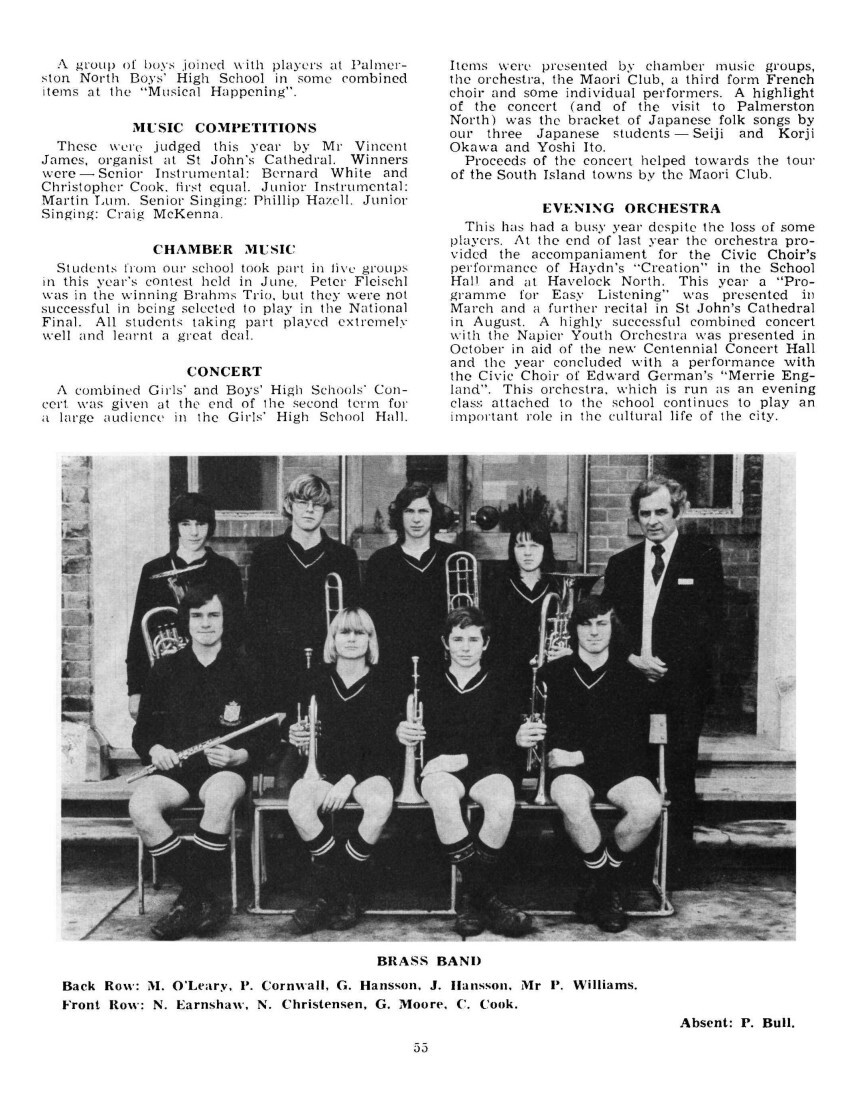
Page 56
ORCHESTRA NOTES
This year, once again, the orchestra was boosted in numbers by the Napier Girls’ High musicians. Sincere thanks must go to their mothers who made themselves available to transport girls down to Boys High for our fortnightly rehearsals. The presence of the girls undoubtedly played an important part in making our boys attend more often.
The major undertaking of the orchestra this year was a trip down to Palmerston North where we took part in a combined concert with Palmerston North Boys and Girls High School orchestras, plus some players from Freyburg [Freyberg] High School. Probably our most popular item was a selection of tunes from the musical “Fiddler on the Roof” which showed off the best, and sometimes the worst of both our wind and string sections. We also played items by such composers as Corelli, Arne and Smetona. Special mention must be made of Warren Cavanagh, who, after a shaky beginning at rehearsals with a difficult piano introduction to Smetonia’s “Octavo” was able to play better and faster than the rest of the orchestra by the time of our concerts. Also this year we have played at several school assemblies, plus a special evening concert at Girl’s High along with other musical and cultural groups. There were several personal successes within the orchestra this year. Peter Fleischl was chosen for the National Youth Orchestra for the second year running. Jane Taylor passed grade 8 on the violin, as did Bernard White on the piano. Seiji Okawa gained a distinction in grade 7 violin and there were innumerable other successes in the lower grades, promising strong future orchestras. I shall conclude by thanking Mr Williams for all his time, enthusiasm and perspiration, Mrs Wilson, Mrs Dine, Mrs Norris and Mr Wilkinson for their tutoring, and our orchestra manager, Russell Gillies, without whose help the orchestra could not have existed.
PIPEBAND
This year the band got off to a good start with a large influx of persons wishing to learn how to play both the drums and the pipes. The band members this year were:
Pipers: P. Cunningham, R. Mackenzie, S. Minto, R. Cameron, J. Neilson, M. Rush, M. Helliwell, Mr N. McLeod and Mr I. Mansfield.
Drummers: G. Northe (Drum Major), R. Martin, M. Baker, M. Clark, H. Baker, G. McLennon, D. Harvey.
The band has had a busy time this year, with the first parade being in mid-July at Te Awa School. The next parade was on the 5th of August, our annual parade for the Otaki Scholar. We have also paraded in two contests, with successful results, and conducted a tour of Palmerston North high schools.
I think that at this stage we should thank Mr McLeod of the staff and Mr Mansfield of the City of Napier pipeband, who have given many hours of their weekend time to training the band for our parades.
M.H.B.
DEBATING NOTES
The Senior debating team of Philip Hazell (leader), John du Four (2nd speaker) and Richard Hellyer (3rd speaker) had the misfortune of being defeated in the first round of the local Jaycee competition by a strong Sacred Heart team (now in the finals). The school team is now drawn against St. Johns in the finals of the losers round having defeated both Karamu and Colenso. In purely interschool competitions a team of Hazell, Bull and Hellyer retained the Bluck Cup by defeating Gisborne Boys’ High School, and the N.B.H.S. senior team lost to Palmerston North Boys’ High although the adjudicator awarded equal points. The junior team of Graeme Goldsmith, Mark Sweetapple, Mark Anderson and sometimes Cameron Fraser were more successful, reaching the semi-finals of the Jaycee Competition, before being defeated by a Sacred Heart team. The juniors beat P.N.B.H.S. The grand old men of last year’s junior team, Peter Bull, Bernard Whiteman and Simon Woodhouse have only been able to air their experience once this year when they unfortunately lost to P.N.B.H.S. There have also been several in ev-form debates this year. e.g. 6A beat 6C by the narrow margin of 1 point.
Many thanks to Mr O’Connor and Miss Schon for their invaluable help to debating teams.
Profile of a debating team:
Philip Hazell – master tactician and fiery demagogue; following in the footsteps of such notables as King Dick Seddon, Winston Churchill and Ted Redwood (ex school caretaker) Philip has developed new dimensions to the martial art of debating. His tactics include “the knee knock” (designed to distract the Opposition), “the cough between each word” (a real crowd pleaser) and the uncanny ability to make any definition technical. Philip’s personal motto undoubtedly is “You name it, I’ll complicate it using my Webster’s New Collegiate Dictionary”. For Philip the ultimate debating thrill will be to yell out “You’ve had your turn, sonny.” So keep up the good work Phil.
John du Four – main strategy is to bore the opposition into submission using the American travelogue technique. Favourite phrases are “people are becoming increasingly aware…” and “No longer are we prepared to sit back” Personal motto is undoubtedly – “You name it, I’ll generalise it.’ Also has the ability to gain points for team work by saying, “As my first speaker has said …” when his first speaker really didn’t.
Richard Hellyer – by far the most forceful member of the team, he’s not really the woolly headed genetic deviant you think he is. His well aimed but lengthy rebuttal of the opposition’s argument is usually terminated by a paroxysm of coughing and feet stamping from his 1st and 2nd speakers, warning him that his 2 minutes 40 seconds is up. Also has an uncanny nack of telling the opposition how stupid or dishonest they are for saying something when they haven’t even said it. Personal motto is undoubtedly “You name it, I’ll find a quote from Ian Andrews of that well known rock group, Jethro Tull, to fit it.”
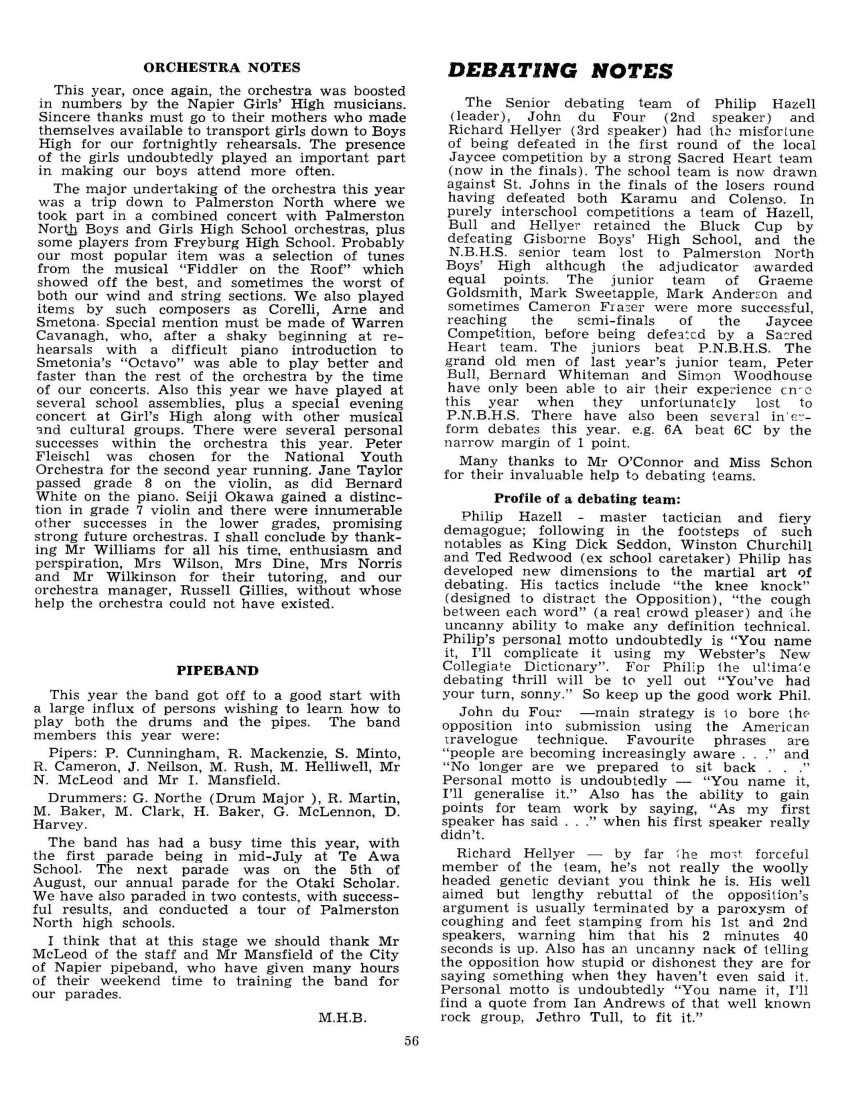
Page 57
Special mention must also be made of Ted Sandyman a fictitious character who has at various times been the curator of the Kiwi House, a priest and a world authority on many things, to substantiate the senior team’s argument.
JUNIOR DEBATING 1974
This year the Junior Debating team got through to the semi-finals of the Jaycee Competition but unfortunately were then defeated by Sacred Heart.
The first debate was against Hastings Girls’ High and the topic was “That women are more practical than men.” Napier took the negative. The team, led by Graham Goldsmith, Mark Sweetapple as second speaker, and Cameron Fraser as third, won by a margin of 14 points.
In the draw for the second round Napier Boys’ High received a bye and we moved straight into the semi-finals. Before this debate though, was the annual Palmerston North invasion. The topic for this debate was “That war is a good thing” and we again had the negative. Mark Anderson was third speaker this time and with the positions of the first two speakers changed, Napier won by a margin of 40 points.
A week later the debate against Sacred Heart was held and the topic was “That pressure groups have too much influence in New Zealand.” Sacred Heart took the negative. After a very close debate, they ran out the winners.
On the whole a good year, with a lot of interest in debating being shown by third formers, so there is a promise of a good team next year. We would like to thank Miss Schon and Mr O’Conner for the help and advice they have given us.
DEBATING TEAM
R. Hellyer, P. Hazell, J. Du Four.
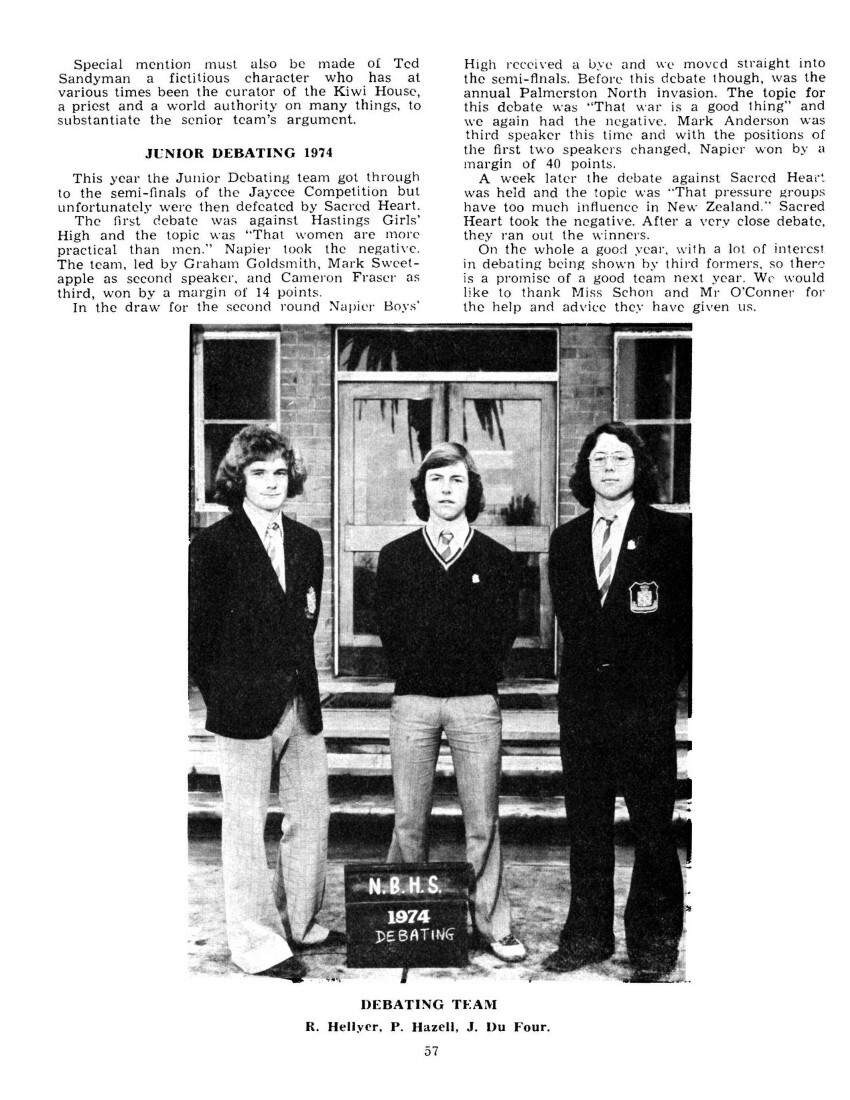
Page 58
LIBRARY NOTES
The Library Notes are probably one of the least read articles in the School Magazine. This is because most of us take the library for granted. To most, the library is a building that we visit once a week to get out of an English period, or a place to go in the winter when it’s too cold to stay outside.
This taking for granted, by some, has led to some blatant vandalism, or just immature abuse of other’s property. One of the most tragic examples of pure vandalism was the removal of a few colour plates from “Buller’s Book of Birds”. This has almost completely ruined an expensive book.
The Library Staff would like to thank those who have so generously donated books to the library. I. Lawrence, Mr De La Haye, H. A. L. Arnott, G. Bristow, K. B. Dixon, W. M. B. Harding, B. Horton, I. G. H. Leggett, K. J. Nuttall, D. A. Roberts, Mr Cliff, Beattie and Forbes, Mr and Mrs R. Arnold, H. M. Matunga, B.P. (N.Z.) Ltd. Mrs Minton, Prefects 1973, P. Gosling, J. Bygate, Mr J. A. McGavin, G. Hardgrave, J. Beardsell, Interact Club 1973, J. Brown, Mrs E. Gahagan, Chiff Tait, Mr D. Sheppard, Mr Ford, R. Brinsley, P. Callinicos.
One of the most popular places of the library seems to be the main entrance. This is frequented by large numbers of boarders during most intervals.
I would also like to thank Comrie for the entertainment he has provided, even though I wonder about him sometimes.
On behalf of Mr Howlett and all the Library Staff, I would like to thank very much those two ladies, Mrs Heath and Mrs Wright without whom the library could not function.
I am grateful to those librarians who helped me throughout the year, especially Peter Callinicos, Rodney Allen and Martin Green.
This year, Mr Hewlett introduced a new scheme involving third formers. The members of the staff helped the more senior members by shelving books and thus decreasing the work load.
Library Staff: Librarian, Mr A. T. Howlett: Assistant-Librarians, Mrs H. Heath, Mrs B. Wright: Senior Librarian, C. A. MacErlich: Deputy Senior, P. J. Callinicos: Library Assistants. R. Allen, M. Green.
LIBRARY
Top Row: A. J. Callinicos, W. T. Jeffares, M. Houston, S. H. Heays, N. A. Earnshaw, N. W. Christensen.
Front Row: R. V. Allen, C. A. MacErlich, P. J. Callinicos.
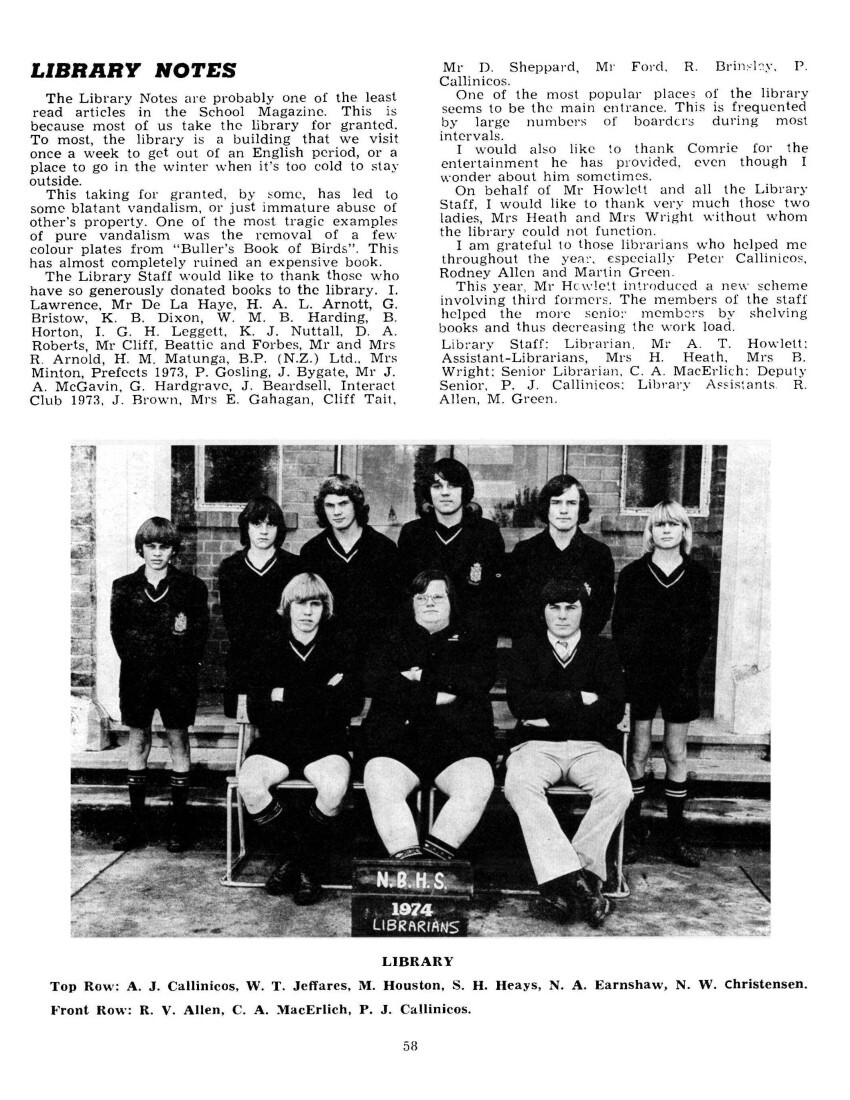
Page 59
INTERACT CLUB
INTERACT CLUB – ANNUAL GENERAL MEETING
1974: PRESIDENT’S REPORT
The officers for 1974 were: John Du Four, President; David Brian, Vice-President; Phillip Hazell, Secretary; David Lawlor, Treasurer; Directors, Brian Gempton, Peter Bull.
The 1974 year got off to a slow start in terms of the club’s service to the school and community. In fact, it wasn’t until somewhat later in the year that the club finally got off its feet and got to work. This did not necessarily reflect the club’s attitude, for indeed, many efforts were made in planning a variety of activities, both service and social, that unfortunately never evolved.
At the start of the year the club found itself confronted with the shifting of its tuck shop (the financial backbone of the club) into the new premises next to the gymnasium. The new shop was purchased towards the end of last year and has proved to be an asset to the club. However, it did pose a few problems, the most recurring one being the security of the shop. It was broken into a number of times but fortunately losses were minimal. I’d like to take this opportunity to thank Mr Caird and the school for allowing the Interact Club to maintain the tuck shop as it is the primary source of income for the club. Such a success has been the tuck shop that the club has had virtually no financial problems and the fact that the only activity outside of the continual running of the shop to raise funds was the catering for an evening orchestra concert at the High school, clearly bears this out.
In International service, the club maintained its sponsorship of the Lee Sung-Man family in Korea, at a cost of $100 a year. The Save the Children Fund has seen to it that this family receive food and clothing, plus an education for the children. The club has maintained the sponsorship for the past five years and it is clearly one of the most worthwhile ventures in which the club has been engaged in its entire history.
In local service efforts the club participated in the nationwide I CARE clean-up. On the day of the I CARE programme’s massive assault on litter and rubbish throughout the city, Boys’ High Interact Club joined in with the Jaycees in collecting glass. It was a good turn out by the club and I’m sure many of us were pleasantly surprised to find out just how much fun such a job can be.
A visit to the Hohepa Farm for the handicapped was another effort by the club. The event had almost become an annual one until last year’s club let it pass. I was glad to see the visit again take place and I hope it is never again allowed to lapse. The club helped the farm manager, Mr Proctor, and a number of boys, in planting a variety of shrubs and trees around the farm. Each member was paired off with one or two boys of Hohepa and I’m sure that both sides were delighted in the outcome. Before leaving we toured the workshop in the farm and were all surprised to see the production line for a variety of products including anything from garden furniture to toy trains.
The club also saw to the upkeep of the trees planted by last year’s club in conjunction with Rotary at the Colenso Memorial. It was unfortunate to find that the flooding had taken its toll. Consultation with Anderson’s Nursery convinced us that replanting would have to wait until the right type of trees again became available. No doubt next year’s club can follow this up.
Early in the year the club held a combined Interact Club meeting with Napier Girls’ High School Interact Club at Girls’ High. A number of combined activities were arranged but unfortunately the Girls’ High President left soon after for an exchange student visit to America. It took quite a while for the Girls’ High Club to find a new president and none of the plans jelled. However David, Brian and I, with two members from the Girls Club did follow up the meeting with a visit to the social services centre in Napier to see if the clubs could be of service to victims of the flood. We were pleased to find that these people were already being seen to, so the club wasn’t needed in this case.
The Eighth National Interact Conference was held in New Plymouth from September 2-6, and the club saw to it that delegates were sent and a good time was had by all. Such conferences are important to the future of Interact by showing up many of the problems that confront the different clubs. The most common and acute problem seems to be that of membership and although I would have liked to have seen a larger membership in our own club, I do feel that it possessed quality rather than quantity. This is, I believe, the most important thing that the club’s membership is made up of progressive, energetic individuals that can put the many goals and ideals of Interact into effect.
The officers for Napier Boys’ High School Interact Club for 1975 are: David Lawlor, President; Brian Gempton, Vice President-Treasurer; Peter Bull, Secretary; directors, Kevin Callinicos, Mark Prebble.
I would like to take this opportunity to thank Mr Robinson, Mr Barry and Mr Speady for acting as the Club’s Rotary Representatives. Their help and advice has been welcomed time and time again. I would also like to thank Mr Brown for his all-round support and assistance to the club; and Mr Caird for his consent to the activities of the club and general encouragement.
Special thanks to Yoshifumi Ito, our Honourary [Honorary] member from Japan, who not only added his own particular charm and bubbly personality to the club, but to the Eighth National Interact Conference. The clubs appreciation must go also to Mr P. Aldous who has generously given his time to auditing our accounts and also to his two able assistants, K. Callinicos and R. Hellyer.
I wish the officers and members of next year’s club all the luck in the world. The club’s general level of activity has diminished in recent years, and I hope that the boys next year can reverse this unfortunate trend.
John Du Four, President.
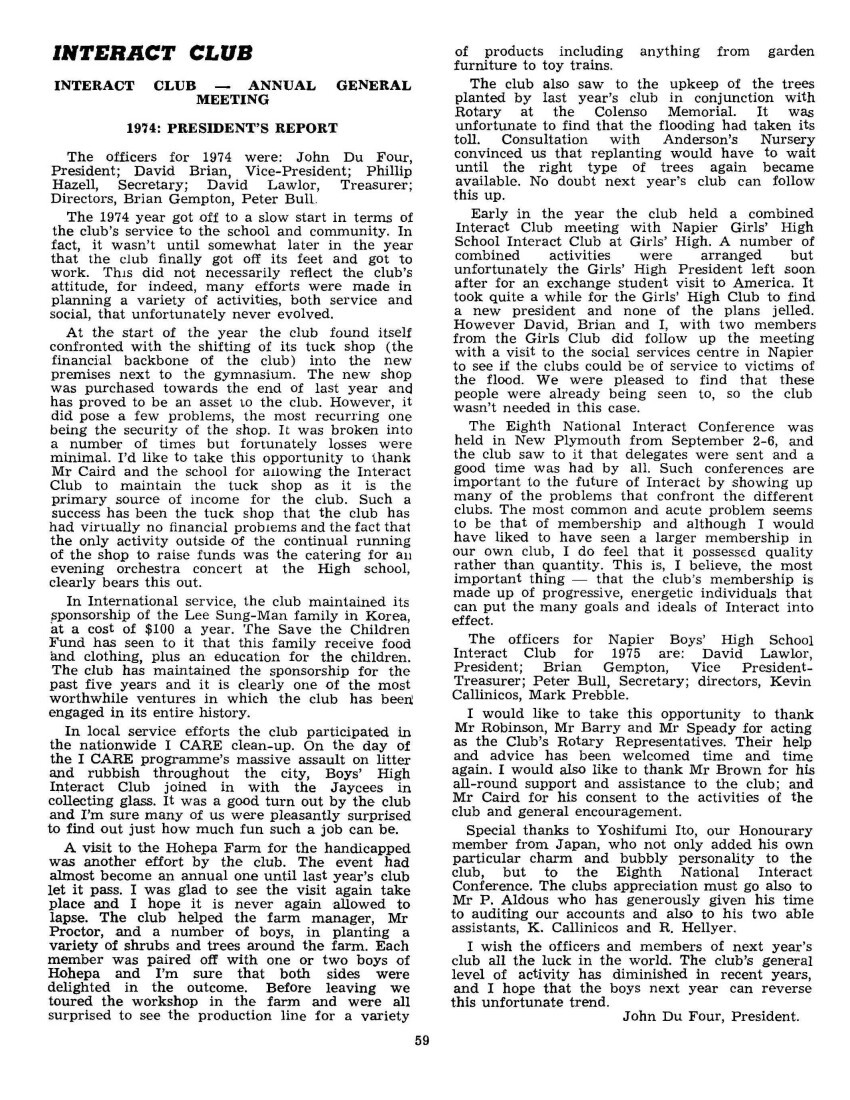
Page 60
I.S.C.F. NOTES
I.S.C.F. (Inter School Christian Fellowship) is a group of people who are “Sold Out” on Jesus and who want to tell others of the great treasures God has for them if they will accept him as Lord of their lives.
This year the I.S.C.F. groups of Napier (Girls’ High, Boys’ High, Colenso and Taradale High) have taken part in many inter-group, inter-school activities:
April. The combined groups from Hawke’s Bay went on a day trip to Cape Kidnappers. Many new friends were made with new members in each group. The day was highlighted by a swim in the sea. But some weren’t satisfied until one of the onlookers received an unexpected dip.
Mid-Term Break, saw a truckload of I.S.C.Fers off to Puketitiri for the weekend. Members from most schools attended. Bible study and snow were mixed in with Christian Fellowship to give everyone a very profitable and exciting weekend.
Breakfast??? That’s right.
Get a large house, fill it with 30 young people, top it off with a Continental style breakfast, add a pinch of singing and a shake of bible study and you’ve got an I.S.C.F. Breakfast. That is what I.S.C.F. members from Napier attended at 7.30 one Saturday morning in July. The reason for such an early hour? The main reason was the novelty of it, and so that those intending to play sport that morning could get away in time for their games.
Last, but not least “Cram In” could have been a name given to our combined meeting on August 15th. I.S.C.F. members from Napier Girls’ High and Colenso joined our group in the music room for our lunch-time meeting. Differing lunch hours made our time of “Hilarious Chaoticness” limited. But a wonderful time of fellowship was had by all.
May Senior Conference was a great time of meeting with other groups from the central New Zealand area. Many things were learnt and shared. The programme included a “JoyJam” put on by the Conference delegates, and an afternoon visitation of citizens of Otaki. God really moved in a wonderful way amongst all present and gave a new insight into Inter School Christian Fellowship.
It was because of the conference that the “I.S.C.F. Press” was started by Napier Boys’ High pupils. The newsletter is solely for the purpose of sharing and exchanging news between groups, and has proved to be a great blessing.
Visiting speakers at I.S.C.F. this year have included:
Mr Tait, our recently retired Mayor, who told us of his recent experiences in Jerusalem.
Graeme Burch, the Napier full-time Youth for Christ worker.
Reverend Barker, Napier Baptist Church’s new minister (a former member of the Christchurch High School’s First XV).
Rex Smith, a Napier Brethren youth leader.
All these men love and serve God in their own particular fields and we were very grateful to have them speak to us.
Photo captions –
“Phew! The top at last.”
“Smoko time”.

Page 61
We would like to thank Mr Williams for making his room available for our meetings and any other member of the staff who has assisted us in any way during the year. Also thanks to Mr Yeoman, our advisor, for his efforts.
We would challenge all those reading these notes to take a look at yourselves. See if you know where you’re headed. We say that Christ can fill all the empty gaps in your life. He can give you a reason for living. And so we invite any one interested to attend our meetings next year and extend a warm welcome to new pupils of the school who will be attending in the future.
A. T. Arnold,
I.S.C.F. Secretary.
CHESS CLUB
So far this year the Chess Club has been going steadily. A few boys who previously had never played chess are now playing quite well. Others have become quite skilful players through practice.
Since the 1972 world chess championships, there has been a steady increase in players and their standards as most people were aware of the interesting games between Fischer and Spaskey [Spassky]. This growth in popularity of chess has been reflected in our school with more players than in previous years taking part.
AGRICULTURAL ENGINEERING
This course was designed to provide basic knowledge of farm machinery and workshop practice as applied on the farm, but which also can be applied in other occupations, such as motor mechanics, carpentry and metalwork trades.
The course involves principles of diesel and petrol engines, including practical and theoretical experience of hydraulics, engine timing, engine calculations, pulleys and gears, maintenance and repairs, and their application.
We are fortunate enough to have in the workshop running engines on stands, such as a Landrover engine, on which we can gain practical experience by carrying out such functions as engine timing, injector pump timing and general maintenance. The course also involves many woodwork and metalwork practices which cover such things as wood and metal types and their uses, and the correct methods of tool maintenance and application.
This type of education is vital to people working on machines for, with the cost of present day garage expenses, the operator can save a lot of his own time and money by doing his own maintenance and repairs.
The agricultural course provides a basic education for those people wishing to go into the three- year Lincoln and Massey Diploma courses or the cadet training establishments at Flock House in Bulls, Southland Polytechnic and Telward [Telford] Institute in Otago.
Examinations are sat in the form of Trade Farm Examinations which are set by the New Zealand Trade Certificate Board. From these exams, the following qualifications can be obtained: – First Qualifying, Second Qualifying, Trade Certificate, and Farm Management which is equivalent to Advanced Trade or “A” Grade qualifications in mechanics, carpentry, etc. These courses are essential to a person wishing to go on to the land, because Government loans and farms will not be available for people without this type of education.
Today, the worker on the land needs a broad technical education with not only theoretical knowledge but also a high level of practical ability. The Agricultural Engineering course provides this grounding and with the support of the Government and community it will gain strength and status.
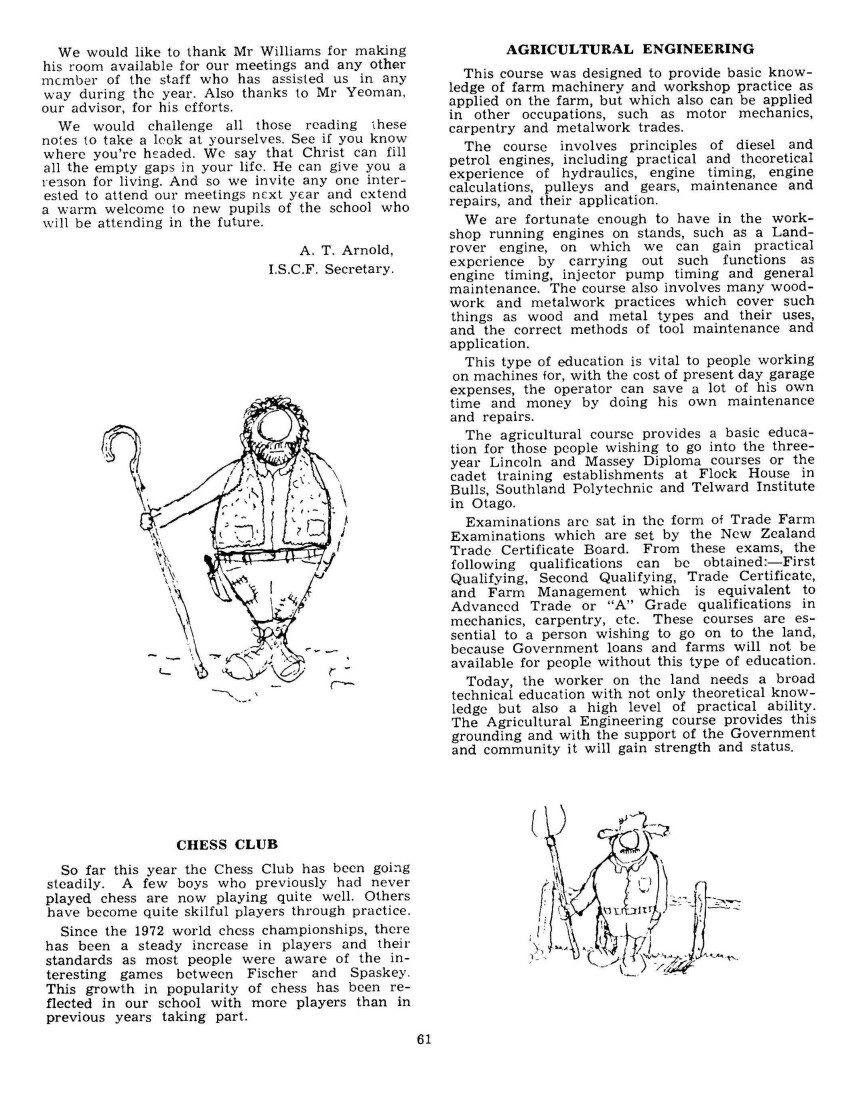
Page 62
EXAMINATION RESULTS
1973
School Certificate Results, 1973: Addis D. F. (1). Agnew J. L. (2), Allen R. V. (1), Anderson P. J. (5), Armstrong P. A. (2), Arnold A. J. (4), Ashton P. D. (4), Atkinson T. (2), August D. M. (5), Baillie S. K. (1), Bakes K. T. A. (2), Bake: M. H. (1), Bartlett J. P. (1), Beaton J. H. (1), Bedford K. M. (2), Bourgeois W. M. (2), Bowley P. W. (2), Breen M. G. (6), Bristow P. (6), Buchanan L. L. (3), Bullock N. I. (4), Burnei G. B. (1), Callam L. R. (2), Callinicos K. S. (6). Callinicos P. J. (1), Cash B. F. (3), Cavanagh W. D. (5), Cave J. E. (2), Chadwick F. R. (2), Challis B. R. (2), Chesterman J. A. (2). Clark R. S. (2), Clarke P. A. (4), Clifton P. C. (3). Collins G. S. (5), Coulson R. D. (2), Cox E. D. (6), Croskery R. J. (2), Cross P. A. (5), Cunningham B. M. (2), Curtain J. F. (1), De La Haye R. E. (1), Duthie G. E. (4), Eastwood G. E. (3), Elliott T. M. (3), Faulknor J. R. (3), Forde P. D. (4), Foulds W. J. (2), Fraser R. S. (3), Gibson C. C. (1), Gillies R. G. (5), Goodall W. R. (4). Gosling P. E. (6), Green M. G. (4), Groom, N. D. (1), Grooves S. J. (2), Gurney S. G. (3), Hail N. J. Hammon J. B. (2), Handley T. C. (1), Hardgrave G. M. (1), Hardgrave S. B. (1), Harris P. J. (2), Heath M. C. (5), Heavey B. G. (3), Hellyer R. I. (5), Hill J. G. (6), Heoson C. W. (2), Hunt B. 7. (3), Jackson R. N. (2). Johnson C. A. (3), Jones K. W. (6), Kempton W. S. (3). Kennedy I. R. (5), Kirby E. K. (2), Kohere I. S. (1), Lamont T. C. (1), Lascelles J
7th FORMERS
Front Row: P. A. McAuley, J. C. McRae, D. A. Whyte, C. A. McLay, S. W. Wentworth, B. L. Gray, K. J. Kelliher, W. D. G. Smith, A. P. Bramley, N. D. Groom.
Middle, 1st Row: J. W. Dufour, R. D. Brinsley, R. P. McTague, P. D. Brown, C. J. Dempsey, M. R. McConnochie, A. P. Gust, C. K. Ong, P. L. Hazell.
Middle 2nd Row: C. D. Lee, P. F. Eastwood, C. P. Riden, R. G. Prebble, R. J. Stancombe, P. C. Fleischl, D. J. Herrick, G. A. McDonald, R. W. Double.
Back Row: R. D. Pearse, P. J. Caradus, D. W. Thomas, D. J. Fraser, C. J. Sheppard, D. D. Brian, P. R. Mudgway.
Absent: H. D. Kennerley, V. T. Chadwick, M. R. Neal, R. J. Sutherland.
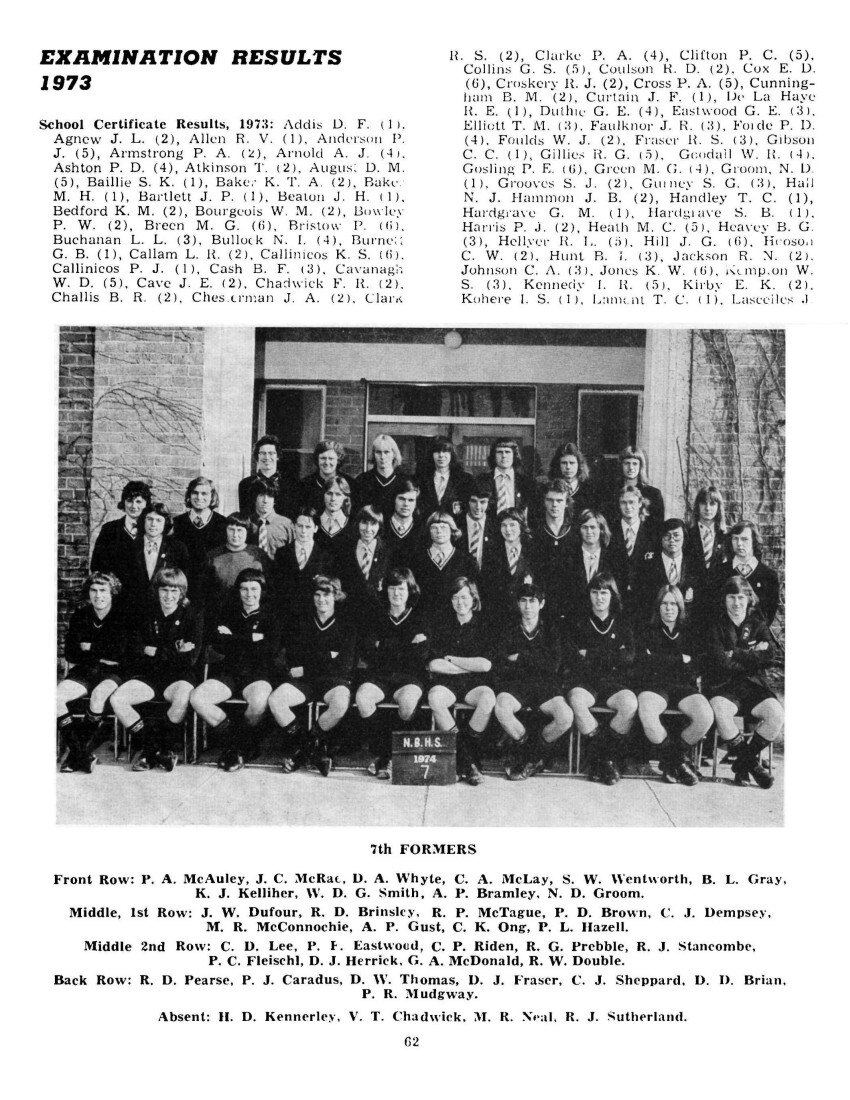
Page 63
E. (2). Laurent P. A. (1), Lawrence A. B. (4). Lee S. P. (4), Lennox A. G. (2), Leslie B. T. (5). Lindsay G. D. (1). Long S. R. (2), Lui P. M. (3). McDonald R. R. (3), McGettigan P. B. (2), McGavan G. (4), McGurk J. R. (2), McLeod K. D. (3). McMeikan A. (1), McMillan R. J. (1), McNaught L. G. (2), Magill J. (3), Magill T. (5). Mannering G. A. (6), Maitson E. (1), Meijer J. H. (6). Millard W. G. (1), Mills A. W. (2), Minikin G. P. (3). Minto A. J. (5). Moore G. W. (5), Muggeridge S. N. (5), Nixon S. B. (1), Northe G. E. (5). Nunn D. A. (5). Okawa S. (2), Oldershaw S. 1. (2), Oliver C. D. (4). Payne P. C. (1), Payne A. W. (2), Parkes D. A. (1). Pidd G. W. (5). Plummer B. (1), Porter M. W. (1). Potts D. R. (1). Prior K. A. (1). Proctor G. F. (4). Radburnd S. P. (3). Rider B. A. (5), Robertson H. G. (4), Robottom D. T. (1). Savery J. M. (2), Scullin M. A. (6). Severinsen G. BR. (2). Shaw G. A. (2). Sheeran B. P. (2), Simmons M. J. (6). Stewart P. J. (1), Stoddart K. R. (2), Stoney D. G. (3). Sutton C. W. D (4). Tamaiva W. 61). Taylor A. D. (3). Taylor K. J. (1). Taylor M. F. (1), Temple D. J. (1). Thomas S. L. (3), Thoresen A. M. (4). Tolley D.S (2). Tong B.D. (1), Torr W. J. (1), Trinick J. M. (4), Walch D. F. (3), Walker J. A. (3), West G. R. (1), Westbury J. G. (1), White G. B. (6). White N. R. (2), Whittleston M. (G), Williams P. F. (2), Williams R. D. (1), Willis S. J. (2), Winchester W. G. (1), Yeo C. S. (1), Bannister S. M. (5).
U.E. Passes: T. Anderson, D. Bellany, A. Branley, D. Brian, R. Brinsley, P. Caradus. M. Coates. C. Dempsey. L. des Landes, R. Double, J. DuFour, M. Fisher, P. Fleischl, D. Fraser, B. Gray, N. Groom, A. Guest, W. Harris, P. Hazell, D. Herrick, K. Kelliher, H. Kennerley, G. Lawrence, C. Les, G. MacDonald, P. Magill, H. Matunga, P. McAuley. M. McConnichie [McConnochie], C. McLay. G. McRae, I. McRae, R. McTague, G. Metcalfe, D. Mudgway. M. Neil, R. O’Brian. R. Pearse. R. Prebble, C. Riden. L. Sheppard, W. Smith. J. Stacey, R. Stancombe. D. Thomas, S. Wentworth, D. Whyte, M. Woods.
University Bursaries: A Bursaries: W. Arlidge, B. Arnold. S. Bickerstaff, P. Brian. B. Carpenter. I. Carpenter, A. Green, R. Karn, D. Mitchell, S. Moir, R. Saver. M. White.
B Bursaries: G. Burge, P. Davis. N. Edginton, R. Hale. R. Hannon. B. Heath, P. Tim, P. Smith
SCINDE HOUSE PREFECTS
Back Row: C. McLay, J. Goringe.
Front Row: S. Muggeridge, D. Muggeridge (Head), S. Borrie (Deputy Head), G. Laurence.
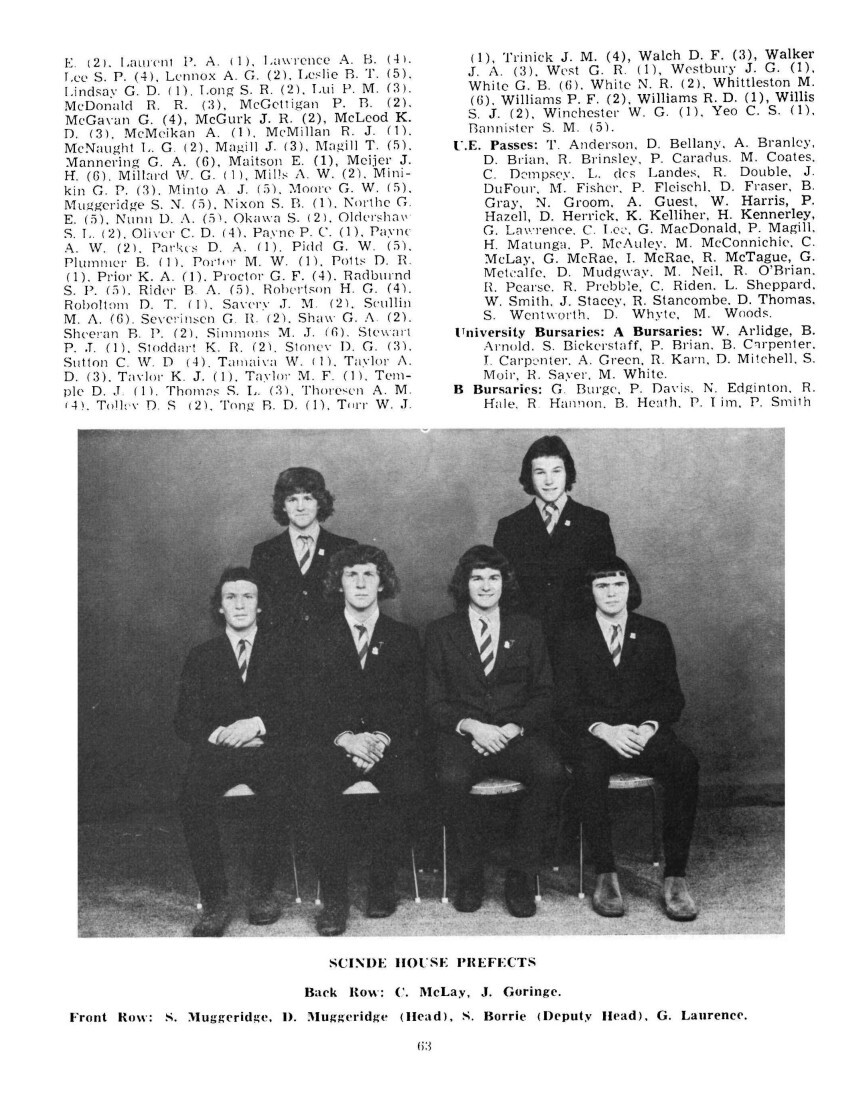
Page 64
SCHOOL ROLL 1974
*Indicates left during the year.
FORM 7: Dean – Mr McCaw; Anderson T. D., Bramley A. P., Brian D. D., Brinsley R. D., Brown P. D. Caradus P. J., Chadwick V. T., Dempsey C. J., Double R. W., Du Four J. W., Eastwood P. F., Fleischl P. C., Fraser D. J., Gray B. L., Groom N. D, Guest A. P., Hazell P. L., Herrick D. J., Kelliher K. J., Kennerley H. D., Lawrence G. D., Lee C. D., McAuley P. A., McConnochie M. R., McDonald G. A., McLay C. A., *McRae I. C., McTague R. P., Mudgway D. R., Neal M. R., O’Brien R. L., Ong C. K., Pearse R. D., Prebble R. G., Riden C. P., Sheppard L. J., Smith W. D. G., Stancombe R. J., Sutherland R. J., Thomas D. W., Wentworth S. W., Whyte D. A.
FORM 6A: Dean – Mr Brown; Form Tutor Mr Seaton; Bannister S. M., Bristow P., Callinicos K.S., *Cash B. F., Collins G. S., Cox E. D., Cross P. A. J., Green M. G., Heath M. C., Heavey B. G. Hellyer R. L., Hill J. G., Kennedy I. R., Leslie B. T., *Magill T., Mannering G. A., Muggeridge S. N., Okawa S., Riden B. A., *Scullin M. A., Simmons M. J., *Trinick J. M., White G. B., Whittleston M., Ito Y.
FORM 6B: Form Tutor – Miss Schon; Allen R. V., Baker M. H., Beaton J., Bird D. G., Borrie S. J., *Brown D., Brown N. H., Callinicos P. J., Cormack P. A., Danks R. B., Fisher B. P., Foote T. H., Gorringe J. R., Kenah L. J., Kohere I. S., Lafferty L. P. F., *Lamont T. C., Lindsay G. D., MacErlich C. A., *McMeikan R. T., Marsden J. F., Muggeridge D. J., Murphy M. J., Pearson D. W., Smith N. W., Stoney D. G., Wallis S. J.
FORM 6C: Form Tutor – Mr O’Connor; *August D. M., Dowley P. W., Breen M. G., Buchanan L. L., Cavanagh W. D., *Chiu K. H., Clifton P. C., *De La Haye R. E., Fitzgerald R W., Forde F. D., Gillies R. G., *Goodall W., Gosling P. E., *Groves S. J., Jones K. W., Lascelles J. E., Minto A. J., Moore G. W., Northe G. E., *Nunn D. A., Pidd G. W., Proctor G. F., Radburnd S. P., Severinsen G. R., Taylor A. D., Thomas S. L.
FORM 6D: Form Tutor – Mr Howlett; Arnold A. J., Atkinson T., Bourgeois W. M., Bullock N. L., Challis B. R., *Chesterman J. A., *Clark R. S., *Duthie G. E., *Eastwood G. E., Faulknor J. R., Fraser R. S, *Gillespie J. E., Hall N. J., Hunt B. L., Kempton W. S., McDonald R. R., McGurk J. R., *McLeod K. P., *McNaught L. G., Millard W. G., Sutton C. W. O., Taylor K. I., Tolley D. S., *Williams P. F.
FORM 5A: Dean – Mr Nicol; Form Tutor Mr Revell; Arnold A. T., *Aylward M. S., Bull P. J., Catley P., Clark T. R., Coker M. B., Cooper G. D., Cotterell R. J., Dockary A. T., Double A. J., Farquhar A. R., Gempton B. J., Hatfield A. R., Hiha H. S., Johnstone K. L., Loughlin J. J, Lynch M. R., McLennan G. W., Melbourne M., Percival B. S., Rolls W. R., *Shone M. A., Walker B. C., Whiteman B. N., Woodhouse S. O., *Damange S., Skinner J.
FORM 5B: Form Tutor – Mr Page; Buckendahl K. D., Chandler C. A., Cheer K. R., *Clarkson S. R., Davidson B. F., Eddy A. R., Falcon T. G., Hagen P. J., Hansson G. J., Hoy R. A., Jones C. D., Kelsen C. S., Kersey G. A., Leary M. A., McIntyre W. D., McIvor R. M., *MacKenzie R. W., McKenzie G. J., *McKie S. I., Mills S. G., O’Leary N. P., Ruru R., Scott G. A., *Stoney M. A.
FORM 5C: Form Tutor – Mr Williams; Adams G. P., Allen M., Andersen J. H., Baker H. C., Cave L. R., Clements G. T., Coates M. J., Costello A. G., Cowley A. J., Green R. A., Hallett T. J., Harrison C. T., Houston M, Jimmieson R., Kelliher P. D., McGirr G. F., Martin R. C,. Pell S. N., Perry M. J., Reid S. W., Reynolds R. J., Sayer I C., Schroder G. W., Symons J. G., Yeomen T. J., Parker D. W., Earnshaw N. A.
FORM 5D: Form Tutor – Mr Fry; Allan G. M., Andrews K. C., Ansell K. D., Ball M. P., Barker S. J., Barrett G. L., Barron B. G., Bell B. J., Bell G. C., Cadman M. J., Coyle J. P., Elliott S. E., Fidanis N. C., Fox S. T., *Laurent R J., Lawlor D. C., Lee B. R., *McGhie C. W., MacMillan C. K., Mist W. D., *Pickup S., Reardon T. J. K., Reeves P. J. R., Rogers R. A., Steele W. P., Tester M. A, Temple H. P., Wright C. A., Hoskins R.
FORM 5E: Form Tutor – Mr Gourley; Anthony G. D., Bartholomew P. S., *Brady M. G, Buhre A., Bullock R. E., *Clark R. P., Claudatos A.V., *Coulter P., Crabtree S. T., Dennis A. B., Fraser K. L., *Green S. G., Higgs N. O., Hoy M. A., McCutcheon P. I., McKay N. M. F., Nielson J. A., Prebble M. R., Street A. C., Stuart R. D., Tawhai R., Westbury I. G., Williams E. J., Young A, *Atkinson K., *Christofferson L. L., *Grant R., *Kyle G. P, *Renata C.
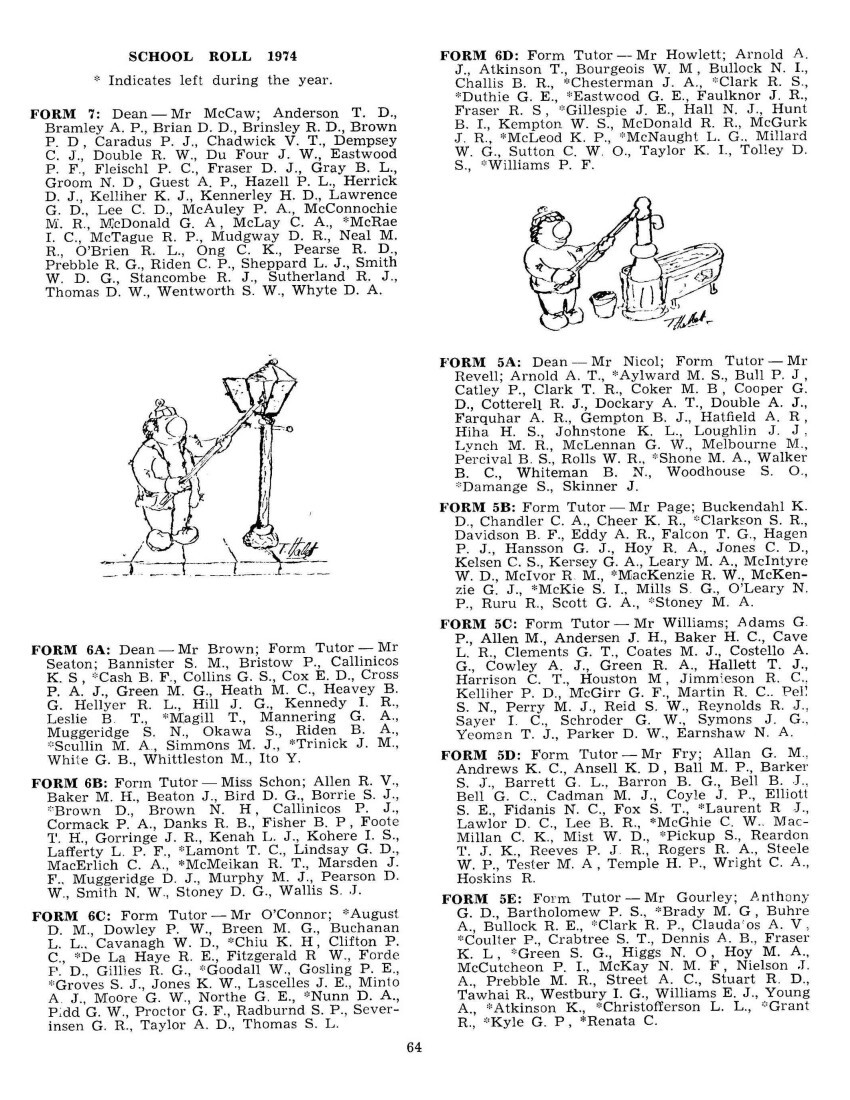
Page 65
FORM 5F: Form Tutor – Mr Hutchinson; Armitage P. J., Brown E., Chaffey D. C., Chong P., Connolly S. R., Cottle G., Derwin R. S., Dooney D. E. Flett P. G., *Heale T. J., *Hellyer K. D., *Hurinui A. N., Ironside M. E., *Johnstone D. J. Kemp G., *Kitt S. F., Knight P. L., McMillan P. M., Marriott Q. J., *Pollett J. B., *Page T. E., Ross N. B., Scott N. W. R., *Shaw P., Turvey B. S., Wilson J. D.
FORM 5AG: Form Tutor – Mr McIntosh; Aplin R. J., Aranui T., Cooper M. G., Devine M. J., *Dobbs T. J., Gardner R. H., Hall M. G., Halse B. N., Hanley P. A., Hartree W. W., Kemp G. R., McCormick B. D., McLeod C. E. L., Nilsson A. R., *O’Neill P. A, Philpott N. L., Ries L. A., Smith A.W. J., Smith C.F., Strawbridge A. N., Tahau H. T., *Trow G. R.
FORM 5R: Form – Tutor Mr Curham; Addis D. F., Agnew J. L., Bedford K. M., Bloor P. J., *Burgess B. C., Chadwick F. R., Cook C. J., Gardiner P. H., Handley T. C., Harris P. J., Hollywood G., Kellett M. J., Lennox A. G., *McMeikan A., Miller M. W., Nixon S. B., *Parkes D. A., Paget S. D., Polly N. J., Prior K. A., *Savery. J. M., *Sheeran B. P., *Torr W. J., West G. R., Williams R. D.
FORM 5S: Form Tutor – Mr Berry; Anderson M. W., Baker K. T., Bicknell M. J., Blundell R. P., Bradshaw A. G., Coates K. J., Cornwall A. E., Cowen J. R., Gilvray G. E., Godwin J. R., Hawkins S. J., *Howell M. D., Lister P. D., Oldershaw S. L., Pedersen M. R., *Pettit, Porter M. W., Purcell J. N., Richardson K. J., Robottom D. J., *Spooner E., *Tamaiva – , Thomsen H. A., Walker A. J., Wallis G. P., *Wedd M. S., Workman D. B., Morrell P. D.
FORM 4A: Dean – Mr Smith; Form Tutor Mrs Caird; Andersen M. T., Andrews M. R., Bannister P. J, Bloomer D. J., Bolton M. J., Bowie R. J., Cappie R. C., Chapman K. M., Collins S. M., Cox M. P., Davidson G. J., Fair D. C., Fraser C. C.; Goldsmith G. B., Gurran P. J., Hallgarth G. A., Harper D. S., Harvey D. I., Helliwell M. D., Hellyer D. C., Hunter A., Lum M. E., Melhuish J.R., Morton B., Pearson A. K, Okawa K., Prisk T. J., Sweetapple M. D., Thorburn J. M., Torr R. W., Tozer L. P., *Wang Cheou F., Willink T. W.
FORM 4B: Form Tutor – Mr Beuth; *Brock D. P., *Burrell D. E., *Cannon S., Chen P. S., Christensen N. W., Clark M. S., Collin R., Ferguson K. D., Forde J. L., Forde W. P., Groom L. M., Harrison A. C., Harrison M. J., Harvey N. G., Heays S. H., Hing R. S., Hughes M. Jimmieson L. M., Mohi S., Moroney B. W., Muggeridge B. W., Newton G. J., Nikolaison R. N., Plowman D. R., Richardson A. D., Ricketts G. A., Plowman D. R., Richardson A. D., Ricketts G. A., miss S. C., Smyth R. L, *Warner T., Wiggins T.
FORM 4C: Form Tutor – Mr Aldous; Anderson G. M., Basher S. B., Batten N. C., *Carley M. R., Crosse N. J., Davidson I. B., Davis R. W. E., Hardwick G. M., Hartree S. J., Hogg S., *Holden D. J., Holter P. J., *Hornby I., Howell W. F., Gill A., Jeffares W. T., *Lucas J. W., McDougall P. E, McGurk M. J., Morton T. W., Pedersen L. E., Richardson A. D., Riden S. J., Ropotini E. A., *Slater G. K., Schwalger S. T., Smith D. A., Smith R. J., Stoddart N. D, Strawbridge R. H., Swinbanks P. L., Tahau S. P., Thelwell J. P., Trow D. R., White R. G., Whittle M. A.
FORM 4D: Form Tutor – Mr Ellis, *Allen P., Blue R. B., Callinicos A. J., Cameron R., Comrie S. J., Cunningham M. R., Davidson R. A., Ericksen G. I., *Gestro A. S., Gilvray R. D., Govan K. M., Green B. W., Guerin G. M., Hambleton J., *Harris P., Hill B. J., Hutchinson M. M., Irwin A. M., Kampkes M. P., Lloyd D. M., MacKay A. D., MacKenzie G. R., Minett B. J., Minto S. G., Morris W. R., Muggeridge B. M., Newton R. C., Rayner P., Rofe M. J., Rush M. W., Strickland C. J., Sutton D. W., Trow S. J, Walker S. J., Yeoman R. L.
FORM 4E: Form Tutor – Mr Rankin; Beirne G. J., Betty G, Blackburn G. A., Bridges S. J., Brownlie R. J., Bryan G. P., Danks D. G., Digman M. D. Dunn M. J., Elliott F. H., Glenny P. J., Gordon R. A., Halas C. P., Hardgrave B. R., *Head W. A, Holdsworth W. B., Horomona R., Ironside F. J., *Knowles P. J., Macarthy P. J., McGettigan T. J., McLean D. B., Martin D. A., Monteith T. A., O’Leary M. J., Oliver M. E., Parkes R. M., Pulford N. S., Talmage J. R., Tucker C. M, *Tuki R., Walker G. J., Welsh C. W., Wylie B.
FORM 4F: Form Tutor – Mr Walker; Agnew K. L., Apiata J. R., Bain D., Barker J. F., Bryson A. S., Buglass K. A., Clareburt P. S., *Clayton G. P., *Cook R. J., Evans G. W., Halpin E. B., Holt S. F., *Lawson T., Lister K. P., McLean L. G., *Mackintosh R. P., Mansfield D. R., Prue A. D., Purcell P. W., *Rakete N. R., Ratahi W. E., Renner P. A., *Reay E. W., Ritchie A. R., Rowe B. W., Stack T. E., Strong B. I., Taurima R. T., Willis G. T., Wooster R. P., Young B. G.
FORM 4G: Form Tutor – Mr MacLeod; Andrews A. G., Arnott N. W., Cotter M. W., Durney R. B., *Grant R. B., Kampkes B. W., King M. G., Le Quesne N. R., Moffatt W. P., Morris G. T., *Pewhairangi S., Pomana L., Rahui W., *Ratahi W.E., *Sargent B. V., *Spooner M. J., Strachan J. P., Taunoa P., *Watson J. C., Wills C. P.
FORM 4H: Form Tutor – Mr Monrad; Brown R. T., Buckendahl M. J., Deadman A., *Ferrall S. C., Glenny R. B., Handley M., Julius K. J., Kerley R. C, *Kingi P. W., Lampitt M., Leonard M. E., Northcroft A. T., *Pearce W., *Rakete G., Sapwell J. C., *Shadbolt G. M., Spooner J. M., *Stephens B. L., *Taipiha P. T., Thoresen N., *Towgood R. W., *Te Kahu C., Wright G. J.
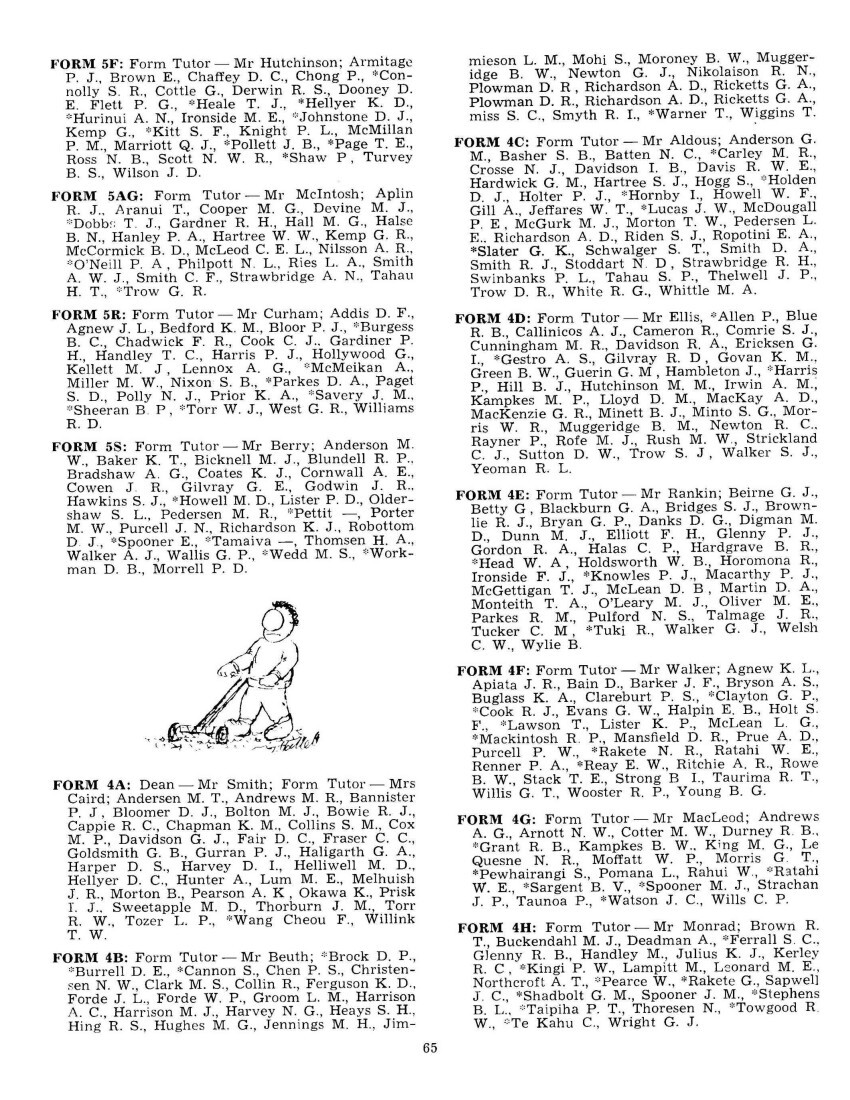
Page 66
FORM 3A: Dean – Mr Sheat; Form Tutor Mrs Sheppard; Bevin D. G., Brown G. A., Cavaney R. G., Cotterill G. J., Cowley D. E., Cranswick R. M., Dage J. C., Darroch R. J., Hall R. K., Hallett M. Hannon P. M., Hard G. J., Hardgrave W. S., Harris J. L., Jackson D. A., *Jackson D. F., Jalibert B., Jensen A. R., Johnstone B. R., Jones M. C., Lynch P., McCarty C. D., McKenna A. C., McKenzie J. D., McKie D. H., McNaught G. J., Mather P. D., Moore B., Racz J. Z., Richardson D., Sutton R. J., Van Ham A. A., Waring C. C., Weir G. I., Willink R. D.
FORM 3B: Form Tutor – Mr Pitts; Allen G. D., Bleach E. A., Brocklehurst G. B., Devine C. D., Dockary B. J., Duffill E. G., Gillon P. M., Groom F. W., Hansen G. B., Hansson J. P., Harper P. H., Hart B. P., Herring R. A. J., Kennedy D. A., Lowe R. J., Ludvigsen R. D., McConnochie G. B., McGirr G A., MacKay H. J., McKinnie M. A., Mannering A. E., Mataira J. W., Munden T. W., Parker G. H., Pickup J. O., Puketapu H. J., Radford K B., Sandtmann G. P., Schdroski R. M., Smith W J., Stuart M. T., Webb M. P. B., Woodward A. L., Yeoman N. J.
FORM 3C: Form Tutor – Mr Mear; Angen M. R., Batchelar D. W., Beere G. J., Brandon P. J., Chambers B. D., Church G. D., Dellow C. B., Dysart W. J., Faloon B. C., Farquhar R. M., Fraser G. T., Gannaway B. C., Gannaway A. D, *Grant A. A., Guild D. J., Gunson A. J., Harris L R., Hollywood R., Hood S. A., Hopper S. G., Kihi A. M., Maulder G. C., Morgan D. L., Mott W. T., Neal P. B., O’Neill S. J., Prince L. G., Quinn P. J., Smith G. G. M., *Stewart C. J., Vanderspeck M. J., Wigmore K. R., Wildermoth D. C., Wilson S. E., Wright K. F.
FORM 3D: Form Tutor – Mr Lister; Crabtree W. M., Curry L. F., Davis D. T, Farrell D. M., *Fisher D. J., Forward A, H., Hagen T. P., Hornby O. G., Joe K. C. , Kirby S. R., Lake K. G., Leask M. T. G., McCabe B. B., McIlroy K. M., Mackintosh G. Marsay S., Mete I. P., Mildon R. W., Nicol M., Noble D. A., Owers B. J., *Pearce S. J., Pedersen K. J., Proctor M. J., Redden S. J., Robinson C. G., Rush R. J., Shakeshaft C. P., Skinner P., *Tapiata G., Taurima D., Thompson S., Walker F. R. V., Willis A. R., Wilson N. G., Zorn J. J.
FORM 3E: Form Tutor – Mr Boyce; Andrews, G. B., Angove D. H., Bradshaw I. R., Brooks G. I, Buckman W. R., Christensen R. B., Church S. R., Clifton J. P. , Coveny M. W., Curle V. W., Graham R. M., Foley R. T., Julian L. C.; Keefe P. T., Le Comte C. L., Loving R. M., *Maricic J. J. McCallum D. H., McLay A. S., Mock T. R., Mogford B. W., Needham S. M., Nilsson K., Phillips T. J., Puhia T., Ramlose B. C., Rarere P. M., Ross D. A., Smith C. E., Taylor W. J, Tester R. I., Tutton C. P., Waaka R. W., Wakefield M., Watt D. A.
FORM 3F: Form Tutor – Mr Stephens; Barrett C. R., Blenkey C. R. Cunningham J. S., Deadman O., *Edwards C. J., *Fenn A., Gestro M. V., Gray A. C., Harvey A. C, Higgins J. P., Kemp C. A. M., Lampitt J. C., Le Geyt A. S., Lewis C. R., Lucas B. D., McGowan D., Meyer R. I., Nicholson G. A., O’Dwyer P.S., Robertson M. T., *Ruhi N., Samuels K. E., Small R. L., Smiley W. J., Spooner W., Stephenson M. J., Taana P. P., Tong K. R., Waitere S. J., Wallace E. P., White D. G, Yates T. J. K., Yeo P. J.
FORM 3G: Form Tutor – Mr Young; August W. G., Bowen P. E.D., Bridges M. D, Bryan D. J., Cairns S. P., Cunningham P. C., Dean R. T., *Gale D. G., Goodin N. P., Grant R. G., Hastie R. J., Hunter I. R., *Lawson T. P., Lowe W. J, Lyndon S.G.M, McDonald H M., *McQuarrie K. C., Olsen I. J., Rangihuna P. W., Salter M. R., Taunoa W. A, Taylor R., *Te Maro H., Wiki R., Wilcox D. H., Wimsett M. R.
FORM 3H: Form Tutor – Mr Paxie; Ashwell G., Beattie W. F., Bell E. K., Bruns R., Bryant P. C., Duncan B. J., Fraser M. F., Hune J., Kingi G., McLean N. L., Marsden D. A. F., Marsters J. D., *Matunga W., Mikara S. H., Moa A. J, Nepata P. E., Paramore D. Lavy *Renata S. K., Robinson W. P. T., *Samuels P. J., Sykes W. P., Tauhara N. H. M., Taunoa A., Tawera J, *Walker S. T., *Wilson B. J., Yelcich G. M., Young P. A.
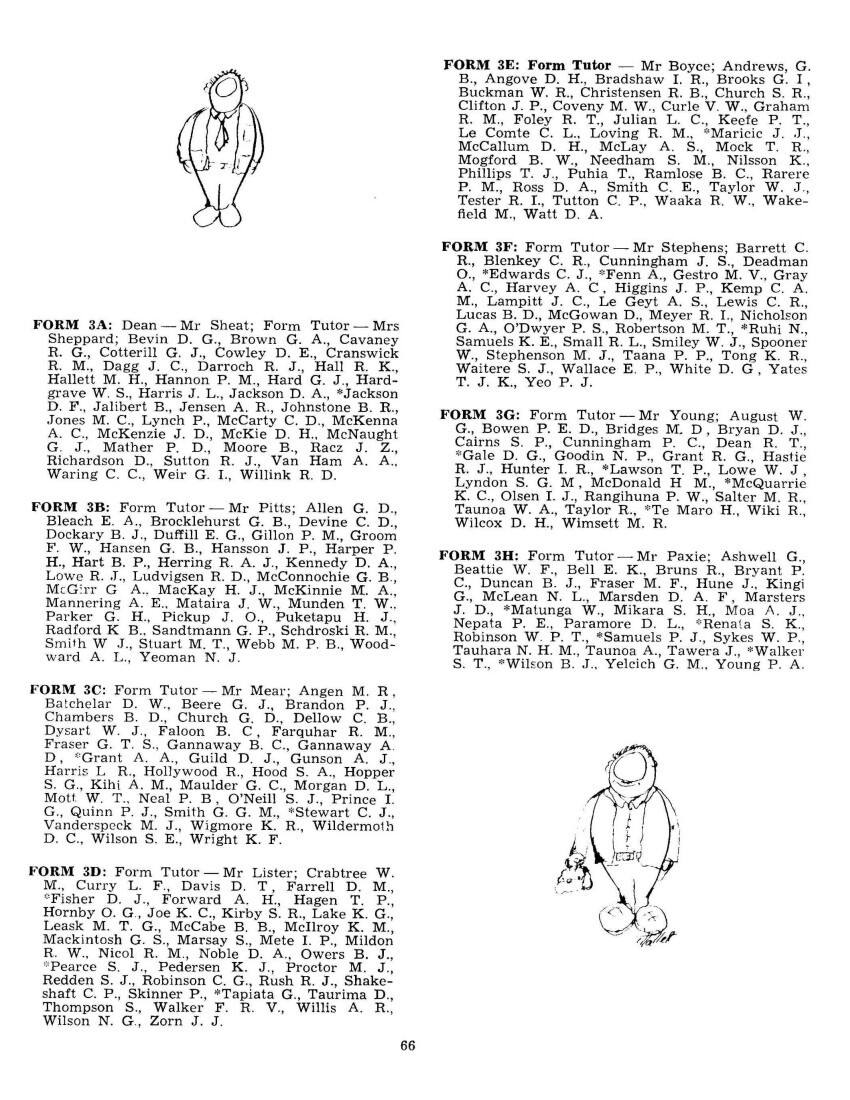
Non-commercial use

This work is licensed under a Attribution-NonCommercial 3.0 New Zealand (CC BY-NC 3.0 NZ).
Commercial Use
Please contact us for information about using this material commercially.Can you help?
The Hawke's Bay Knowledge Bank relies on donations to make this material available. Please consider making a donation towards preserving our local history.
Visit our donations page for more information.
Description
[List of names in this title still to be added – HBKB]

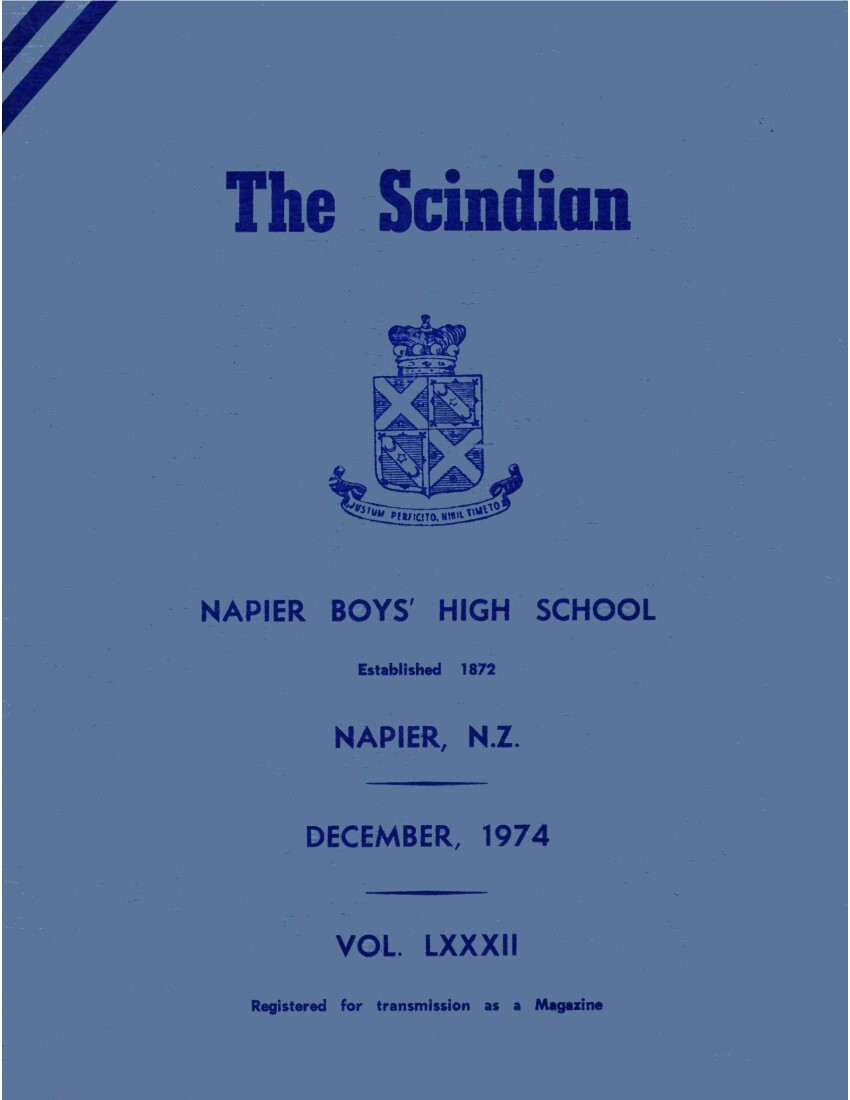
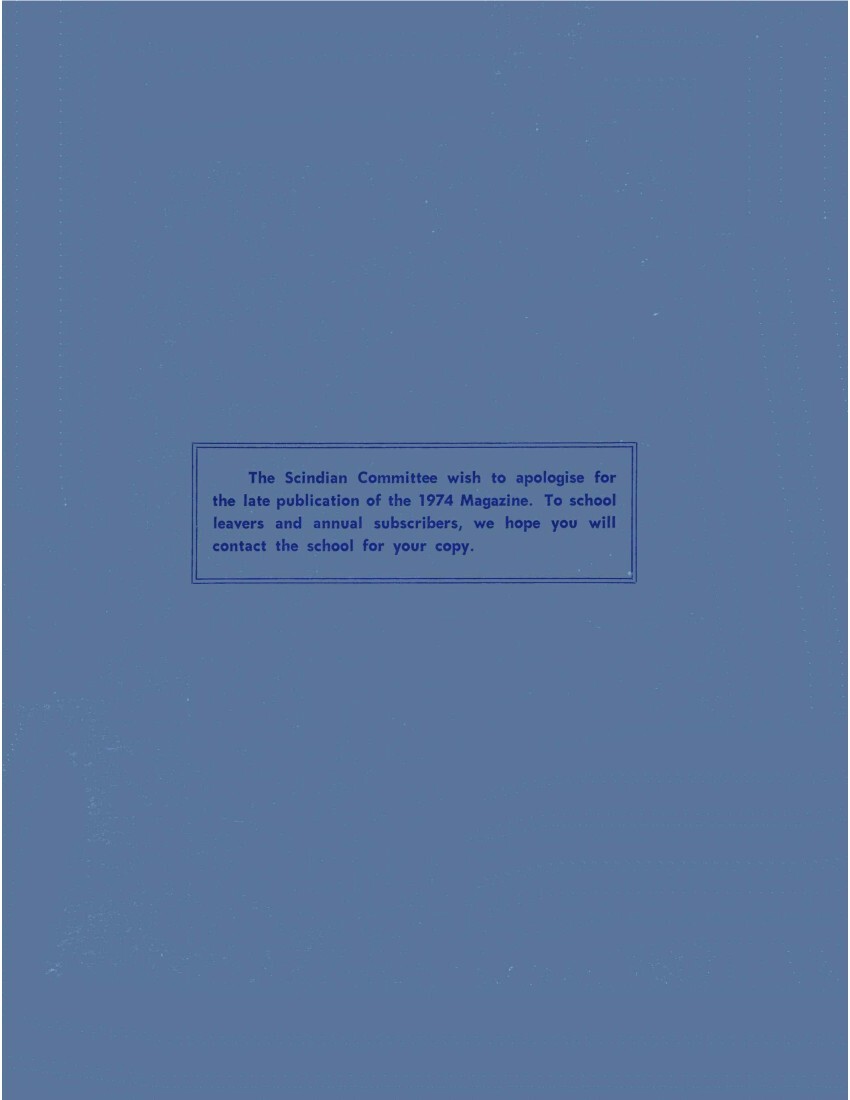
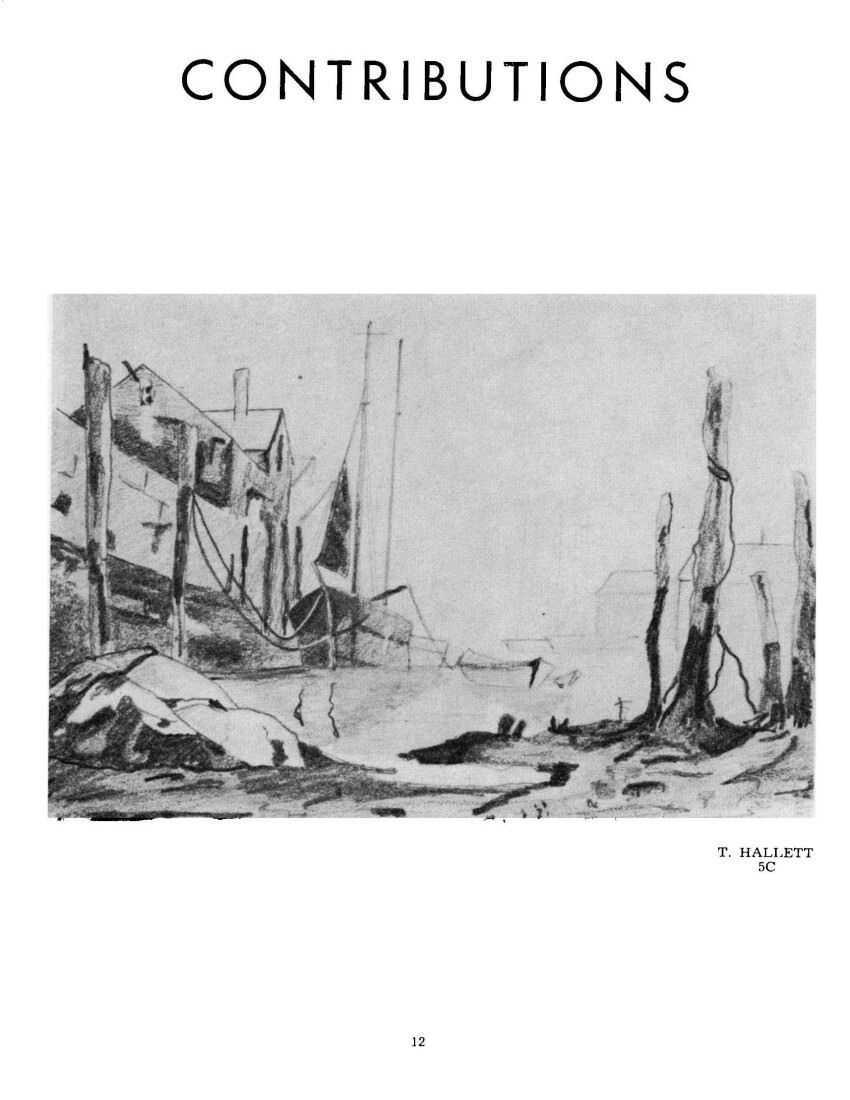

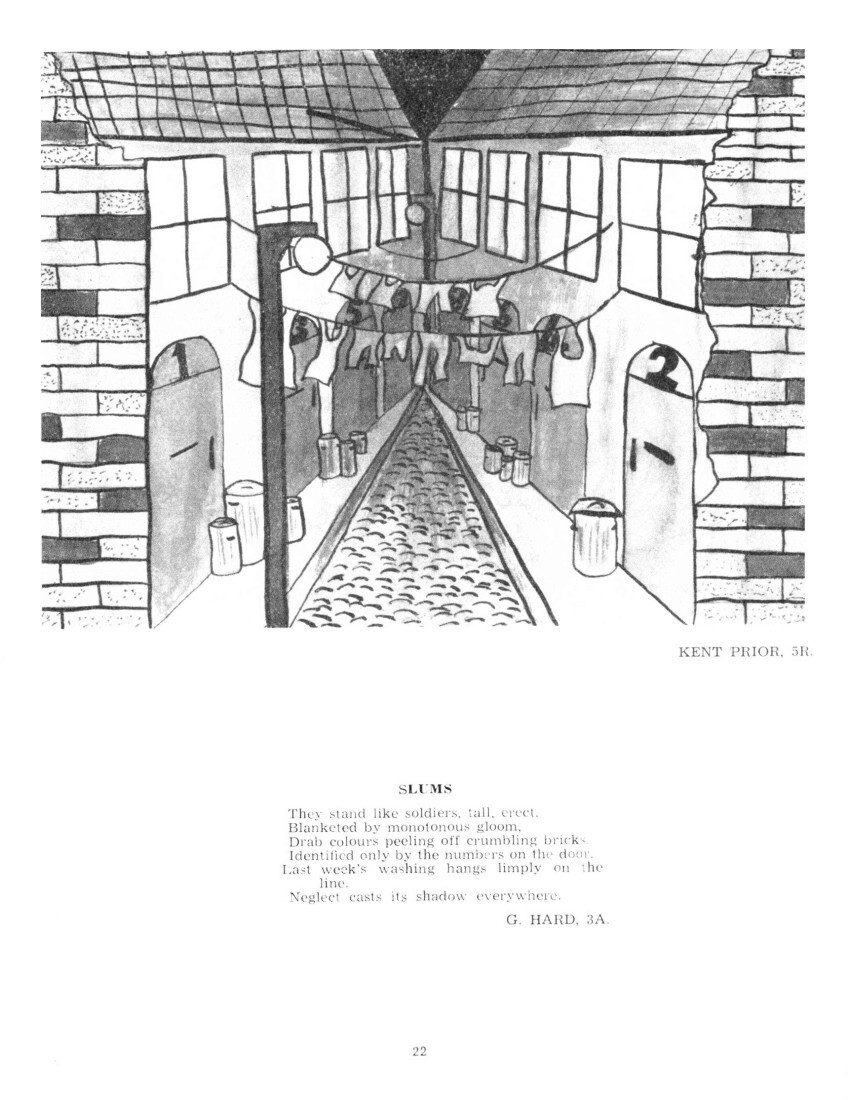
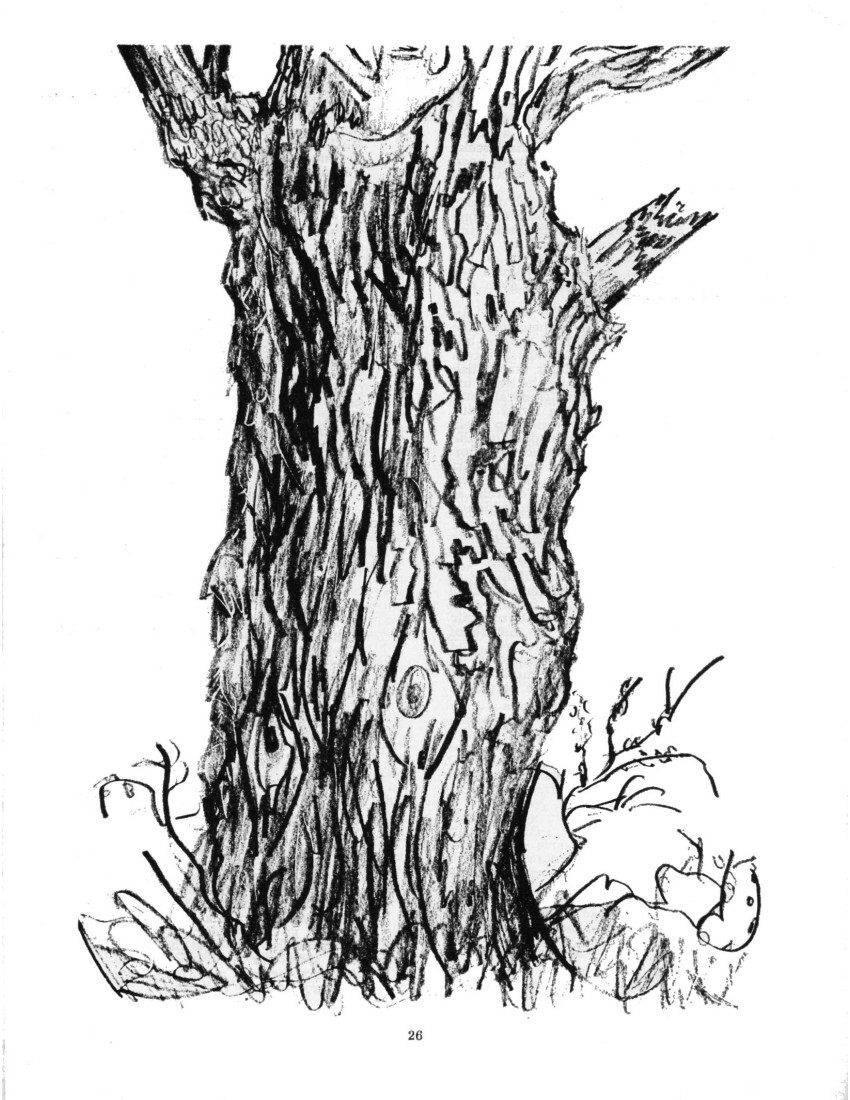
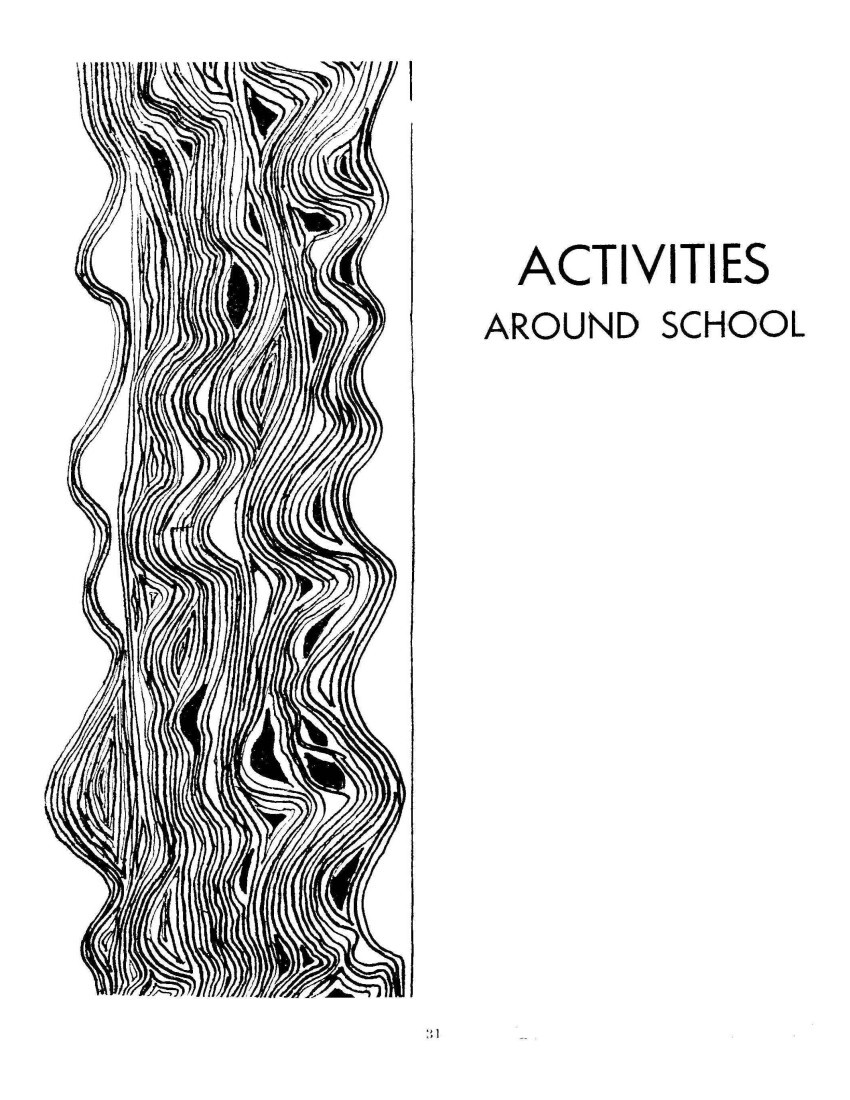
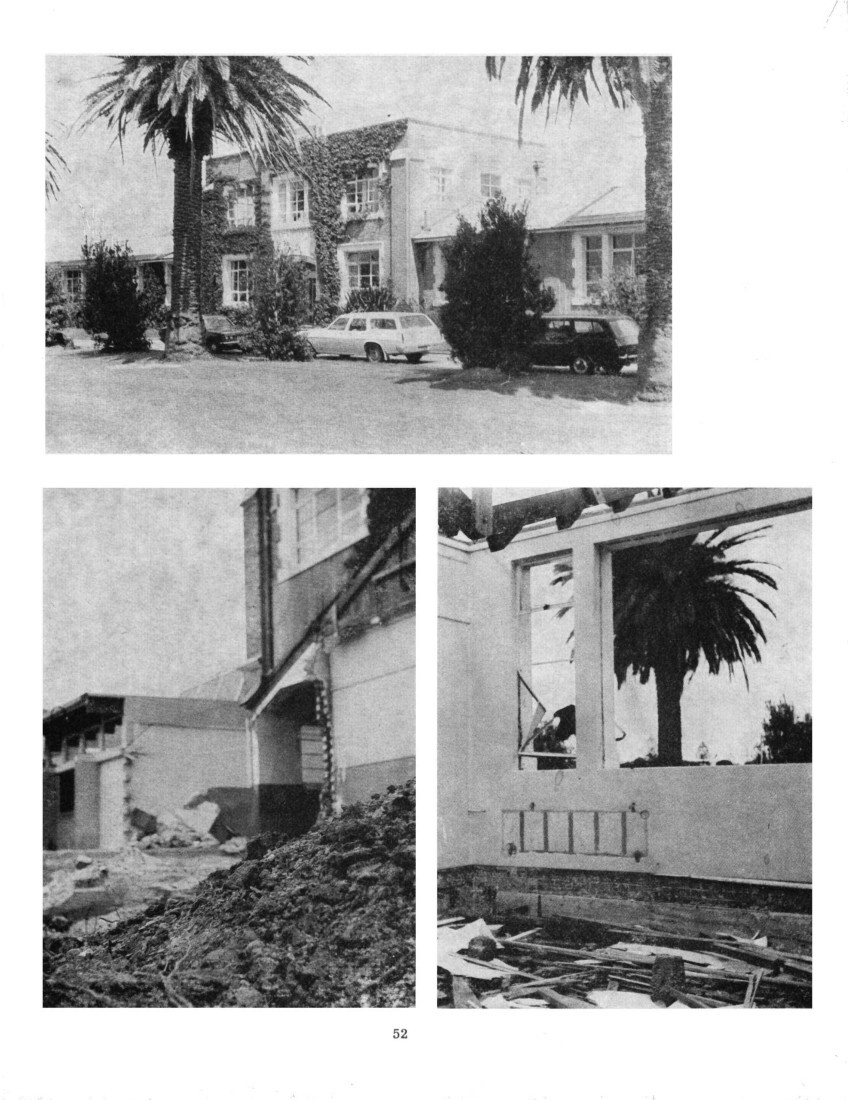
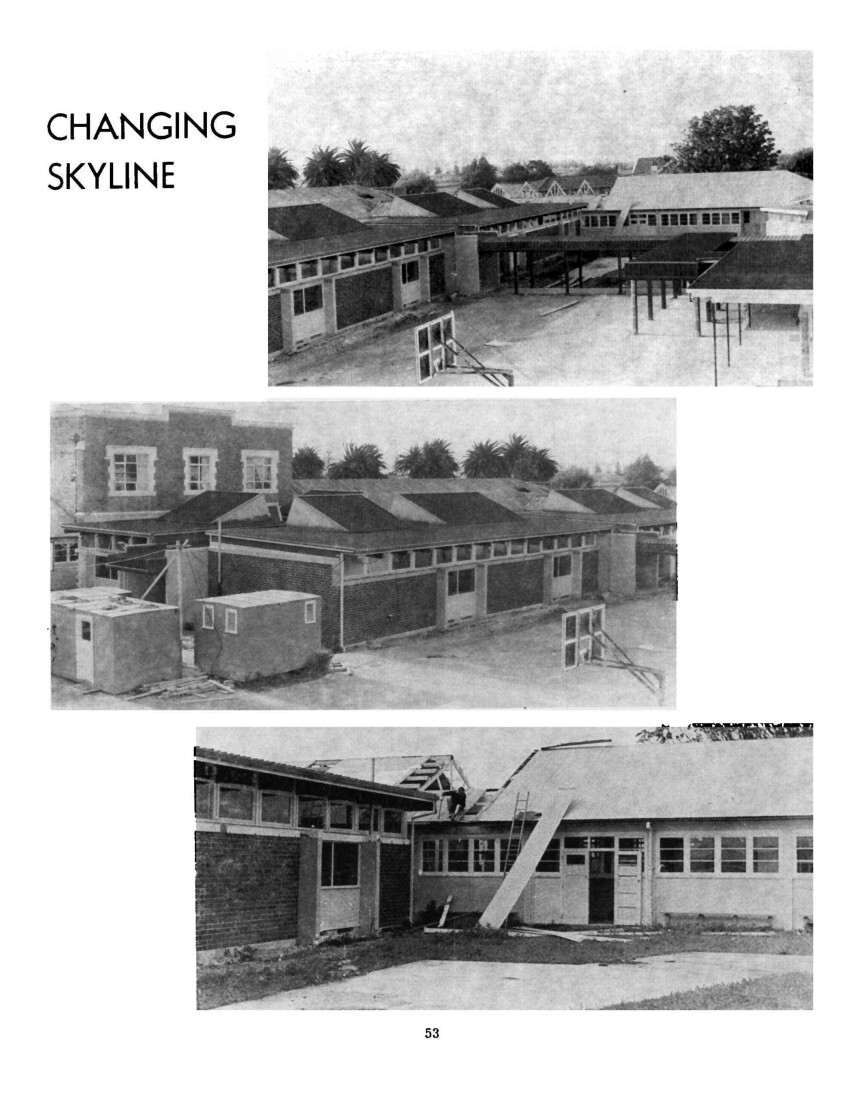











Do you know something about this record?
Please note we cannot verify the accuracy of any information posted by the community.